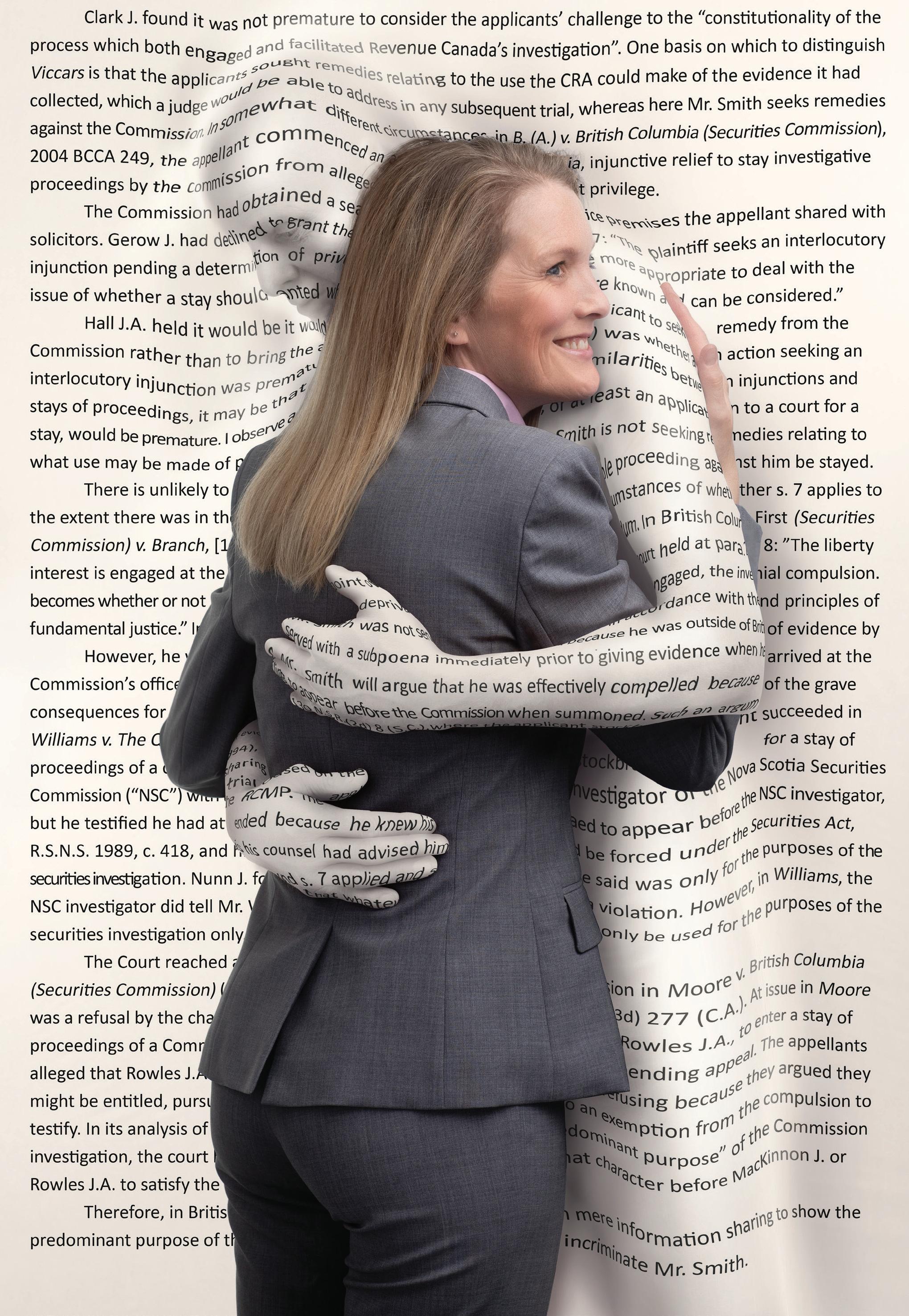ADVOCATE
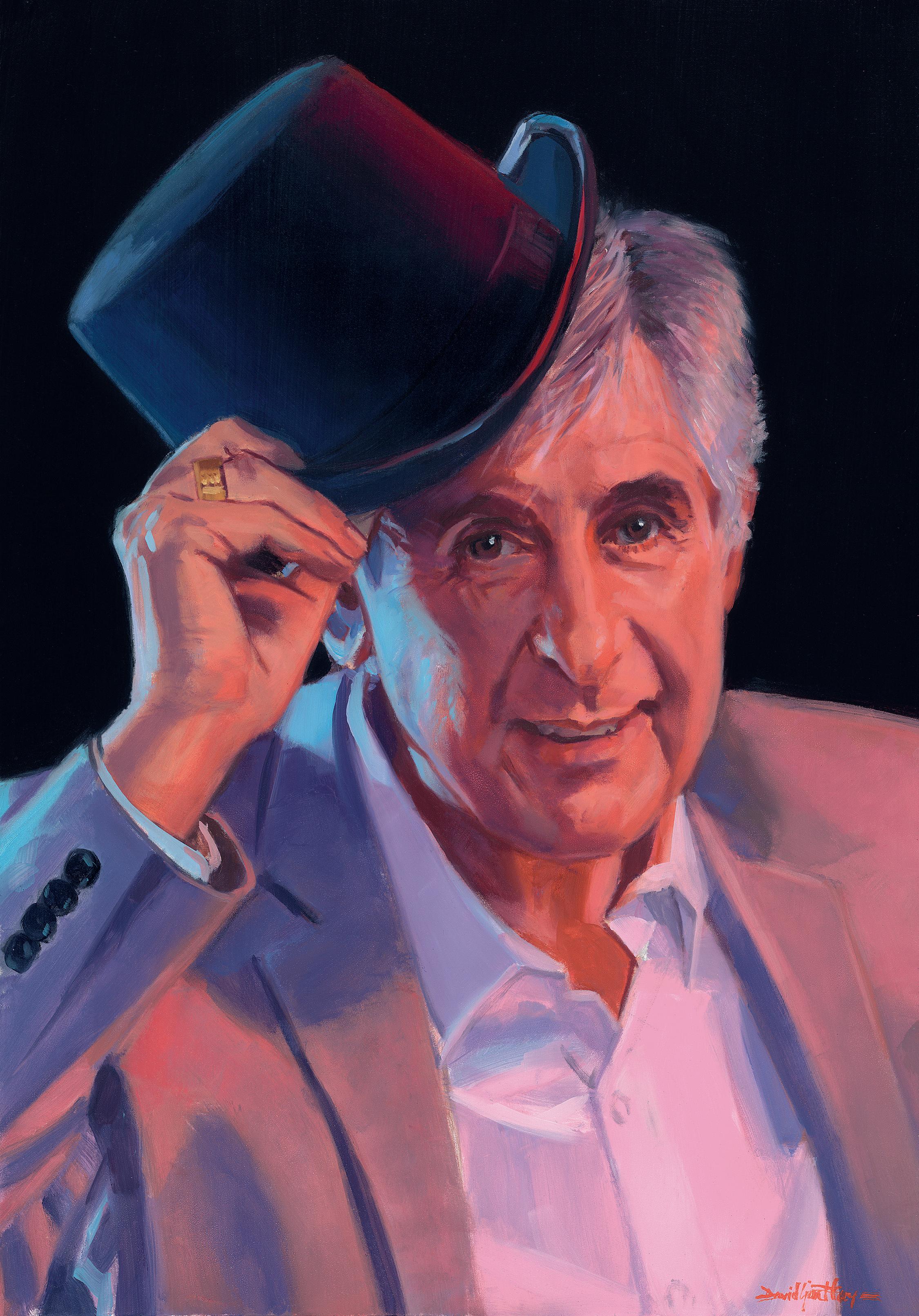





















































































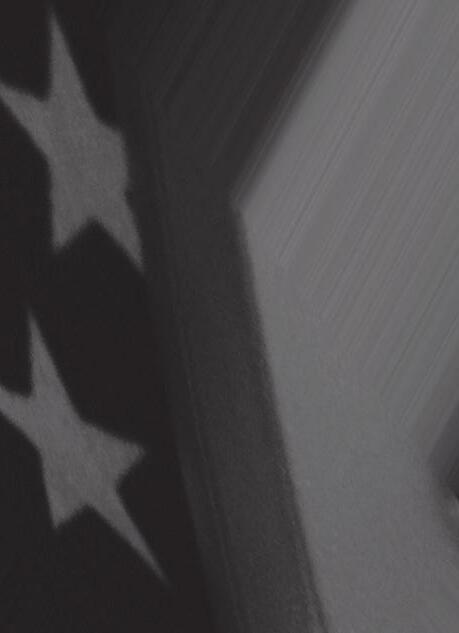











































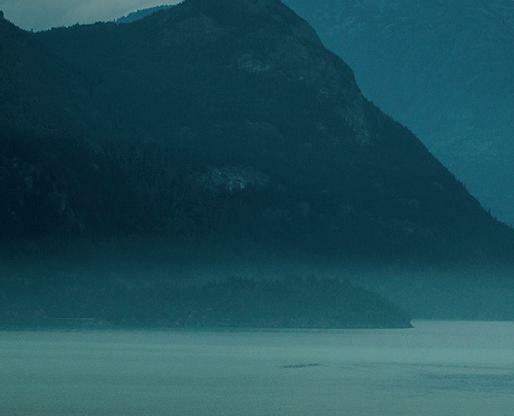



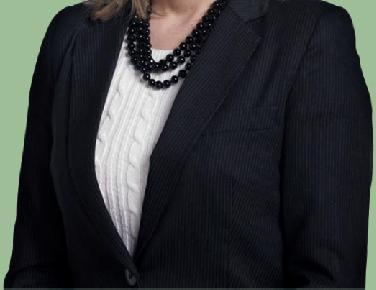
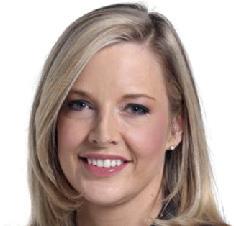
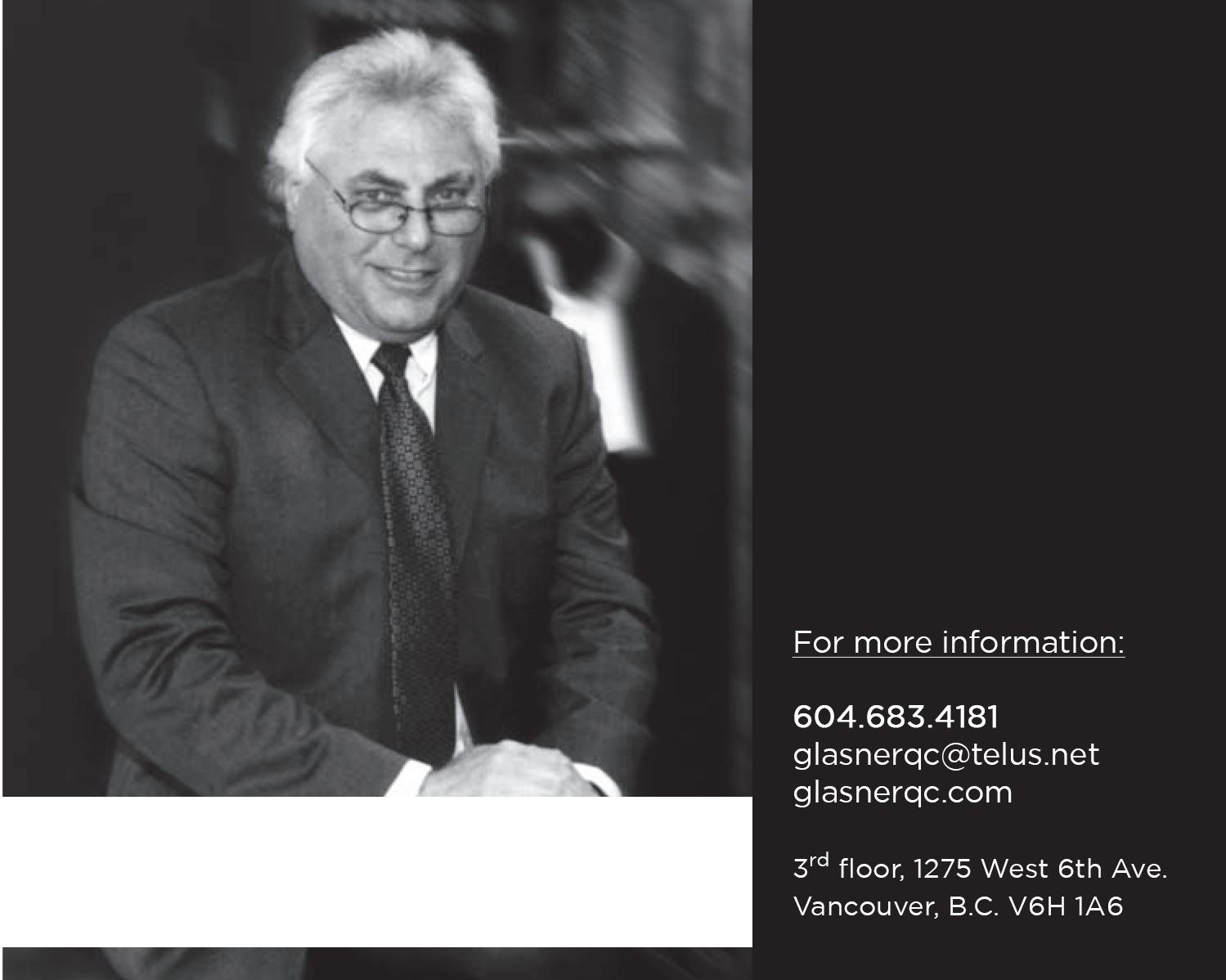


















































































































































LAW SOCIETY OF BRITISH COLUMBIA
Lisa Hamilton, Q.C. President
Christopher McPherson, Q.C. First Vice President
Jeevyn Dhaliwal, Q.C. Second Vice President
Don Avison, Q.C. Chief Executive Officer and Executive Director
Paul A.H. Barnett Sasha Hobbs Dr. Jan Lindsay
Kim Carter Tanya Chamberlain Jennifer Chow, Q.C. Cheryl S. D’Sa Lisa H. Dumbrell Brian Dybwad Brook Greenberg, Q.C. Katrina Harry Lindsay R. LeBlanc Geoffrey McDonald Steven McKoen, Q.C.
Michèle Ross Natasha Tony Guangbin Yan
Jacqueline McQueen, Q.C. Paul Pearson
Georges Rivard Kelly Harvey Russ Gurminder Sandhu Thomas L. Spraggs Barbara Stanley, Q.C. Michael F. Welsh, Q.C. Kevin B. Westell Sarah Westwood Gaynor C. Yeung
BRITISH COLUMBIA BAR ASSOCIATIONS
ABBOTSFORD & DISTRICT Kirsten Tonge, President CAMPBELL RIVER Ryan A. Krasman, President CHILLIWACK & DISTRICT Nicholas Cooper, President
COMOX VALLEY Michael McCubbin Shannon Aldinger
COWICHAN VALLEY Jeff Drozdiak, President
FRASER VALLEY Michael Jones, President KAMLOOPS Kelly Melnyk, President KELOWNA Taylor-Marie Young, President KOOTENAY Dana Romanick, President
NANAIMO CITY Kristin Rongve, President
NANAIMO COUNTY Lisa M. Low, President
NEW WESTMINSTER Mylene de Guzman, President
NORTH FRASER Lyle Perry, President
NORTH SHORE Lesley Midzain, President
PENTICTON Ryu Okayama, President
PORT ALBERNI Christina Proteau, President
PRINCE GEORGE Marie Louise Ahrens, President
PRINCE RUPERT Bryan Crampton, President
QUESNEL Karen Surcess, President SALMON ARM Dennis Zachernuk, President
SOUTH CARIBOO COUNTY Angela Amman, President
SURREY Gordon Kabanuk, President VANCOUVER Executive Jason Newton President Niall Rand Vice President Zachary Rogers Secretary Treasurer Samantha Chang Past President VERNON Christopher Hart, President
VICTORIA
Marlisa H. Martin, President
BRITISH COLUMBIA BRANCH
Aleem S. Bharmal, Q.C. President Scott Morishita First Vice President Lee Nevens Second Vice President Judith Janzen
Finance & Audit Committee Chair Dan Melnick
Young Lawyers Representative
TBD Equality and Diversity Representative Randolph W. Robinson Aboriginal Lawyers Forum Representative Patricia Blair Director at Large Adam Munnings Director at Large Mylene de Guzman Director at Large Sarah Klinger Director at Large
CARIBOO Nathan Bauder Susan Grattan Nicholas Maviglia
KOOTENAY Andrew Bird Christopher Trudeau
NANAIMO Johanna Berry Patricia Blair Kevin Simonett
PRINCE RUPERT Sara Hopkins VANCOUVER Kyle Bienvenu Karey Brooks Joseph Cuenca Bahareh Danael Graham Hardy
Lisa Jean Helps Judith Janzen Heather Mathison Scott Morishita
VICTORIA Sarah Klinger Dan Melnick Paul Pearson
WESTMINSTER Anouk Crawford Mylene De Guzman Daniel Moseley Greg Palm
Rachel LaGroix Michael Sinclair Kylie Walman
CANADIAN ASSOCIATION OF BLACK LAWYERS (B.C.)
Zahra Jimale, President
FEDERATION OF ASIAN CANADIAN LAWYERS (B.C.)
Hasan Alum, President INDIGENOUS BAR ASSOCIATION (B.C.)
Michael McDonald, President
SOUTH ASIAN BAR ASSOCIATION OF BRITISH COLUMBIA Rupinder Gosal, President
ASSOCIATION DES JURISTES D’EXPRESSION FRANÇAISE DE LA COLOMBIE-BRITANNIQUE (AJEFCB)
Sandra Mandanici, President
THE
“Of interest to the lawyer and in the lawyer’s interest”
Published six times each year by the Vancouver Bar Association
Established 1943 ISSN 0044-6416 GST Registration #R123041899 Annual Subscription Rate $36.75 per year (includes GST)
Out-of-Country Subscription Rate $42 per year (includes GST)
Audited Financial Statements Available to Members
EDITOR: D. Michael Bain, Q.C.
ASSISTANT EDITOR: Ludmila B. Herbst, Q.C.
EDITORIAL ADVISORY BOARD: Anne Giardini, O.C., O.B.C., Q.C. Christopher Harvey, Q.C. Carolyn MacDonald David Roberts, Q.C. Peter J. Roberts, Q.C. The Honourable Mary Saunders The Honourable Alexander Wolf
CONTRIBUTING EDITORS: Samantha Chang Peter J. Roberts, Q.C. The Honourable Jon Sigurdson BUSINESS MANAGER: Lynda Roberts
COVER ARTIST: David Goatley COPY EDITOR: Connor Bildfell
EDITORIAL OFFICE: #1918 – 1030 West Georgia Street Vancouver, B.C. V6E 2Y3 Telephone: 604-696-6120 E-mail: <mbain@the-advocate.ca>
BUSINESS & ADVERTISING OFFICE: 709 – 1489 Marine Drive West Vancouver, B.C. V7T 1B8 Telephone: 604-987-7177
E-mail: <info@the-advocate.ca>
WEBSITE: <www.the-advocate.ca>
Entre Nous . . . . . . . . . . . . . . . . . . . . . . . . . . . . . . . . . . . . . . . . . 649
On the Front Cover: Perry Ehrlich
By D. Michael Bain, Q.C. . . . . . . . . . . . . . . . . . . . . . . . . . 655
Ukraine and the Unfinished Crime of Aggression By Jeffrey J. Smith . . . . . . . . . . . . . . . . . . . . . . . . . . . . . . . 661
The Canadian Legal Genealogy of Terra Nullius – Sub Nom.: Is It Too Late to Send Terra Nullius Back to Australia (and Would They Even Take It)? Part I By Sarah Pike . . . . . . . . . . . . . . . . . . . . . . . . . . . . . . . . . . 671
The Litigator and Mental Health By the Honourable George R. Strathy . . . . . . . . . . . . . . . . . 681
Blockchain for Bloodfeuds By Eric Kroshus . . . . . . . . . . . . . . . . . . . . . . . . . . . . . . . . 697
The Wine Column . . . . . . . . . . . . . . . . . . . . . . . . . . . . . . . . . . . 703
News from BC Law Institute . . . . . . . . . . . . . . . . . . . . . . . . . . . 713
LAP Notes . . . . . . . . . . . . . . . . . . . . . . . . . . . . . . . . . . . . . . . . . 717
A View from the Centre . . . . . . . . . . . . . . . . . . . . . . . . . . . . . . 719 Announcing the 2023 Advocate Short Fiction Competition . . . 723 Peter A. Allard School of Law Faculty News . . . . . . . . . . . . . . . 725
TRU Law Faculty News . . . . . . . . . . . . . . . . . . . . . . . . . . . . . . . 727
Nos Disparus . . . . . . . . . . . . . . . . . . . . . . . . . . . . . . . . . . . . . . . 731
New Judges . . . . . . . . . . . . . . . . . . . . . . . . . . . . . . . . . . . . . . . . 745
New Master . . . . . . . . . . . . . . . . . . . . . . . . . . . . . . . . . . . . . . . . 761
Letters to the Editor . . . . . . . . . . . . . . . . . . . . . . . . . . . . . . . . . 765
Classified . . . . . . . . . . . . . . . . . . . . . . . . . . . . . . . . . . . . . . . . . . 769
Legal Anecdotes and Miscellanea . . . . . . . . . . . . . . . . . . . . . . . 771
From Our Back Pages . . . . . . . . . . . . . . . . . . . . . . . . . . . . . . . . 779
Bench and Bar . . . . . . . . . . . . . . . . . . . . . . . . . . . . . . . . . . . . . . 783 Contributors . . . . . . . . . . . . . . . . . . . . . . . . . . . . . . . . . . . . . . . 799
With a tip of his hat, Richmond’s very own Perry Ehrlich graces this month’s front cover. Find out about how this Yorkton, Saskatchewan kid came to Lulu Island and became not only an impressive solicitor but also a showstopping impresario!
firm ofconsulting economists


litigation

following services
area
This long-standing Notary Public firm (with staff Notary) provides the notarization of many documents, conveyancing of real estate transactions, the preparation of personal planning documents such as Wills, enduring Power of Attorneys, etc. The office also provides executor services for estates as either full executor, or partial executor, or by way of a joint executor. A purchaser can take advantage of approx. 200 Will files, where the current Notary Public is named as Executor or Co-executor with the rights to assign that role. These files are anticipated to provide significant future billings.


The staff Notary supports current business demands across all practice areas. As well, with the established conveyancing and administration services team, the business is well-positioned for further growth and development within the metro Vancouver marketplace.













































I had three discussions with the President that I can recall … and … I made it clear I did not agree with the idea of saying the election was stolen and putting out this stuff which I told the President was bullshit. … You can’t live in a world where the incumbent administration stays in power based on its view unsupported by specific evidence that there was fraud in the election.
—William S. Barr, former attorney general of the United StatesWhen William Barr testified before the select committee charged with investigating the January 6, 2021 attack on the U.S. Capitol,1 he did not mince words. The fact that he had to resort to profanity is entirely forgivable. We use profanity either when we do not personally have the vocabulary to express ourselves, or when there simply are no words that exist to adequately describe a situation. Barr called Trump’s ridiculous positioning about a “rigged” and “fraudulent” election—a perverse attempt to remain in the White House— exactly what it was: bullshit. He called it a number of other things too (maybe there was vocabulary for it after all) including “completely bullshit,” “absolute rubbish,” “idiotic,” “bogus,” “stupid,” “crazy,” “crazy stuff,” “complete nonsense,” and “a great disservice to the country.”
Barr was merely saying what anyone with even a modicum of knowledge about democracy and how democracy ought to work has been thinking for years now. It was strange, however, to hear it coming from a man who so regularly backed up the former president when he took other audacious and ridiculous positions. If The Washington Post is to be believed, it racked
up more than 30,000 false or misleading statements made by Donald Trump during his presidency. The attorney general was not exactly rushing to correct the record in every instance. While it is perhaps telling that Barr’s memoir is titled One Damn Thing After Another, it is troubling that whereas he testified that the “bullshit” was one of the reasons he decided to resign, his resignation letter makes no reference to it. Instead, he praised the president for the “unprecedented achievements you have delivered for the American people”.
The more important part of Barr’s testimony quoted above, though, is the part that talks about the inability to live in a world where positions unsupported by evidence hold any sway whatsoever. As members of the legal profession, do any of us need to be convinced of this fact? Together with scientists (and the professions science informs), lawyers are among those usually completely obsessed with the notion that evidence is necessary to support, advance and sustain a position. Judges rely on experts to opine on matters outside of the judicial area of knowledge, so that an informed and principled decision can be made, but they will not permit an expert to merely opine without an evidentiary foundation. Our entire system of criminal and civil justice is dependent upon reason, intellect, wisdom and, above all, evidence. Indeed, we have entire courses and textbooks dedicated to the law of evidence.
Evidence, and the ability to synthesize it, scrutinize it, analyze it and accept or reject it, are at the very core of almost every analysis a lawyer does. Why, then, does it seem to go out the window when people talk about emotionally charged topics or political viewpoints? It would be easy enough to wade into one or more of the controversial topics plaguing the legal profession at the moment, but for fear of these thoughts getting lost in the topic itself and someone entirely missing the point, let us turn to something not exactly disputed any more: the complete lack of evidence of weapons of mass destruction used to justify the U.S. invasion of Iraq in 2003.
Those of us who watched the build-up to that war (unless we were walking around draped in flags or perhaps holding shares in a company that manufactures bombs) were fairly skeptical about the claimed justifications for that war. The stated intent to “disarm Iraq of weapons of mass destruction, to end Saddam Hussein’s support for terrorism, and to free the Iraqi people” seemed to lack only one thing: evidence. If you are going to claim that a world leader is developing weapons of mass destruction and poses an immediate threat to his neighbours and the world community, surely the burden is on you to produce the evidence of such a claim. One ought to have, for example, evidence of weapons of mass destruction readily at hand.
Instead of evidence, though, there was only rhetoric. For example, FBI director Robert Mueller claimed: “Iraq’s weapons of mass destruction program poses a clear threat to our national security, a threat that will certainly increase in the event of future military action against Iraq. Baghdad has the capability and, we presume, the will to use biological, chemical, or radiological weapons against US domestic targets”. White House press secretary Ari Fleisher claimed: “We have high confidence that they have weapons of mass destruction. That is what this war was about and it is about. And we have high confidence it will be found.”
We presume. High confidence. No evidence.
It was terrifying to think of such things back then. It was upsetting. The pictures painted were ominous. President George Bush warned in October 2002: “America must not ignore the threat gathering against us. Facing clear evidence of peril, we cannot wait for the final proof—the smoking gun—that could come in the form of a mushroom cloud.” Except that there wasn’t any clear evidence. None. Not any. In fact, after an exhaustive search led by a team of more than 1,400 members, no evidence of Iraqi weapons programs was found. The conclusion of the investigation was that Iraq had destroyed all major stockpiles of weapons of mass destruction and ceased production in 1991 when sanctions were imposed by the United Nations.
Yet, 12 years after Iraq destroyed its prohibited weapons, the United Kingdom relied on a “sexed-up” dossier in which Prime Minister Tony Blair claimed that “this document discloses that [Saddam Hussein’s] military planning allows for some of the [weapons of mass destruction] to be ready within 45 minutes of an order to use them.” This then led to headlines in the press claiming “Brits 45mins from doom” and “Mad Saddam ready to attack: 45 minutes from a chemical war.” And yet, there was not one shred of reliable evidence to support such statements.
The result, of course, was not simply hysteria in the media and an anxious populace; the result was an illegal war in the Middle East that lasted at least eight years and resulted in about half a million deaths. That’s a staggering and sobering result when it was actually clear all along that there was no evidence to support what was being claimed. The point was not that Saddam Hussein was a bad man (he was) or a brutal dictator (he was). The point was that the stated premise for the war—weapons of mass destruction—did not exist. In the case of the January 6, 2021 attack on the U.S. Capitol, where very angry people demanded the hanging of the vice president for refusing to reverse the results of a democratic election, nothing less than U.S. democracy was hanging precariously in the balance. And it was the president egging them on based on falsehoods!
We live in strange times. There is a lot of upset about. There is a lot of anger. There are often calls for destruction, deconstruction and civil and sometimes not-so-civil protest or disobedience. The next time people—even lawyers—are getting worked up about something, maybe ask whether there is an evidentiary basis for what is being said. Perhaps there is only rhetoric designed to exploit emotions and create a frenzy for some political purpose. Frankly, if it’s the latter, it’s bullshit.
1. The select committee has rather imaginatively been named “The United States House Select Committee to Investigate the January 6th Attack on the United
States Capitol”. It has a website: <january6th. house.gov/>.




 By D. Michael Bain, Q.C.
By D. Michael Bain, Q.C.
Her name was Lulu. She was a showgirl. Lulu Sweet was a member of the Potter Troupe, an American Music Hall theatre troupe that performed in Victoria and New Westminster in the mid-1860s. Something of a triple threat, Lulu was introduced in the press at the time as “the beautiful Juvenile Actress, Songstress and Danseuse”. One of the many Royal Engineers stationed in New Westminster at the time (in fact the Commander of said engineers and first Lieutenant-Governor of British Columbia), Richard Moody, was travelling with Lulu and her mother on a boat from New Westminster to Victoria, and as they passed a large island in the Fraser River, Lulu asked what the name of the island was. “By Jove!” Moody exclaimed, “I’ll name it after you!” Lulu Island is still so named after that young performer, although today it is more commonly referred to by the city that occupies most of it: Richmond, B.C. It has also been the home of Perry Ehrlich for more than 40 years, where he has raised a family and developed a thriving solicitor’s practice. It seems somehow fitting, though, that Perry should live and work on an island named after a showgirl, because Lulu Island is where, for the past nearly 30 years, Perry has nurtured the musical theatre skills of literally thousands of young people between the ages of 9 and 19 through his programs for youth: Gotta Sing! Gotta Dance!, Sound Sensation and ShowStoppers.
Perry grew up in Yorkton, Saskatchewan. His mother is a second-generation Canadian and his father is a survivor of the concentration camp at Auschwitz. His parents met and fell in love in Winnipeg, where Perry’s father travelled to after the war. They settled in Yorkton, where they ran a dry-cleaning business. The Ehrlichs had three sons: Perry (the eldest),
Howard and Brent. Two of these boys would go on to become well-regarded lawyers with practices in British Columbia: Perry and Howard.1
While still a boy in Yorkton, Perry knew of Nancy Morrison2 (16 years older than him) and her father, William, who was “like royalty” in Yorkton because he was a lawyer. Perry notes that at the time in small-town Saskatchewan, if you were a doctor or a lawyer, you were a somebody. The law partially appealed to him as a career calling because he grew up in the era of Perry Mason, a popular fictional lawyer who had the same first name as him and was based on a real lawyer with the same last name as him.3 Being in a courtroom appealed to Perry, who had shown an early interest in performance and was intrigued by the theatricality of the courtroom. More significantly, though, the law rang true to Perry because it involved human communication and caring about people.
Perry’s parents were not especially musical. Although his mother’s father had been a cantor (the singer at the synagogue), Perry says that when he sang “O Canada” with his parents, it was always in three-part harmony only because neither of his parents could stay in tune. He took piano lessons from an early age and entered the Yorkton Music Festival competitions. At eight years old, he came in second, singing a song called “Fishing” (first place went to David MacIntyre, who went on to teach musical composition at SFU). The comment on the adjudication form (which Perry still has) reads: “You weren’t the best voice here, but you sang the song with such a degree of truth I could tell you love fishing and you communicated it.” In fact, Perry hates fishing.
Perry’s father did not make much money, and as a child of a holocaust survivor, Perry was all too aware that he needed to seize any opportunities he had. As he told me: “When you grow up as the child of a holocaust survivor who lost his entire family and didn’t have the luxury of a good life or an education or any food on the table, you realize: ‘My father didn’t have this opportunity; I have this opportunity.’ You make the most of it. It wasn’t demanded; it was expected.”
As a result, Perry entered law school at the age of 20 with only two years of university education behind him. He financed his legal tuition ($400 per year) by selling carpets and playing piano. He graduated from the University of Saskatchewan with an LL.B. in 1976 at the age of 23. While at university, he entered another musical competition called “I Can Hear Canada Singing” for which he won a case of beer. In his final year of law school, he was the musical director of the school’s Legal Follies production. That year, Perry and others penned a legal parody of Fiddler on the Roof restyled as Fiddling with the Truth
Having spent previous summers in British Columbia visiting his grandparents, and realising that The Piano Stylings of Perry Ehrlich at the Holiday Inn would only take him so far, Perry headed west to look for articles—not an easy prospect at the time for someone with a law degree with “Sask” on it. The policy at the time was for law firms to hire B.C. students first. He finally secured a position, but unfortunately, a month before the job was to start, the lawyer got cited by the Law Society and the job evaporated. Perry, being rather tenacious, managed to find another position where he was offered substantially less than the going rate and was required to do all his own typing (this was in 1976). Perry seized the opportunity.
After articling, Perry got a job with Barry Kerfoot, who had just left Cumming Richards (now Richards Buell Sutton). He let Perry loose with all his clients. Barry was a great mentor who guided Perry and gave him confidence. The first few years, though, were tough. Perry ran criminal trials, contested divorce cases, finalized conveyances, handled complicated trust agreements and advised on s. 85 rollovers. There was nothing he did not do. It was trial by fire.
Helping him through these tumultuous years was the woman who has been Perry’s wife now for over 45 years, Marilyn. In 1980, Marilyn’s aunt, Rosalee Hardin, a probation officer in Richmond, knew a lawyer named Danny Zack who worked with his childhood friend, Larry Kahn, and another lawyer, Soren Hammerberg, practising family law and civil litigation. They were looking for someone to start up a business law practice with them. Rosalee told Marilyn, who told Perry, and against all the naysayers who told Perry that moving away from Vancouver was “professional suicide”, he seized the opportunity. Perry joined Kahn Zack Hammerberg, and he and Marilyn moved to Lulu Island.
Perry and Marilyn had two daughters. Lisa was born in 1982, and Mandy arrived in 1987. By then, Perry had become a partner. Starting with 13 corporate records, he was growing the business (to almost 1,000 eventually) and growing with his clients. For example, someone might come in for a simple notarization, then perhaps a lease. The next time they came in, they needed a share purchase agreement, or were engaged in a merger or buyout. Perry also developed a personal wills and estates practice. His solicitor practice grew with his clients, and he became part of the business team of multiple businesses including Costco Wholesale Canada, Keg Restaurants Ltd. and Shoppers Drug Mart. By that time, the firm had its current name— Kahn Zack Ehrlich Lithwick—and Perry was outside counsel for a number of growing companies.
Perry’s partners encouraged a work-life balance that enabled a presence in the community that humanized what they did. Larry Kahn was involved
in minor sports and hockey coaching. Danny Zack was active in Maccabi Canada, an organization devoted to developing Jewish identity and future leaders through sport. Perry, meanwhile, had enrolled his daughter Lisa in a summer musical theatre program. There were things that Perry liked about the program, and things he did not. He therefore set about designing a program that he would want his own kids to be in.
Initially, Perry founded a show choir for teens called Sound Sensation in 1994 together with Simon Isherwood, who ran a drama program at Notre Dame Secondary School. Sound Sensation performed at the World Figure Skating Championship and started a Canada Day performance tradition at Canada Place that has continued for nearly 30 years.
Perry had previously witnessed musical programs focused on competition and creating stars. He saw only a few who might be elevated and many who were defeated. He therefore wanted to create a program where the ultimate goal was not to create musical theatre professionals, but to help young people develop their self-esteem, work collaboratively, learn to focus and benefit from a sense of accomplishment. Perry wanted to set young people up for success.
To these ambitious ends, Perry approached the Jewish Community Centre in Vancouver about establishing a musical theatre program for kids aged 9-19. While he feels it was no different than the father who wants to coach his kids in sports, Perry actually set about creating the entire league, developing the rules of the game they would be playing and populating the pitch with coaches and mentors to develop the various skills necessary for the kids to become the best players.
Perry assembled an impressive list of educators, actors, musicians and choreographers as his “faculty”. He took on the role of overall director, which has evolved over the years to “impresario”. His initial goal with Gotta Sing! Gotta Dance! was to get 25 kids to sign up so as to break even. He got 72. Do not let the title of “impresario” fool you. Perry is the heart of Gotta Sing! Gotta Dance! He is the person who puts fire into the bellies of the young performers. Perry is all about positivity and energy. He invites kids to go all in, to believe in themselves and also in one another. He invites them to overcome whatever shortcomings they may think they have and to commit to the event they are staging.
With a ratio of one faculty member to ten students, Gotta Sing! Gotta Dance! is a safe environment for young people. Perry wants to pass on what he knows, and what he knows is that hard work and dedication pay off. He comes from a time “when dinosaurs ruled the earth,” he says, so he is “no nonsense.” You will not find a smartphone or iPad in sight during
rehearsals. You will also not find a parent. Perry is very strict about building self-reliance among his performers. The kids are not coddled, and they navigate the program on their own, not through a meddling parent.
Students are taught to develop their performance skills as well as their life skills. One of the first lessons Perry teaches the kids is that “if you’re not ten minutes early, you’re already ten minutes late.” More recently, he has found that he needs to teach kids eye contact, as they are too often engaged with screens rather than one another. He does not tolerate laziness or slackers. “When you make a commitment,” he tells me, “you keep it. By building the commitments, that’s how you build strength. Gotta Sing! Gotta Dance! is about building community.” To his students, who willingly give up their screens for the experience (it’s the parents who complain, as they need to get in touch with their precious darlings), Perry is affectionately known as “Uncle Perry!”
The irony about the “no stars” approach of Gotta Sing! Gotta Dance! is that, inevitably, stars do shine. His students have gone on to perform professionally on almost every stage in British Columbia and on many stages beyond, including on Broadway and in film and television. Even long after his daughters came and went from the program and grew into adults, Perry took such joy in what he was doing that he continued Gotta Sing! Gotta Dance! Also, Sound Sensation evolved into ShowStoppers, a teenage glee choir “before Glee was even in the womb,” as Perry notes. That choir belts out a colourful, high-energy show for crowds across the province. Showstoppers have performed with the Universal Gospel Choir, The Nylons, Foreigner and—much to Perry’s delight—even Barry Manilow. “Her name was Lola. She was a showgirl.”
The transformative nature of what Perry’s programs accomplish should not be underestimated. Kids might go into his program at age 9 and leave at age 19—or they might start later, at 16. Either way, they emerge not only having evolved through the incredible growth spurt of puberty, but as fully formed human beings with confidence, enthusiasm, friendships and a realization that accomplishment comes through hard work and commitment. What’s more, they know how to sing and dance!
Some of those singers and dancers have gone on to become all types of professionals, including lawyers—even an international lawyer in Washington, D.C. For his efforts, Perry has received an Ovation! Award4 for outstanding long-time contribution to the theatre community. The award is given to “a member of the community who has contributed more than 10 years to the development, promotion and continuation of musical theatre in the lower mainland”. In 2008, the Canadian Bar Association, BC Branch hon-
oured Perry with a Community Service Award, “the highest honour provided by the CBABC in recognition of community involvement and contributions outside of the practise of law”.
Perry’s ability to mentor young people extends to his mentoring of other lawyers. Inevitably, through word of mouth, Perry gets asked to mentor articling students and young lawyers who may need direction in what they are doing. His mentees are referred to him by the Law Society and by other lawyers. “These are kids who are trying to find themselves,” he tells me: Every single lawyer says they’re working too hard, they’re taken for granted, they don’t know when they have to work late or on weekends, they have no life. So many of them are sucked into the downtown mentality. What I tell them is what people of my generation say: sometimes the best thing that can happen is you take a risk. You’re attractive, you’re bright, you’re personable. Let’s assume you have brains and know how to do the work. The most important thing you have to do is care about what you do. We’ve got to get back to a place where it is less about the money we make and the documents we produce, and more about values, morals and caring.
Perry often recommends taking on a practice outside of the downtown core in a place where young lawyers can be more involved in their communities. He also notes that we are very lucky in the legal profession. Unlike doctors looking to change direction, if we want to do environmental law, estate law, employment law or indeed any area of legal practice, we do not need to formally retrain and get certificates. We have opportunities. We can seize them. Just as he encourages young kids, Perry encourages young lawyers.
Perry was special counsel to RBC for many years and was once invited to a huge reception in Toronto. In the corner of the room was a young woman playing the harp. Perry stopped to listen to her for a while. At an appropriate moment, he approached her and said: “I feel really sorry for you. I’m listening to you and you are terrific! I wish the people here would shut up and listen to you.” The woman looked at him and paused before speaking: “Thanks so much, Uncle Perry. I knew you were listening. I was in Gotta Sing! Gotta Dance! year two.” Alas, her name was neither Lola nor Lulu, but she was a showgirl!
1. Howard Ehrlich was a highly regarded labour and employment lawyer at Davis & Co. and Bull Housser & Tupper who tragically died at age 57 from lung cancer. His life was celebrated in the Nos Disparus section of this magazine at (2016) 74 Advocate 180.
2. While we strive for diversity in the Advocate, this means two kids from Yorkton, Saskatchewan have been on our covers in the past four months. The Hon-
ourable Nancy Morrison features on our May 2022 cover.
3. Jake Ehrlich was a lawyer from Brooklyn who was born in 1900. He was known as “The Master” and coined the phrase “Never plead guilty.” He is said to be the inspiration for Erle Stanley Gardner’s fictional defence lawyer, Perry Mason.
4. Musical theatre people love exclamation marks!
Russia’s further invasion and occupation of Ukraine in 2022 will predictably have far-reaching consequences for global order and the shaping of international law, not least the progress of international criminal law. Whatever the problems of resolving a conflict in Europe exceptional for its depravity and horror, international criminal law has been shown to be an inadequate deterrent even as it offers the promise of justice in the aftermath of hostilities. The suggestion that a kind of end of history had arrived in recent years for international criminal law can be dismissed: war in Ukraine will reveal new demands of it, some urgent.
It is fittingly ironic that war in Ukraine has brought renewed discussion of how the international crime of aggression is being implemented. The city of present-day Lviv in the west of the country is where the idea of making aggression a crime can be traced, by the education there of two lawyers who shaped the Nuremburg trials following the Second World War: Hersch Lauterpacht and Raphael Lemkin.1 Until now, their legacy in defining a modern international criminal law, one that includes aggression as the “supreme international crime ... in that it contains the accumulated evil of the whole”, has remained incomplete.2
International criminal law (“ICL”) can be understood as those precepts binding on individual persons for the avoidance of specific wrongful acts during armed conflict and its aftermath. ICL is the adjunct to an international humanitarian law (“IHL”) directed to the protection of persons (and, to an extent, their cultural heritage, natural resources and environment) during hostilities and occupation. ICL was, until recent decades, without a coordinating framework for its definition (i.e., a treaty for its more certain codification and uniform implementation among states). This can be seen in the criminal tribunals created by the UN Security Council for, among other situations, Rwanda and Yugoslavia in the 1990s, each with initially uncertain definitions of crimes, jurisdiction and forms of accessory and contributing liability. ICL as defined by the 1949 Geneva Conventions (and
their 1977 additional protocols) and the 1998 Rome Statute treaty for the International Criminal Court (“ICC”) consists of four general categories: (1) genocide; (2) crimes against humanity; (3) war crimes; and (4) the crime of aggression.3 The comprehensive codification of ICL is now the Rome Statute together with its subordinate guiding criteria known as the “elements” of crimes. The Rome Statute increasingly supersedes earlier ICL sources including customary law definitions, such as that for the crime of aggression that was conceived in the Nuremburg trials.
In reviewing this developmental landscape, two other things are usefully noted. First, because states are best equipped to respond to criminal acts, member countries of the Rome Statute agreed they would be required to adopt the treaty’s crimes into their national criminal systems most often by legislation, and preferably first prosecute individual perpetrators. Under the principle known as complementarity, the ICC is meant as a court of second recourse, by reference to it of criminal acts from the UN Security Council in particular cases or when states cannot or will not act. Second, while ICL is directed to the wrongful conduct of individuals, it overlaps in definition and its actuating circumstances with state responsibility—i.e., the corporate liability of countries—for the same acts. The current stateagainst-state proceedings in the International Court of Justice (“ICJ”) by Ukraine against Russia, and The Gambia against Myanmar (Burma) for alleged acts of genocide under the 1948 Genocide Convention, are examples.4
After World War II, states meeting in the UN General Assembly began to consider improved norms to secure international peace. The work began in 1950 with a proposal to define aggression, which was referred by the General Assembly to the International Law Commission for study.5 In 1967, the General Assembly resumed the work of developing guidance for the Security Council about which acts of states should qualify as aggression.6 Various suggestions—all concerned with state and not individual responsibility— began to take form. The central matter for agreement was responsibility for unlawful attack and invasion of another state. A consensus definition culminated in a 1974 UN General Assembly resolution.7 Aggression would include “military occupation, however temporary” after attack and “any annexation by the use of force”.8 The General Assembly agreed that cases of state aggression would be something for the Security Council to assess and declare. There was no codified crime to hold individuals to account and as yet no legislation in the legal systems of the few states interested in such a project.9 Despite the 1974 advance, the General Assembly’s guidance went without application even in obvious situations such as East Timor’s occupa-
tion and annexation from 1975 until 1999. However, the General Assembly’s work was the basis toward defining aggression as a crime in the aftermath of Rwanda and Yugoslavia.
Even when the Rome Statute had been negotiated, with many states immediately joining it in 1998, there was not yet agreement over acts that would constitute aggression by individuals involved in the unlawful use of force against other states. Aggression is not like the long-understood crimes, even genocide, that make up ICL. On the one hand, the crime of aggression is concerned with the liability of the highest officials of a state. On the other hand, it is about acts that initiate unlawful war or result in its perpetuation through annexation and occupation, in contrast to acts during the course of hostilities. It is for this reason that an eventual negotiation of the crime for inclusion in the Rome Statute—reached by ICC member states in 2010 and which for the ICC came into effect in 2018—would exclude individuals responsible for simply following such direction, even if the direction had been obviously unlawful. Moreover, in the negotiation of a definition among Rome Statute countries, a cautious approach was taken, with state accession to be by express act (i.e., in addition to any original joining of the treaty). The result is that only 43 ICC member states to date have acceded to the crime of aggression, Sweden and Italy being the latest in January 2022. Only when seven-eighths of member states have accepted the crime will it become binding on all. Until then, the ICC will not have jurisdiction— unless by specific reference of the UN Security Council—over the nationals of all other states (both Rome Statute members and states yet to join, including their territories). Canada is typical among developed Western states and much of the Global South in not yet expressly acceding to the crime. Thus, the crime of aggression is far from complete in its implementation. Finally, consistent with the established principle against retroactivity of newly codified crimes in the ICC and national legal systems alike, the crime of aggression does not apply to situations occurring before the crime entered in effect for the ICC in 2018 or the 43 states that have acceded to it since 2010.
Criminalizing aggression has been politically fraught. A first reason for this is that criminalizing aggression is meant to preserve the international order by prohibiting what can be called constitutional violations of the essential principles of the UN Charter.10 The international order for peace and security is violated when a state uses armed force unlawfully against the territorial integrity of other states or the political independence of peoples.11 Of course, history is replete with instances of this occurring. A head of state or government (and sometimes other high officials) who directs acts of aggression—including bombardment, blockade, invasion and occupation—contrary to the UN Charter will be culpable. Criminalizing aggression
gives form to moral condemnation, deterrence and the prospect of punishment for something that has long been done. Criminalizing aggression is also politically contentious because of the similarity of the definition of the crime to that of state responsibility, in situations where international law may preferably be directed to wrongful corporate conduct, as in the genocide examples of Russia and Myanmar (Burma) cited above. Finally, the crime of aggression can take the pursuit of justice against individual perpetrators outside the purview of the UN Security Council. This is a democratization by sometimes wresting away the Security Council’s power to direct a response—or to remain passive—in cases of international conflict. It is hardly surprising, therefore, that none of the permanent five veto-wielding member states of the Security Council show interest in acceding to the crime of aggression.12 Among the five, only the United Kingdom and France are otherwise ICC member states.
No state currently engaged in a case of apparent aggression has acceded to the Rome Statute codification of the crime.13 Contemporary cases of conduct arguably amounting to aggression are those where the states responsible have not joined the Rome Statute or, if they are member states, have not expressly acceded to the crime of aggression. Member states that have acceded to the 2010 codification of aggression and (as required by the Rome Statute) have adopted it into their domestic legal regimes can exercise jurisdiction with respect to the crime by anyone as realized within their territories and otherwise their nationals extraterritorially.14 What this means is that Spain has been the only state with jurisdiction over current acts of aggression, following its 2014 accession to the Rome Statute codification of the crime. This jurisdiction is the result of Spain’s continuing responsibility for criminal law, confirmed by domestic appeals cases in 2014 and 2015, for its former colony of Western Sahara which is unlawfully occupied by Morocco.15 No other case seems actionable, whether in the ICC or the courts of aggression-acceding ICC member states, including (to name a few) Russia’s presence in Georgia, that of Saudi Arabia (and others) in Yemen16 and perhaps that of the United Kingdom by its overholding colonial possession of the Chagos Islands.17 In addition, Ukraine has not invoked application of the crime of aggression to acts committed (and continuing) by all individuals regardless of nationality within its territory by invoking ICC jurisdiction, explained below.18
The definition of “aggression” in the Rome Statute, uniquely because of the nature of the crime and its implications for international relations, was done in three parts, namely: (1) as Article 8bis of the Rome Statute; (2) as the
amplifying criteria known as “elements” for each codified crime in the Rome Statute; and (3) the so-called “Kampala Understandings”, which culminated negotiation of the crime of aggression in 2010 among ICC member states. The three are consistent with each other; however, the non-binding Kampala Understandings are meant to be strongly persuasive of a high threshold for states and ICC alike to invoke the crime. No transient act of unlawful use of force would seem to qualify.
Article 8bis of the Rome Statute requires the following to be established in order to prove that the crime of aggression has been committed. The key modifier is “manifest”:
(1) For the purpose of this Statute, “crime of aggression” means the planning, preparation, initiation or execution, by a person in a position to effectively exercise control over or to direct the political or military action of a State, of an act of aggression which, by its character, gravity and scale, constitutes a manifest violation of the Charter of the United Nations.
(2) For the purpose of paragraph 1, “act of aggression” means the use of armed force by a State against the sovereignty, territorial integrity or political independence of another State, or in any manner inconsistent with the Charter of the United Nations. Any of the following acts, regardless of a declaration of war, shall, in accordance with United Nations General Assembly resolution 3314 (XXIX) of 14 December 1974, qualify as an act of aggression:
(a) The invasion or attack by the armed forces of a State of the territory of another State, or any military occupation, however temporary, resulting from such invasion or attack, or any annexation by the use of force of the territory of another State or part thereof …19
Meanwhile, the elements also provide nuance in identifying wrongful conduct:
Elements [of aggression]
1. The perpetrator planned, prepared, initiated or executed an act of aggression.
2. The perpetrator was a person in a position to effectively exercise control over or to direct the political or military action of the State which committed the act of aggression.
3. The act of aggression – the use of armed force by a State against the sovereignty, territorial integrity or political independence of another State, or in any other manner inconsistent with the Charter of the United Nations – was committed.
4. The perpetrator was aware of the factual circumstances that established that such a use of armed force was inconsistent with the Charter of the United Nations.
5. The act of aggression, by its character, gravity and scale, constituted a manifest violation of the Charter of the United Nations.
6. The perpetrator was aware of the factual circumstances that established such a manifest violation of the Charter of the United Nations.20
Next, the Kampala Understandings are useful in assuring states of the orderly implementation of the crime. Understandings 1 and 2 provide that the ICC is to exercise jurisdiction over cases referred to the ICC by the UN Security Council. Understanding 3 addresses the timing of the ICC’s jurisdiction over the crime, to begin July 17, 2018.21 (As noted, there can be no retroactive jurisdiction by either states or the ICC.) Understandings 4 and 5 respond to concerns that the crime should not result in a cause of action in national courts against the states of alleged perpetrators.22 Understandings 6 and 7 clarify the test of individual responsibility to meet Article 8bis of the Rome Statute:
6. It is understood that aggression is the most serious and dangerous form of the illegal use of force; and that a determination whether an act of aggression has been committed requires consideration of all the circumstances of each particular case, including the gravity of the acts concerned and their consequences, in accordance with the Charter of the United Nations.
7. It is understood that in establishing whether an act of aggression constitutes a manifest violation of the Charter of the United Nations, the three components of character, gravity and scale must be sufficient to justify a “manifest” determination. No one component can be significant enough to satisfy the manifest standard by itself.
Understanding 6 demands a high degree of culpability at a level of specific intent mens rea because of the disapproval of the organized international community for “serious and dangerous ... illegal use of force”. Understanding 6 further confirms that the “post-aggression” acts of occupation and annexation must be shown to have involved the use of force.
It follows that four things need to be established in order to prove the crime of aggression: (1) the personal: the individual who is being prosecuted must be shown to have “exercised control” over the use of armed force at the highest levels of state; (2) the mode of wrongful conduct: the use of armed force must be under the perpetrator’s control; (3) the nature of the violation: it must be shown that force was used “against the sovereignty, territory or political independence of another State” or otherwise “inconsistent with” the UN Charter; and (4) the degree of violation: the character, gravity and scale of force must be shown to be a manifest violation of the UN Charter. Where the four requirements are made out, no defence would seem to be possible. Self-defence under Article 51 of the UN Charter avoids the crime by making the use of force lawful. Meanwhile, the Kampala Understandings eliminate de minimis use of force as a qualifying wrongful behaviour. Where
force is said to have been unlawful, a violation must be shown as overt in each of its character, gravity and scale.
It is arguable that there may be acceptable uses of minimal force in humanitarian intervention situations. Force could be tolerable in the delivery of humanitarian relief to a state unable or unwilling to give approval. The threshold for an individual senior official’s liability is the degree of gravity as prescribed by Article 8bis and Understanding 7. A second type of permissible situation, where there is no loss of life or damage to civil infrastructure, could be the deterrence of threatened violence by a targeted state against part of its population in circumstances where there is no selfdefence interest on the part of the attacking state. Missile strikes by the United States against alleged chemical weapons sites in Syria in 2017 and 2018 could arguably have met this justification.23
The conflict in Ukraine offers lessons for understanding the crime of aggression and the challenges of its prosecution. These challenges arise despite the fact that the requirements of the definition are likely met. A more obvious act of aggression, both at the level of a state and in criminal behavioural terms as one directed by individuals, is difficult to imagine. Who are such individuals? They include Russia’s president Vladimir V. Putin and defence minister General Sergei Shoigu. The available record is less clear about ostensibly involved members of Russia’s government, including prime minister Mikhail Mishustin and foreign minister Sergey Lavrov. Of course, the scope of “ordinary” ICL crimes is now extensive seven months into an illegal war and occupation, and will surely extend to officials across the Russian government and armed forces.
There is no ambiguity about the nature and seriousness of the armed conflict and a continuing occupation in Ukraine since February 24, 2022. The extensive thresholds to invoke the crime of aggression that resulted from compromise on the way to codification in 2010 are readily met in the case of Ukraine. The character, gravity and scale of territorial transgression are manifold. Further, no justification, including any claim of self-defence under Article 51 of the UN Charter, seems credible. One of Russia’s stated objectives in the first days of the war, to eliminate Ukraine as a state, demonstrates the peril of the circumstances.24 In the following months, this has been reinforced by Russia’s disregard of the ICJ’s provisional measures order that directed Russia to “immediately suspend the military operations that it had commenced on 24 February 2022 in the territory of Ukraine”.25 The adequacy of aggression’s definition for circumstances that are less clear-cut can await future reconsideration.
It will not be a UN Security Council, absent a significant change of government in Moscow (and the cooperation or at least the abstention of China), that will refer to the ICC those responsible for aggression in Ukraine for investigation and possible prosecution. Pursuing the crime will have to fall to states, which means, for the time being, Ukraine. However, Ukraine has yet to accede to the Rome Statute. It remains in a sort of halfway adoption of the Rome Statute, in 2013 invoking a specific-cases jurisdiction of the ICC for war crimes and crimes against humanity.26 Joining the Rome Statute in the ordinary course will come with advantages beyond the symbolic, including better coordination of the complementarity of prosecutions between Ukraine’s courts and the ICC, and perhaps a more credible Ukrainian influence for adoption of the Rome Statute by all states. In addition, if Ukraine were to accede to and legislate for the crime of aggression, that would mean jurisdiction for the crime over citizens and, crucially, all responsible for its manifestation within Ukraine. The rule against nonretroactivity is, sadly, not much of a concern: aggression continues through the unlawful use of force and by an occupation, together with the annexation of Crimea and (it seems imminently at the time of writing) Ukraine’s eastern provinces in the Donbas region.
The history of ICL has been one of incremental progress, with significant development following major conflicts. In the aftermath of hostilities, there will be much work in Ukraine’s (and other) criminal courts to be done.27 We may yet see ICL, with the prosecution of aggression, return to a place of its origin in trials held at Lviv.
1. Philippe Sands recounts the story in his acclaimed East West Street: On the Origins of “Genocide” and “Crimes Against Humanity” (London: Alfred A Knopf, 2016).
2. International Military Tribunal (Nuremburg) Judgment of 1 October 1946, at 25 (“[t]o initiate a war of aggression, therefore, is not only an international crime; it is the supreme international crime differing only from other war crimes in that it contains within itself the accumulated evil of the whole”).
3. Rome Statute of the International Criminal Court (17 July 1998) 2187 UNTS 90 (in force 1 July 2002) [Rome Statute]. One hundred and twenty-three states are members of—that is, have ratified or acceded to—the Rome Statute, including Canada. The “original” international crime—maritime piracy—is defined in the 1982 UN Convention on the Law of the Sea. Acts of terrorism arguably amount to international crimes as a matter of modern-era treaties (and state practice) concerned with international aviation and maritime transport and other activities. See the Geneva Convention Relative to the Protection of Civilian Persons in Time of War (12 August 1949) 75
UNTS 287 (21 October 1950) (Fourth Geneva Convention), and its Protocols I and II Additional to the Geneva Conventions (8 June 1977) at 1125 UNTS 3 and 1125 UNTS 609, respectively. See also Hague Convention (IV) Respecting the Laws and Customs of War on Land and its Annex, Regulations concerning the Laws and Customs of War on Land (18 October 1907) 187 CTS 227 (in force 26 January 1910).
4. See the order of the International Court of Justice of 16 March 2022 in Allegations of Genocide under the Convention for the Prevention and Punishment of the Crime of Genocide (Ukraine/Russia), General List No 182, and the court’s judgment of July 22, 2022 in Allegations of Genocide under the Convention for the Prevention and Punishment of the Crime of Genocide (The Gambia/Myanmar), General List No 178.
5. In 1951 and 1954, the International Law Commission proposed definitions of aggression.
6. See UN General Assembly Resolution 2330 (XXII) 18 December 1967 (“[n]eed to expedite the drafting of a definition of aggression in light of the present international situation”). The impetus to define aggres-
sion does not appear to have emerged at the time from a particular conflict.
7. See “Report of the Special Committee on the Question of Defining Aggression (25 April – 30 May 1973)”, UN Doc A/9019. By this time, aggression was being proposed to include the use of force “against the sovereignty, territorial integrity or political independence of another State”. Self-determination in the colonial context of non-self-governing peoples was provided for, with use of force permissible in order to resist “alien domination”.
8. UN General Assembly Resolution 3314 (14 December 1974), Annex, “Definition of Aggression”, Article 3 (“[a]ny of the following acts, regardless of a declaration of war, shall … qualify as an act of aggression: … invasion or attack … or any military occupation, or any annexation by the use of force”).
9. This is reflected in the maxim nullum crimen sine lege, codified as Article 22 of the Rome Statute
10. Article 2(4) of the Charter of the United Nations (26 June 1945) 1 UNTS XVI (in force 24 October 1945) [UN Charter] provides that “[t]he [UN] Organization and its Members, in pursuit of the Purposes [of the UN] stated in Article 1, shall act in accordance with the following principles … All Members shall refrain in their international relations from the threat or use of force against the territorial integrity or political independence of any state, or in any other manner inconsistent with the Purposes of the United Nations”.
11. The criminalization of unlawful use of force is extensive in the Rome Statute. Article 8bis(2) prohibits almost all extraterritorial use of force without the justifications of UN Security Council authorization or self-defence, from bombardment and blockade to the use of mercenary forces against another state.
12. See Steven W Becker, “The Objections of Larger Nations to the International Criminal Court” (2010) 81 Revue Internationale de Droit Pénal 47.
13. Rome Statute, supra note 3, art 15bis(5) (“[i]n respect of a state that is not a party to this Statute, the Court shall not exercise its jurisdiction over the crime of aggression when committed by that State’s nationals or on its territory”).
14. There appears to be no instance of a non-ICC state legislating the crime of aggression. ICC states that accede to Rome Statute aggression are required to domestically legislate the crime within a year.
15. See JJ Smith, “A Four-Fold Evil? The Crime of Aggression and the Case of Western Sahara” (2020) 20 International Criminal Law Review 492.
16. See Tom Ruys & Luca Ferro, “Weathering the Storm: Legality and Legal Implications of the Saudi-Led Military Intervention in Yemen” (2016) 65 International & Comparative Law Quarterly 61.
17. Mauritius claims the islands have been subject to “unlawful colonial administration”. See the argu-
ments of Mauritius to the International Court of Justice in Legal Consequences of the separation of the Chagos Archipelago from Mauritius in 1965 (Request for Advisory Opinion), “Written Statement of Mauritius” (1 March 2018) at 251ff, online: <www.icj-cij.org/files/case-related/169/169-201 80301-WRI-05-00-EN.pdf>.
18. Neither Ukraine nor Russia is a Rome Statute member state. However, with the invasion of the Crimea and conflicts in its eastern provinces, Ukraine put itself within the jurisdiction of the ICC under Article 12(3) of the Rome Statute for crimes in its territory effective from November 21, 2013. No claim of aggression was made. See International Criminal Court – Office of the Prosecutor, Report on Preliminary Examination Activities 2019 (5 December 2019) at 66: <www.icc-cpi.int/itemsDocuments/ 191205-rep-otp-PE.pdf>.
19. Rome Statute, supra note 3.
20. Elements, Rome Statute, supra note 3. Element 1 of the crime of aggression provides that more than one person may fulfill the criterion of directing or controlling a state’s use of force.
21. Understanding 3, Jurisdiction ratione temporis (“[i]t is understood that in case of article 13, paragraph (a) or (c), the Court may exercise its jurisdiction only with respect to crimes of aggression committed after a decision in accordance with article 15 bis, paragraph 3, is taken, and one year after the ratification or acceptance of the amendments by thirty States Parties, whichever is later”).
22. In other words, the immunity of states is to be preserved when prosecuting aggression in national legal systems.
23. However, consider the threshold prescription of Article 8bis(2)(b) prohibiting “bombardment … or the use of any weapons by a State against the territory of another State”.
24. For the rationale of Russia’s would-be incorporation of Ukraine, see Vladimir Putin, “On the Historical Unity of Russians and Ukrainians” (12 July 2021), first published on the website of The Kremlin, online: <e.wikisource.org/wiki/On_the_Historical_Unity_of _Russians_and_Ukrainians>.
25. Allegations of Genocide under the Convention on the Prevention and Punishment of the Crime of Genocide (Ukraine v Russian Federation), supra note 4.
26. Supra note 18.
27. The war in Ukraine will predictably be the most documented in history with overwhelming evidence amassed. See e.g. the website of Bellingcat, the international consortium of “researchers, investigators and citizen journalists”, online: <www.bellingcat. com>.

… When Europeans arrived in the South Pacific in the land that is now Australia and New Zealand, [1] they regarded it as terra nullius or “nobody’s land.” They simply ignored the fact that Indigenous Peoples had been living in these lands for thousands of years, with their own cultures and civilizations. For the newcomers, the land was theirs to colonize; this narrative was also applied in Canada.
Law Society of British Columbia, Indigenous Intercultural Course, announced January 26, 2022, Module 3.1.2
The doctrine of terra nullius (that no one owned the land prior to European assertion of sovereignty) never applied in Canada, as confirmed by the Royal Proclamation of 1763.
Tsilhqot’in Nation v. British Columbia, 2014 SCC 44 at para. 69, per Chief Justice McLachlin.
Which of these seemingly opposite statements is true? Both? Neither?
In 2007, Australian historian Andrew Fitzmaurice published “The Genealogy of Terra Nullius” as part of his contribution to the Australian “history wars”, debates concerning the historiography of British colonization of
* I thank Hamar Foster, Q.C., Stephanie McHugh, Dr. S. Ronald Stevenson and Dr. Timothy Brook for their reviews and helpful feedback on drafts of this article. Any errors are mine, as are the views I express.
Australia and its effect on Indigenous peoples.3 The present article, published in two parts, adapts and extends Fitzmaurice’s framework to the Canadian legal context showing, I hope, that neither the Law Society’s nor the Chief Justice’s statement is entirely correct.
In Part I of this article, I examine the international and Australian use of the term terra nullius in legal and non-legal contexts. In Part II, which will be published in a later issue of the Advocate, I will trace the Canadian jurisprudential adoption of the term. To the date of writing, Canadian judges have referenced terra nullius in only 17 decisions; the treatment has been substantive in only seven. Tellingly, the first mention of the term was in May 1993, a year after the High Court of Australia’s lengthy discussion of terra nullius in its groundbreaking Aboriginal title decision, Mabo v. Queensland (No. 2). 4 I will conclude Part II by briefly examining the interface and friction between Indigenous and settler legal systems in 19th-century British Columbia, suggesting that this is where we should focus our attention if we are to properly understand our legal pasts and present and to craft a legal future.
In the last 30 years, terra nullius—meaning, literally, “land belonging to no one”5 or “land without owners”6—has come into wide usage in reference to British colonization.7 However, as Fitzmaurice and others have shown, terra nullius is valid only as a shorthand; it is not an accurate description of a legal or political doctrine employed in the justification of the British empire.8 One scholar terms it a “neologistic loan expression” whose “fascination is in being so widely misunderstood, a casualty of the conjunction of legal, political, and historical attitudes toward the past”.9
Terra nullius emerged as an international law concept only toward the end of the 19th century.10 Although similar to the Roman law terms res nullius and territorium nullius, terra nullius has a distinct meaning and genesis.11
By applying terra nullius anachronistically, we obscure two complex histories: (1) the comparatively recent history of terra nullius as it was used to discuss European expansion; and (2) the older history of how ideas of occupation were used to justify empire.12
Following the term’s sporadic appearances, Britain and Venezuela applied terra nullius in an 1899 arbitration concerning a long-simmering conflict over three former Dutch colonies in Guiana.13 Then, early in the 20th century, terra nullius secured a place in the international law lexicon.14 In 1909, French foreign affairs official Camille Piccioni used it in an article
about sovereignty over Spitzbergen, an island within the Arctic circle over which no sovereignty had been established.15 He used the term to refer not to a place that was uninhabited—he knew it was inhabited—but to territory that states had agreed would remain in common.16
Over successive decades, terra nullius continued to be used in discussions concerning the polar regions.17 Its prominence in these debates brought it to the attention of the Columbia University Joint Seminar in International Law (the “Columbia Seminar”), established by law professor Philip Jessup and others in the 1930s and concerned primarily with the doctrine of occupation. 18 Among other questions, the scholars considered whether the International Court of Justice’s reference to terra nullius in a 1933 decision concerning a dispute between Norway and Denmark over East Greenland19—the court had used the term to refer to a land that was unpeopled— could be extended beyond the polar context. They wondered whether terra nullius could explain previous centuries’ colonial expansionism.20
The students in the Columbia Seminar began to publish works arguing that terra nullius could indeed be used to understand the justifications of empire in the previous 400 years.21 In one book, the students took the meaning of terra nullius that had emerged from the polar regions debate—that is, “land not under any sovereignty”22—and extended it, determining that they would retain the term even to describe lands inhabited by Indigenous peoples: The presence of a savage population, of aborigines, or of nomadic tribes engaged in hunting and fishing, was generally disregarded by Europeans. For the purposes of this volume, therefore, insofar as any status of sovereignty is concerned, the existence of such a population will not exclude these lands from our definition of terra nullius. 23
It was the Columbia Seminar that delivered terra nullius to Australia. In addition to publishing, Columbia Seminar members wrote to scholars in settler societies asking them whether the assertion of sovereignty over terra nullius—according to the seminar’s definition—could explain the colonial settlement of their countries.24 As part of this project, Philip Jessup wrote to eminent Australian historian Sir Ernest Scott in 1939, asking if Australia had been terra nullius—again, according to their definition—at the time of British occupation. Scott quite easily concluded that it had, which he reported in two papers, including “Taking Possession of Australia – The Doctrine of ‘Terra Nullius’ (No-Man’s Land)”.25
In the paper, Scott wrote:
I was induced to write this paper by receiving some inquiries from Professor Philip C. Jessup, of the Department of International Law, University of Columbia. He informed me that he had been working with a seminar of advanced students on the subject of “Terra Nullius,” which has been defined as land not under any sovereignty. It is, therefore, land of which a sovereign state may consider itself at liberty to take possession. We may put
the point more simply if we say that “Terra Nullius” is No-man’s-land. In the sixteenth, seventeenth and eighteenth centuries, Portugal, Spain, Holland, England and France took possession of such territory in Asia, Africa, America and Australasia, by performing certain symbolic acts, which I shall describe presently.
Little regard was paid to the rights of original inhabitants by any of the colonizing peoples. Generally, they considered that they were acting righteously in introducing the Christian religion to lands previously heathen.26
Having gained a foothold in Australia in the 1930s, terra nullius largely lay dormant there for nearly another half-century. Finally, in 1977, it arose again in a court case in which an Indigenous man, Paul Coe, argued that Aboriginal people continued to hold sovereignty in Australia.27 Coe sought to leverage a recent International Court of Justice decision concerning the Western Sahara and amend his statement of claim to assert that “[t]he proclamations by Captain James Cook, Captain Arthur Phillip and others and the settlement which followed the said proclamations and each of them wrongfully treated the continent now known as Australia as terra nullius whereas it was occupied by the sovereign aboriginal nation as set out in paragraphs 5A, 6A and 7A hereof”.28
Australia’s highest court, however, dismissed Coe’s appeal, refusing him permission to file the amended pleading. The majority concluded that if there were serious legal questions to be decided about “what rights the aboriginal people of this country have, or ought to have, in the lands of Australia[,] … the resolution of such questions by the courts will not be assisted by imprecise, emotional or intemperate claims”.29 Thus, no court ever dealt with Coe’s claim on its merits.
Just three years later, Eddie Mabo and others filed a claim on behalf of the Meriam people of the Murray Islands in the Torres Strait, part of the Australian state of Queensland, arguing that they still held “native title” to their lands. The Mabo plaintiffs did not use terra nullius to attack British sovereignty over Australia, as Coe had proposed to do. Instead, they ultimately successfully argued that “the doctrine of terra nullius” had prevented Australian common law from recognizing Aboriginal title.
Justice Brennan, whose judgment can be considered the majority judgment, referred repeatedly to “the enlarged notion of terra nullius”—which, he explained, was an international law principle that justified “the acquisition of inhabited territory by occupation on behalf of the acquiring sovereign”. 30 The previous international law principle, according to Justice
Brennan, had allowed such acquisition only where the land was truly “desert” and “uninhabited”. 31 In refusing to enforce the contemporary results of this allegedly historical doctrine—the “enlarged notion of terra nullius”—Justice Brennan was explicit that his court could modify the common law to account for the inequities history had left in Australian society: Although our law is the prisoner of its history, it is not now bound by decisions of courts in the hierarchy of an Empire then concerned with the development of its colonies. … [T]he law of this country is entirely free of Imperial control. The law which governs Australia is Australian law. … Increasingly since 1968 … the common law of Australia has been substantially in the hands of this Court. Here rests the ultimate responsibility of declaring the law of the nation. … The peace and order of Australian society is built on the legal system. It can be modified to bring it into conformity with contemporary notions of justice and human rights … [N]o [previous] case can command unquestioning adherence if the rule it expresses seriously offends the values of justice and human rights (especially equality before the law) which are aspirations of the contemporary Australian legal system. If a postulated rule of the common law expressed in earlier cases seriously offends those contemporary values, the question arises whether the rule should be maintained and applied. Whenever such a question arises, it is necessary to assess whether the particular rule is an essential doctrine of our legal system and whether, if the rule were to be overturned, the disturbance to be apprehended would be disproportionate to the benefit flowing from the overturning.32
In this manner, Justice Brennan overruled historical precedent in a way not often seen in the common law world. He refused to follow older judgments that had been based on “the enlarged notion of terra nullius”: “the Court can overrule the existing authorities, discarding the distinction between inhabited colonies that were terra nullius and those which were not. … The fiction by which the rights and interests of indigenous inhabitants in land were treated as non-existent was justified by a policy which has no place in the contemporary law of this country”.33
In the result, six out of seven members of the High Court agreed that Australian common law should reject “the notion that, when the Crown acquired sovereignty over territory which is now part of Australia it thereby acquired the absolute beneficial ownership of the land therein”.34 The court thus took the British Crown’s sovereignty as a given—indeed, it concluded that the acquisition of sovereignty by a country could not be challenged in municipal (i.e., national) courts, as it is a matter of international law35—but accepted that “the antecedent rights and interests in land possessed by the indigenous inhabitants of the territory survived the change in sovereignty” and now constitute “a burden on the radical title of the Crown”.36
After the High Court’s decision, it became “repeated wisdom that in Mabo, the High Court ‘rejected’ or ‘reversed’ the ‘doctrine of terra nullius’,
which had held that in 1788 Australia was ‘nobody’s land’”.37 But how had the High Court come to take the terra nullius hook?
The Mabo court referred several times to Australian historian Henry Reynolds’s book The Law of the Land as a source of historical fact and an explanation of the doctrine of terra nullius . Justice Toohey’s judgment referred explicitly to Reynolds’s “attack” on terra nullius 38 In the book, published five years before the High Court’s decision, Reynolds had set out to “challenge[] the legal and moral assumptions underlying the European occupation of Aboriginal Australia”.39 In fact, he had written the book “‘as an argument that lawyers could follow’ and with a judicial audience in mind”.40
In the first chapter, “Who Was in Possession?”, Reynolds wrote that “[t]he doctrine underlying the traditional view of settlement was that before 1788 Australia was terra nullius, a land belonging to no-one”.41 In his last chapter, Reynolds determined that terra nullius lay—and lies—at the heart of the Indigenous land issue in Australia. He distinguished British sovereignty from “[t]he claim to all the property”, concluding that “[p]ractice in other parts of the world suggested that negotiations should have been conducted prior to the purchase of land”. He laid the failure to do so at the doorstep of terra nullius:
The situation in Australia may have arisen from the mistaken belief that the country was largely uninhabited and therefore literally a terra nullius The idea was soon discredited. The law, however, continued to work on that assumption in face of everything that happened after 1788. Terra nullius is still at the heart of the Australian legal system. While it remains there the gap will yawn between jurisprudence and historical reality. There will never be a real accommodation between black and white. Australia will continue to be an imperial nation where the indigenous people are ruled by a legal system which enfolds old injustice.42
Upon the release of Mabo and for many years afterward, Australian historians and lawyers criticized the Mabo court’s anachronistic reference to terra nullius and its related reliance on Reynolds’s book.43 Today, commentators almost universally acknowledge that terra nullius was not used in the 18th and 19th centuries to justify the dispossession of Australian Indigenous peoples.44
Nonetheless, they also acknowledge that the Mabo court’s and Reynolds’s use of the term was shorthand for something real:
[W]hile the term terra nullius was not used to justify dispossession in Australia, it was produced by the legal tradition that dominated questions of the justice of ‘occupation’ at the time that Australia was colonised. Terra nullius is a product of the history of dispossession and the larger history of European expansion.45
Australian historian Bain Attwood concluded that Reynolds “undoubtedly” had used the term terra nullius metaphorically “to register the racism that Aborigines and their supporters saw as integral to the British colonization of the continent and the dispossession and destruction of its indigenous peoples”.46 Similarly, Australian lawyer David Ritter noted that the term “emotively connoted the historical reality of how Aboriginal people had been treated”.47 Recently, Australian legal academic Shane Chalmers acknowledged that terra nullius was not used in the 19th century in reference to Australian colonization, but that he nonetheless continued “to use the term here anachronistically, not as a legal-doctrinal concept, nor as an historical concept, but as a discursive concept that expresses the denial of Indigenous land rights in Australia and that has been used in the struggle by Aboriginals and Torres Strait Islanders against the ongoing colonisation of their country”.48
But there was even more to it than this.49 In fact, there had been a domestic common law corollary to the (later) international law concept of terra nullius : land acquired by settlement that was “desert and uncultivated”. 50 According to the common law, this kind of colonized land attracted English laws of real property ownership, since it was assumed that no land law or tenure existed in the colony at the time of its annexation by the Crown.51 Britain had applied this categorization to the Australian colonies. Reading Justice Brennan’s judgment, one can see his conflation of terra nullius and the status of land and law in a settled colony.52 By the “enlarged notion of terra nullius ”, Justice Brennan appears to have intended to describe the imperial treatment of inhabited lands as uninhabited lands, for the purposes of law, in a colony established by settlement. For the majority in Mabo, this “enlargement” had been improperly based on assumptions that the Indigenous inhabitants were too “low in the scale of social organization” to have legal systems and interests in land that ought to be recognized by British common law.53
Australian judges had routinely applied the English common law rule relating to settled colonies. In Milirrpum in 1970, in an action claiming Aboriginal title under the common law, a judge of the Supreme Court of the Northern Territory rejected the government’s argument that the Indigenous plaintiffs could not have had “law”. Of the government’s position, the judge said, “I do not find myself much impressed by this line of argument”,54 and concluded:
I am very clearly of opinion, upon the evidence, that the social rules and customs of the plaintiffs cannot possibly be dismissed as lying on the
other side of an unbridgeable gulf. The evidence shows a subtle and elaborate system highly adapted to the country in which the people led their lives, which provided a stable order of society and was remarkably free from the vagaries of personal whim or influence. If ever a system could be called “a government of laws, and not of men”, it is that shown in the evidence before me.
I hold that I must recognize the system revealed by the evidence as a system of law.55
Despite this, Blackburn J. made other evidentiary findings against the plaintiffs’ laws, including that the plaintiffs’ claims were “not in the nature of proprietary interests”, because their laws did not comprehend property in the same way as his.56 He also felt bound by his understanding of English common law, finding that it did not include a rule requiring the recognition of “communal native title”; rather, “[a]ll titles, rights, and interests whatever in land which existed … [after the foundation of a settled colony] in subjects of the Crown were the direct consequence of some grant from the Crown”.57
This reasoning equates sovereignty over a territory with property rights within a territory, a conflation—and, some would argue, an error—that surfaces in some of the Australian and Canadian jurisprudence. In Mabo, however, the High Court distinguished between sovereignty and property rights, leaving British sovereignty untouched, but reordering property rights within the common law. The Mabo court refused to follow “formidable” previous case law,58 and Justice Brennan made space for Aboriginal title “above” the Crown’s radical title (yet still recognized that ultimate title as a result of Crown sovereignty):
… it is not a corollary of the Crown’s acquisition of a radical title to land in an occupied territory that the Crown acquired absolute beneficial ownership of that land to the exclusion of the indigenous inhabitants. If the land were desert and uninhabited, truly a terra nullius, the Crown would take an absolute beneficial title (an allodial title) to the land … : there would be no other proprietor. But if the land were occupied by the indigenous inhabitants and their rights and interests in the land are recognized by the common law, the radical title which is acquired with the acquisition of sovereignty cannot itself be taken to confer an absolute beneficial title to the occupied land. Nor is it necessary to the structure of our legal system to refuse recognition to the rights and interests in land of the indigenous inhabitants. The doctrine of tenure applies to every Crown grant of an interest in land, but not to rights and interests which do not owe their existence to a Crown grant.
Once it is accepted that indigenous inhabitants in occupation of a territory when sovereignty is acquired by the Crown are capable of enjoying - whether in community, as a group or as individuals - proprietary inter-
ests in land, the rights and interests in the land which they had theretofore enjoyed under the customs of their community are seen to be a burden on the radical title which the Crown acquires.59
Thus, the Mabo judges not only purported to reject “the doctrine of terra nullius”, but they also rejected what they saw as a straight line of legal reasoning from the designation of the colony as “settled”, to the application of English law to the colony, to the inability or refusal of English common law to recognize Aboriginal title.60
So, what does all this Australian analysis and debate have to do with Canada? In Part II of this article, I tackle this question. I will begin by showing that the first mention of terra nullius in a Canadian judgment came a year after the High Court of Australia’s decision in Mabo. It is clear, I suggest, that Canada imported terra nullius from Australia. Yet it is equally clear, in my view, that our jurisprudential treatment of the term and the concept is distinct from Australia’s. But my ultimate point, which I make by brief reference to historical facts in British Columbia, is that as lawyers, we would be best served by considering the history of the role of law in our province, rather than continuing to engage with the shorthand terra nullius.
1. New Zealand’s inclusion in this paragraph could be the subject of a separate article. See e.g. the 1840 Treaty of Waitangi | Te Tiriti o Waitangi.
2. For similar statements regarding terra nullius, see United Nations Declaration on the Rights of Indigenous Peoples Act, SC 2021, c 14, preamble (providing, as a recital, that “all doctrines, policies and practices based on or advocating the superiority of peoples or individuals on the basis of national origin or racial, religious, ethnic or cultural differences, including the doctrines of discovery and terra nullius, are racist, scientifically false, legally invalid, morally condemnable and socially unjust”); British Columbia, “Directives on Civil Litigation Involving Indigenous Peoples” (21 April 2022), Directive #14, online: <news.gov.bc.ca/files/CivilLitigationDirectives.pdf> (“the Province is committed to negotiating treaties, agreements and other constructive arrangements outside of the litigation process, guided by, among other things, the repudiation of concepts such as the doctrine of discovery and terra nullius … ”).
3. Andrew Fitzmaurice, “The Genealogy of Terra Nullius” (2007) 38:129 Austl Historical Studies 1 [Fitzmaurice, “Genealogy”].
4. Mabo v Queensland (No 2), [1992] HCA 23 [Mabo]. Unless stated otherwise, all references are to Justice Brennan’s reasons.
5. Noel Castree, Rob Kitchin & Alisdair Rogers, eds, A Dictionary of Human Geography (Oxford: Oxford University Press, 2013).
6. Laura Benton & Benjamin Straumann, “Acquiring Empire by Law: From Roman Doctrine to Early Mod-
ern European Practice” (2010) 28:1 L & Hist Rev 1 at 1.
7. What follows is an abbreviated synopsis of an exceedingly complicated history.
8. Andrew Fitzmaurice, Sovereignty, Property and Empire, 1500-2000 (Cambridge: Cambridge University Press, 2014) at 302 [Fitzmaurice, Sovereignty]; Anthony Pagden, The Burdens of Empire: 1539 to the Present (Cambridge: Cambridge University Press, 2015) at 138; Douglas Howland, “Sovereign Claims and Possessions – The Beginnings of the Territorial State” (2019) 7:6 Intl J Social Science Studies 71 at 72–73.
9. Conal Condren, Political Vocabularies: Word Change and the Nature of Politics (Rochester: University of Rochester Press, 2017) at 85.
10. Fitzmaurice, Sovereignty, supra note 8 at 304–10; Howland, supra note 8 at 74–76.
11. Fitzmaurice, Sovereignty, supra note 8 at 303. See also Fitzmaurice, “Genealogy”, supra note 3 at 6; Benton & Straumann, supra note 6 at 3, 6.
12. Fitzmaurice, Sovereignty, supra note 8 at 303–04.
13. Ibid at 306–10.
14. Ibid at 310.
15. Fitzmaurice, “Genealogy”, supra note 3 at 4. See also ibid at 311. Fitzmaurice refers to Piccioni as Italian, but my research discloses that he was French, born in Corsica, and worked for the French government.
16. Fitzmaurice, Sovereignty, supra note 8 at 312.
17. Fitzmaurice, “Genealogy”, supra note 3 at 15.
18. Fitzmaurice, Sovereignty, supra note 8 at 319–20.
19. Ibid at 316.
20. Ibid at 320.
21. Ibid
22. As quoted in ibid at 321.
23. As quoted in ibid
24. Ibid at 322.
25. Western Sahara, Advisory Opinion, ICJ Reports, 1975, at 39, as cited in Fitzmaurice, Sovereignty, supra note 8 at 322. See especially references to Scott’s two papers at footnote 65 in Fitzmaurice, “Genealogy”, supra note 3.
26. Sir Ernest Scott, “Taking Possession of Australia - The Doctrine of ‘Terra Nullius’ (No-Man’s Land)” (1940)
XXVI: Part 1 Royal Austl Historical Society, J & Proc 1 at 1, 3–4 [emphasis added].
27. Coe v Commonwealth, [1979] HCA 68. All paragraph numbers references are to the AustLII version of the decision, online: <www.austlii.edu.au/cgi-bin /viewdoc/au/cases/cth/HCA/1979/68.html>.
Each judge’s decision restarts at paragraph 1 in AustLII, so I have also referred to the judge’s name.
28. Ibid at para 1 (Gibbs J)
29. Ibid at para 21 (Gibbs J).
30. Mabo, supra note 4 at para 34.
31. Ibid at paras 33–36.
32. Ibid at para 29.
Ibid at paras 39, 42.
Ibid at para 62.
35. Ibid at paras 30–32 (Brennan J), 6 (Dawson J).
Ibid at para 62.
37. Mabo, supra note 4; David Ritter, “The ‘Rejection of Terra Nullius’ in Mabo: A Critical Analysis” (1996) 18 Sydney L Rev 5 at 5 [Ritter, “Rejection”].
38. Mabo, supra note 4 at para 18 (Toohey J).
39. Henry Reynolds, The Law of the Land (Ringwood, Victoria: Penguin, 1987).
40. David Ritter, “Tilting at Doctrine in a Changing World: The Three Editions of Henry Reynolds’ The Law of the Land” (2008) 32:3 J Austl Studies 393 at 394 [Ritter, “Tilting”]. Ritter makes this statement, quoting from Reynolds’s own book, Why Weren’t We Told?: A Personal Search for the Truth About Our History (Viking: Melbourne, 1999) at 191.
41. Reynolds, supra note 39 at 12.
42. Ibid at 173–74.
43. See e.g. Ritter, “Rejection”, supra note 37; Ritter, “Tilting”, supra note 40; Bain Attwood, “The Law of the Land or the Law of the Land?: History, Law and Narrative in a Settler Society” (2004) 2 History Compass 1; Andrew Fitzmaurice, “The Great Australian History Wars” (15 March 2006), online: The University of Sydney <sydney.edu.au/news/84.html?news storyid=948>.
44. Fitzmaurice, “Genealogy”, supra note 3 at 1. See also the sources Fitzmaurice cites in “Genealogy” at footnote 2; Benton & Straumann, supra note 6; Pagden, supra note 8 at 138; Ritter, “Rejection”, supra note 37; Attwood, supra note 43; Michael Connor, The Invention of Terra Nullius: Historical and Legal Fictions on the Foundation of Australia (Sydney:
Macleay Press, 2005); Edward Cavanagh, “Possession and Dispossession in Corporate New France, 1600-1663: Debunking a ‘Juridical History’ and Revisiting Terra Nullius” (2014) 32:1 L & Hist Rev 97; Shane Chalmers, “Terra Nullius? Temporal Legal Pluralism in an Australian Colony” (2020) 29:4 Soc & Leg Stud 463 at 483, n 1.
45. Fitzmaurice, “Genealogy”, supra note 3 at 1. See also Fitzmaurice, Sovereignty, supra note 8 at 330 (concluding that, in Mabo, “[t]erra nullius was thus used as shorthand for occupation, and sometimes even for conquest”).
46. Attwood, supra note 43 at 9.
47. Ritter, “Rejection”, supra note 37 at 6.
48. Chalmers, supra note 44 at 483, n 1.
49. Again, there is a vast scholarship on this topic. Readers should consider this section as only an introduction.
50. Ritter, “Rejection”, supra note 37 at 8. In Mabo, the judges make extensive reference to Blackstone’s use of the term “desert uninhabited” land. However, Ritter is correct that Blackstone, as well, made reference to “desert and uncultivated” land. See Blackstone, Commentaries on the Laws of England, 18th ed (1823), Book 2, Ch 1, at 7 and Introduction, Section 4, at 107.
51. Ritter, “Rejection”, supra note 37 at 8–9, citing from Cooper v Stuart (1889), 14 App Cas 286 at 292.
52. Mabo, supra note 4 at paras 33–34.
53. Ibid at paras 36–39. For a discussion of this “backward peoples” justification, see Daniel Lavery, “No Decorous Veil: The Continuing Reliance on an Enlarged Terra Nullius Notion in Mabo [No 2]” (2019) 43:1 Melbourne UL Rev 233.
54. Milirrpum v Nabalco Pty Ltd (1970), 17 FLR 141 at 266.
55. Ibid at 267–68.
56. Ibid at 273.
57. Ibid at 245.
58. Mabo, supra note 4 at para 26.
59. Ibid at paras 51, 54 [emphasis added].
60. Since Mabo, however, legal academics have suggested that the “settled” colony designation did not necessarily dictate the colonial recognition or disregard of Indigenous land rights: Ritter, “Rejection”, supra note 37 at 9; Paul G McHugh, “Aboriginal Title Within and Across Disciplinary Boundaries— Anthropologists, Historians, and Political Philosophers” in Paul G McHugh, ed, Aboriginal Title: The Modern Jurisprudence of Tribal Land Rights (Oxford University Press, 2011) 241 at 286. See also Paul G McHugh, “The Common-Law Status of Colonies and Aboriginal ‘Rights’: How Lawyers and Historians Treat the Past” (1998) 61 Sask L Rev 393 at 402–03 (arguing that “the distinction [in types of colonies] was never regarded as having any bearing on the status or rights of the Indigenous peoples of the colony (whatever those might be) but was a response to the situation of the Crown’s non-native subjects”).
These past two years, in which our lives have been dominated by the global pandemic, have enhanced our awareness of the importance of mental health in our society and in our profession. Perhaps it can be attributed to the cloud of stress and anxiety that has hung over us during the pandemic. Perhaps it is isolation from family, friends and colleagues—our usual sources of comfort and support. Perhaps it is because many of us have been working from home and there has been no divide between “work” and “life”, making it almost impossible to balance the two. Perhaps many of us, having survived the past two dreadful years, are saying: “I have to make some changes in my life.” The description of 2022 as the “Great Resignation” may well prove apt.
Thankfully, whatever the causes, there has also been an increased commitment to addressing mental health in our society, in our profession and in our own lives. People have been talking about mental health in an unprecedented way: openly, compassionately and practically.
My focus in this article is to discuss mental health and the work of barristers, but what I have to say probably applies to all areas of practice. My message is that we need top-down change in our approach to mental health in the legal profession. And that change needs to be driven by leaders of law firms and by leaders of the bar.
I do not purport to be an expert when it comes to mental health or to have all the answers. But I have close to 50 years of experience in the law, and I offer these observations in the hope that they inspire reflection and muchneeded change in the mental health of litigators.
I begin with a question: Why is it that we never talk about mental health and litigation in the same conversation? I think it’s partly because mental health, like physical health, is common to everyone. We don’t think of mental health as something we all experience. Instead, we think mental health means mental illness or poor mental health, and that both undermine one’s ability to be a litigator.
*
author wishes to acknowledge
significant
article made by Courtney Harris, a staff lawyer at the Court of Appeal for Ontario, and Jenna Topan, a law clerk at the Court of Appeal. He also wishes to acknowledge the comments provided by other colleagues and clerks, including law clerks Sara Little, Sonia Patel and Aya Schechner.
Mental illness is stigmatized by our society and by our profession. Stereotypical thinking about mental health in the legal profession associates poor mental health or illness with an inability to control emotions or thoughts, a lack of judgment, the inability to work hard or withstand pressure, and unreliability.
By contrast, the stereotypical barrister is held in high esteem: a fearless gladiator, wielding a razor-sharp intellectual broadsword. Always in control of their emotions. Erudite and articulate. Powering through long hours of work with pride and not breaking a sweat under pressure. Sometimes wounded, but never defeated. Suffering in silence and quietly bandaging their own wounds, ready to fight another day. And able to “play hard” as well as “work hard”.
The grip of these two myths on our profession—that mental health is something that affects others, not us, and the gladiator litigator myth—means that we rarely discuss mental health in the same conversation as litigation because we believe one precludes the other. For too long, members of our profession have been beholden to the idea that our experiences in navigating mental health challenges, whatever they may be, are incongruous with a successful career in litigation. We have internalized the myth that only the invincible are successful. We need to call out these myths—not only because they are false, but also because they send the wrong message about who “belongs” in litigation. And because they cause terrible suffering for those who believe that they cannot or do not measure up to the gladiator ideal.
Let me digress for a moment and provide some context.
The Canadian Mental Health Association—a world leader in mental health research and advocacy—has helped to challenge some myths about mental health. It tells us that the presence or absence of a mental illness is not a predictor of mental health; someone without a mental illness can have poor mental health, and a person with a mental illness can have excellent mental health.1
It’s important to understand the difference between the terms “mental illness” and “mental health”. Mental illnesses are health problems that affect the way we think about ourselves, relate to others and interact with the world around us. Depression and anxiety disorders are the most common mental illnesses. “Mental health”, on the other hand, “is a concept similar to ‘physical health’: it refers to a state of well-being [and] includes our emotions, feelings of connection to others, our thoughts and feelings, and being able to manage life’s highs and lows.”2
Society’s imperfect understanding of mental illness tends to see it as static. Most mental illnesses are in fact episodic. People who live with mental illness can have long periods of being well and productive, and other periods when they are unwell and need time to recover. Mental illnesses are treatable. Just like physical illnesses, people who are ill require recovery time. Recovery from any illness is tiring, and returning to work may need to be gradual. Early support means an earlier path to recovery.
One of the greatest barriers to treatment is the stigma associated with mental illness. This stigma casts blame on the person who is unwell and makes them fearful and ashamed to ask for help, out of concern that it will impact their career. As a result, people often hide mental health issues and suffer in silence. A culture of shame, blame and criticism leads to isolation and harm to our colleagues and our clients.
The statistics are probably familiar to all of us. One in five Canadians deals with mental illness such as depression, severe anxiety or stress disorders.3
But the incidence of mental illness in the legal profession is considerably greater than in society as a whole. A study done by the American Bar Association found that almost one third of practising lawyers in the United States were dealing with some level of depression or anxiety, and between twenty-one and thirty-six per cent qualified as problem drinkers.4 A 2021 survey conducted by the International Bar Association found that incidence of mental health concerns is greater among younger and mid-career lawyers than older lawyers.5
In the Canadian context, a study at the University of Toronto compared two studies of lawyers in Canada and the United States.6 It found that there was a strong correlation between signs of depression and the traditional markers of career success in the legal profession. In other words, the more successful they are in their field, the more likely lawyers are to experience mental health challenges.
A study by the Barreau du Québec, commenced in 2015 and focused on psychological distress, burnout and well-being among lawyers, found that forty-three per cent of the participants in the study reported “psychological distress”, including a combination of symptoms similar to burnout and depression such as irritability, anxiety, difficulty sleeping and difficulty concentrating.7 The proportion of psychological distress was marginally higher (about five per cent higher) in women than in men, but a proportionately higher number of young men experienced severe distress. The stress level among lawyers practising for ten years or less was higher (49.9 per
cent) than more senior lawyers (36.7 per cent). The same study found that 22.4 per cent of lawyers practising for ten years or less were affected by “burnout”, described as a “state of fatigue and physical, emotional and mental exhaustion” in the personal, organizational and relationship spheres.
The COVID-19 pandemic has unquestionably had a serious impact on most Canadians. An early survey referenced by the Centre for Addiction and Mental Health (“CAMH”) (in “Mental Health in Canada: COVID-19 and Beyond”) indicated that fifty per cent of Canadians reported worsening mental health due to the pandemic, citing worry and anxiety.8 One in ten said their mental health had deteriorated “a lot”. Related studies found that twentyfive per cent of Canadians in the 35–54 age bracket and twenty-one per cent of those in the 18–34 age bracket had increased their alcohol consumption during the pandemic.9 More recent surveys reveal similar concerns.10
The Law Society of Ontario’s Mental Health Strategy Task Force reported an evidentiary basis for its conclusion that “legal professionals may be at an even higher risk than the general population of experiencing career and life challenges and struggles with mental illness and addictions”.11 Most concerning is its commentary on the negative impacts of stigma in our profession: The culture of and stressors on the legal professions raise barriers to openly addressing these issues for those who may be affected by them and those with whom they work and interact. The stigma surrounding mental illness and addictions, the too common confusion of diagnosis with impairment and the concerns that careers will be permanently and negatively affected by disclosure have a particular impact on licensees’ willingness to reveal such illness or addictions.12
Stigma associated with mental health is a major reason why people do not seek help for it. In a survey of working Canadians in 2019, seventy-five per cent of the respondents said that they would be reluctant, or would refuse, to disclose a mental illness to an employer or a co-worker, largely because of the stigma associated with mental illness and being afraid of the consequences, including being treated differently or losing their job.13
Of particular concern is the fact that lawyers appear reluctant to take advantage of mental health resources, such as the Law Society of Ontario’s Member Assistance Program. Statistics published by LAWPRO Magazine suggest that legal professionals in Ontario seek mental health assistance at a rate that is approximately half that of other professions.14
The lesson from these numbers is that the mental health and well-being of the legal profession is a serious institutional issue.
Let’s face it: law is a stressful profession. If you are reading this article, you
already know that. I am not sure that litigation is any more stressful than any other aspect of the practice. I know that my friends and former colleagues who practised in areas like commercial law, taxation, securities law and commercial real estate lived with enormous stress caused by the huge amounts of money that turned on their opinions and advice, the increasingly frenetic pace of the practice and the demands of their highly sophisticated clients.
Litigation is a wonderful career but is unquestionably stressful.15 It can have great highs and deep lows. You can have a great win at trial, only to lose on appeal. On the criminal side, losing may mean your client loses their liberty, sometimes for a very long time. On the family side, the stress is incredible—the lives of children and families changed by a signature on a judgment. In the civil realm, vast fortunes are won or lost as a result of the lawyer’s work. And behind these wins and losses there are real people— our clients—who have trusted their counsel and whom counsel have come to like and respect.
Litigation is stressful because the financial and personal stakes for the parties are high, and the outcome is generally uncertain. The outcome depends a lot on the “performance” of counsel in a high-performance, win/lose, zero-sum environment. A premium is placed on confidence and excellence. The demands of the client, opposing counsel and the court can be wearing. Long hours are required, particularly but by no means exclusively during trials. The work takes place live and in real time: there is no opportunity for a re-do if things do not work out.
And, let’s face it, your opponents sometimes come across as obstreperous, uncivil and offensive jerks. Just getting an e-mail or phone call from them can send your blood pressure and stress level rocketing. Believe me, I’ve been there.
Some very talented lawyers—at all levels—are leaving their firms or even leaving law, because they see no purpose in their work, do not feel valued and are realizing that their workplace is actually harmful to them. And those are the self-aware ones who have the ability or means to walk out the door. Many, many other lawyers, at all levels of the firm structure, are suffering in silence because they are afraid to ask for help, are fearful of being stigmatized and feel that they have no personal or financial alternative. And none of this is good for the overall health of the law firm.
Much of the advice that has been given on mental health in the profession has focused on “self-help” for lawyers—learning and observing better
work habits, eating and sleeping well, getting exercise and developing hobbies. This is approaching the issue at the micro level. It is well-intentioned but is ultimately ineffective unless it is accompanied by change in the workplace. And this is where leadership is needed.
We need to approach mental health in the profession from the top down. Management committees and partners need to take a hard look at their workplace cultures, their leadership styles and how they treat their partners and associates farther down the food chain. They need to ask themselves whether they are protecting and preserving their most important assets. And they need to develop strategies to do so and put senior people in charge of making those strategies work.
I think there is a great deal law firms can do to improve the mental health of their lawyers. And, frankly, it is just good business to do so.
So I suggest law firms can do the following.
1. Create an environment in which mental health can be discussed openly and safely
Law firms need to create an environment in which mental health is discussed in an open and safe way. To do that, law firm leaders need to lift the façade of invincibility and be open and candid about their own mental health experiences and challenges and about how they have learned to navigate those challenges. This openness will serve to de-stigmatize mental health issues and will help lawyers recognize the signs of a mental health crisis before it occurs. It will also encourage them to take measures to address their own challenges.
Those who live with a mental illness are natural leaders within a law firm and can draw from their own insights into mental illness and recovery. Their experience equips them to recognize the signs of mental health problems that can arise at times of personal and professional distress. They are often better prepared to manage them because they know how to access mental health services and support networks.
The resilience of people who live with adversity like mental illness can provide lessons to the profession on how to maintain good mental health to counter the stress, uncertainty and pessimism that can accompany litigation. Doron Gold, a senior clinician with the Law Society of Ontario’s Member Assistance Program, has noted that a job in law calls for pessimism to assess legal risk, which can lead to a pessimistic outlook on life. A person who has grappled with pervasive pessimistic thoughts common to depression and anxiety has often developed a healthy mental outlook and a degree of optimism that can be applied to the practice of law and equips them to maintain balance as legal professionals.
As a profession, we can only benefit from these lessons if we create an environment that welcomes candid conversations about mental health— discussions in which we see someone’s struggle with mental health not as a liability, but as an experience that provides knowledge on brain health and an example of perseverance relevant to the profession. None of us is immune to the pressures of litigation. Talking about mental health candidly and learning from the experience of others help us all to face challenges and be better, more supportive colleagues.
Talking about mental health must be accompanied by action to improve workplace functioning and the well-being of legal professionals. We must recognize that, yes, people do need rest, time away and exercise, but they cannot get it unless the firm makes space for them. Institute a regular and confidential check-up by a more senior lawyer for each associate to ensure that they are getting a fair share of the work—not too much or too little. Be prepared to adjust or re-assign work to ensure that it is shared appropriately. Examine billable hour targets and count hours for non-billable work such as mentoring, business development, CPD and committee work within the target. Have a mental health policy and a mental health committee and give it the authority it needs to change the workplace culture, fight stigma and provide confidential peer support, as well as the resources to get the job done.
I will comment later in this piece about some of the advice typically given to young lawyers about maintaining good mental health—sufficient sleep, moderate exercise, a healthy diet, time with family and friends, mentorship, inclusion, engagement, civility, trust and respect for colleagues. Accommodating these needs is not a tall order. If a law firm had a mental health committee, with real responsibility and accountability for making these things possible, what a culture change it could accomplish!
In my discussion of practice issues with lawyers—young and old—a common message is that “we are not getting enough mentoring”. My colleagues at the Court of Appeal and in the trial courts have observed this as well. Some newer lawyers with obvious intellectual and forensic capacities would clearly benefit from the wisdom and practical advice that only a mentor can give. Unfortunately, the economics of law and the increasingly frenetic pace at which lawyers operate has seen mentoring relegated to a low priority.
Mentoring, so vital to the nourishment of young litigators, has been in decline for years. It has been further diminished by a loss of connection and the inadequacies of “virtual teamwork” during the pandemic. You are more
likely to feel part of a team if you are working together, meeting together, in offices, boardrooms, courthouses and cafeterias. It is unlikely that it will happen hopping from one Zoom call to the next. The social aspect of litigation, which frankly makes it fun, has been replaced with TV screen transactions.16
Mentoring is not just about teaching. It is also about creating an environment in which litigators feel they are learning, growing in the profession and fulfilling their potential. They also need to know that their work is appreciated and respected. A lack of control over work combined with limited contact with the litigation team and clients contributes to low morale and a risk of depression.17 In contrast, when junior litigators are brought into discussions with the client, discussions about strategy, conversations about the law or the facts, they begin to take ownership of the case. This simple step makes work more meaningful and leads to greater work satisfaction.
As barristers, members of a profession, we have a duty to mentor and train those who follow in our footsteps. And we have a duty to do that at every opportunity.
Mentoring is also about protecting those who work with us. One lawyer, who is a mother of a two-year-old and a four-year-old, recently told me about this experience. She and a more senior lawyer in her firm were involved in a piece of complex litigation. One of opposing counsel had a habit of sending substantive e-mails in the evening and at night. One evening, as she was busy overseeing a fairly boisterous supper, opposing counsel sent an e-mail demanding to know her position on a motion he proposed to bring. Just before the children’s bedtime, he e-mailed her again, saying that because she had not responded he would proceed to serve his motion record. At this point, her more senior colleague, who knew that she would be occupied with her children, intervened and advised the lawyer by e-mail that she was getting her children ready for bed, and she would respond when she was able. The clear implication was that the e-mail chain would be brought to the court’s attention if there was a complaint about the timeliness of the response. It was enough to defuse the situation. While I lament a state of affairs in which lawyers are expected to have a spoon in one hand and a cell phone in the other, I use this as an example of the responsibility mentors have to protect their juniors from bullying and oppressive conduct.
Mentoring is also about sharing the work and giving junior partners and associates a piece of the file. The Court of Appeal’s recent statement on the desirability of senior counsel sharing a portion of oral argument with junior counsel is intended to emphasize the importance of training and mentor-
ship of new advocates. But it also strengthens the junior’s sense of purpose and value. While money is important to lawyers, doing satisfying and meaningful work, feeling part of a team and feeling personally valued and respected are essential to retaining good people. In my experience, good barristers cared about and respected the mental and physical health of everyone they worked with. Unfortunately, the high-stakes, high-pressure nature of legal work today is making it increasingly common that the mental health and well-being of young lawyers is regarded as an expendable sacrifice for the good of the client or the firm.
I apologize for reverting to the “good old days”, because in many ways they were not so good. But when I started practice, from about 1976 until e-mail became common in the early 1990s, you could generally go home at night and not expect to receive phone calls or messages from work, unless something was urgent, like the office was on fire or a client had a real emergency. The same was true on weekends. You could go home on Friday afternoon or evening and reasonably expect that no one would bother you—neither a lawyer nor a client—until Monday morning.
That did not mean we did not work evenings or weekends—we did, when necessary—but it did mean that except during trials, evenings and weekends could be times for R & R, family times and “me” times. And holidays were actually holidays—you could go away for two or three or four weeks and colleagues would cover for you.
You know the situation today much better than I do. There is essentially no division between the workday and the personal or family day. Clients, bosses and other lawyers think nothing about sending e-mails or making phone calls after hours (if there is such a thing), in the middle of the night or on weekends.
If firms had a mental health policy, could the policy include a moratorium on phone calls and e-mails and other communications after 6 p.m. and on weekends, except in emergencies?18 Wouldn’t this be a relief to everyone, including more senior lawyers? What it would require is planning ahead, realistically assessing what is urgent and setting practical deadlines. Respecting your staff’s “downtime”, their “right to disconnect”, will go a long way to making them feel respected and appreciated and will improve their mental health.
The pandemic seems to have exacerbated intrusions on downtime. While the blurring of lines between home and work has allowed us to avoid long commutes or fulfill childcare and elder care responsibilities more easily, the time saved seems to have been swallowed up by work. Indeed, many lit-
igation firms reported that 2021–22 has been a record year. It seems that, for some, working from home meant working even longer hours. Any workfrom-home policy must prioritize protecting downtime and promote understanding of its benefits to mental health.
And, while I am at it, make vacations mandatory and meaningful. For everyone.
I articled in 1974 with the firm of MacKinnon McTaggart, what would then be described as a “medium-sized” firm of about 25 lawyers, with a strong litigation department. When I returned as an associate in 1976, the first thing I was told by one of the more senior partners was to “plan your summer vacation now—we all take four weeks in the summer.” The message was clear: you and your family are important to us, and you need a good break. We worked hard, without a doubt. Because the practice was litigation, we would sometimes work full-out for weeks at a time. But we knew, and our families knew, that when the job was over, there would be time for rest and breaks. No one was expected to work at night or on the weekends, although we assuredly did at times. And we were able to manage unexpected demands and emergencies because our default pace was not to work 24/7. In my experience, weekends were the exception, not the rule, and our clients did not suffer for it.
Lawyers should be required to take vacations, guilt-free. Everyone who does litigation knows that there are emergencies or times when everyone has to work full-out for days on end, particularly in trials. But in my view, people can get through that, and even enjoy it, if they know that when the crisis is over, their need to refresh and recharge, and get back to their families and lives, will be respected.
If your litigation team seems to be running in crisis mode at all times, take a hard look at it. Is the team too lean? Is the work being allocated fairly or are some lawyers overworked and some underutilized? Is there a system in place to regularly monitor work allocation and to re-assign files where appropriate? These are serious concerns for a law firm to address. The answer cannot be to regularly work evenings and weekends and skip vacation. Overworked lawyers are less able to mentor others, contribute to a healthy work environment, prioritize their own mental health or respond to urgent demands.
It bears noting that many gladiators were slaves, prisoners of war or convicts—pressed into action for the amusement of the masses and to distract them from their misery. Maybe in 2022 we should get rid of the image and find a better role model for litigators.
Is it not it time to question our belief that the quintessential litigator is one who relishes the fight, is articulate and calm at all times, does not break a sweat under pressure, is proud of how little sleep they require to function, makes light of disturbing subject matter in the case, does not complain or admit that it bothers them to spend so much time away from family, friends and other social connections when in a long trial? We see these behaviours as inherent character traits and even boast about them. What we fail to do is talk honestly about these behaviours and the toll they can take. They may lead to success for a period of time, but they can also lead to burnout, disillusionment and depression.
The myth of the gladiator litigator also leads to feelings of imposter syndrome. Imposter syndrome is doubting one’s abilities and feeling like a fraud, a feeling like you do not belong in the profession or your workplace, or they made a mistake in hiring you. It can cause tremendous pressure to perform or work excessive hours to prove your worth. This feeling too can lead to burnout, disillusionment, anxiety and depression. Put simply, the myth is harmful to mental health.
I will set out below some tips that individual lawyers can use to tackle the image of the gladiator litigator, but first, I want to look at some of the facts behind the myth.
First, the reality is that litigation has historically been done in Ontario by white men. The litigator was supported at home by a spouse who assumed the lion’s share of household and child-rearing work and at work by a loyal secretary and support staff. This litigator saw himself reflected in the faces of the judiciary and the lawyers opposite. He was not immune to the hardships of living up to the gladiator myth but did not bear the psychological scars of acts of exclusion—sometimes subtle and sometimes not so—that women, Indigenous, Black and racialized lawyers, and members of other marginalized groups experience in their day-to-day experiences as litigators, in the workplace, client meetings and the courtroom.19
Feelings of isolation, uncertainty and stress experienced by Black, Indigenous, racialized, LGBTQ2S, women, those with different accents and internationally trained lawyers are too frequently viewed as an individual issue rather than understood as the result of subtle acts of exclusion.20 It is hard not to feel like an imposter where a person’s feelings of not belonging are exacerbated by signals that they were never supposed to be there in the first place. Overcoming imposter syndrome requires an environment that fosters a variety of leadership styles in which diverse racial, ethnic and gender identities are seen as just as professional as the current model.21 There is not one litigation style that wins the case. We risk losing excellent advocates if we continue to hold up an unattainable and inaccessible model.
Second, we need to admit that everyone—even experienced barristers— gets nervous going into court, and that our bodies react to the adrenaline rush that helps us to meet the challenge ahead. The reality is that litigation activates our stress response, and we might as well admit it. Many years ago, almost 40 to be exact, I was involved in a high-profile public inquiry, in which I worked closely with a very senior lawyer from another firm. I sat by his side as he rose to the podium to make submissions to the inquiry commissioner. I looked up as he went through his notes and saw that his hands were trembling. He was having trouble turning the pages. This was someone at the top of the barristers’ bar. He had pleaded in the Supreme Court of Canada and the Court of Appeal and had done some of the most complicated and demanding of criminal and civil cases. But there he was, his hands shaking and his knees probably knocking.
From that point on, I never worried about being nervous in court. I knew the nerves were at least partly due to nervous energy, excitement and anticipation.
The truth is that many litigators—perhaps most—experience increased heart rate, rapid breathing, sweating, an uneasy stomach and/or trembling hands, knees, lips or voice. I remember sweating so badly during one trial that I had to go into the washroom at a break, take off my shirt and run cold water over my wrists to cool myself down and stop the sweating. It worked, by the way. And I have never told that story, by the way.
Because we as lawyers seldom talk candidly about these physiological responses or acknowledge they are a normal response to the stress of performing, we perpetuate the myth of the gladiator litigator.
Third, I firmly believe that professional success as a litigator is grounded in learning and practice, not innate ability. There are very few “gifted” barristers—most of the rest have acquired their skills through practice, observation and hard work.
One of the benefits of litigation and lawyering in general is a career that is full of challenge and learning. A good mental health approach to this career is to view it as a work in progress or adopt a growth mindset.22 A growth mindset views intelligence and talent as abilities to be cultivated through effort and practice, learning from mistakes and sticking to it when it is not going well. By contrast, the gladiator litigator sees every success or failure in litigation as a measure of self-worth. It is easy to chalk up wins, but it is how we respond and learn from losses that will determine our level of stress and success in a litigation career.
The stress of litigation can turn into mental distress, but it does not have to.
The secret is not that the successful litigator has an unusual combination of invulnerability and confidence, but that they have developed mechanisms over time to enable them to navigate inherently stressful activity.
The more obvious strategies for dealing with stress, as mentioned earlier, include the following: manage your workload through short-term goals, get enough sleep, eat properly, exercise (even a brisk walk each day will assist), get fresh air, practise mindfulness, listen to music, avoid using alcohol or other substances to cope with stress, take vacation and connect with family, friends and colleagues.23
I do not suggest these somewhat obvious strategies to put the onus on individual lawyers to “fix” their own mental health. To the contrary, I have tried to emphasize that mental health is a societal issue and a professional issue. We have to create an environment in which lawyers are able to take the time to look after themselves and the people they care about.
Moreover, although these strategies may appear to be within an individual’s control, it must not be seen as a personal failing when mental wellness does not always respond to them. A person who lives with mental illness can follow every one of these strategies and still end up with periods of mental unwellness. These strategies on their own are not enough, and professional help and treatment should be sought.
Professional help such as counselling through the Law Society of Ontario’s Member Assistance Program is a good idea for anyone who is feeling mentally unwell. Get help by talking to someone. If you are experiencing persistent negative thoughts, doubting self-worth, feeling inadequate, struggling with workload, holding yourself to an impossibly high standard, ruminating over mistakes or engaging in speculative, negative thinking, then reach out to someone you trust and seek help. A professional can teach you how to interrupt those thoughts and analyze them from an impartial standpoint so you can move beyond them.
A less obvious strategy, although perhaps less so at this point in my article, is to reject the myth of the gladiator litigator. Instead, acknowledge the role experience plays over innate talent and avoid inapt comparisons between the inexperienced litigator and the experienced. Recognize that sleep deprivation has serious impacts on your health and avoid it. Protect your time away from work with family and friends as a natural buffer to stress.
Rejecting the gladiator litigator model is good not only for mental health, but also for the conduct of the litigation. Allow empathy amid the logic of legal analysis. The most impactful litigators are empathetic to the parties and attuned to the facts of the dispute. Recognize that certain subject material can result in vicarious trauma. Strategize at the outset as to how to man-
age this work, including time to debrief, and schedule counselling. Encourage civility and collegiality; discourage intimidation tactics, abuse and bullying in litigation or the work environment. Incivility weighs heavily on us all and does not work. It fosters a falsely competitive environment, protracts litigation and leads to isolation, burnout and attrition.
Individual measures to prioritize mental health are important, but without top-down change in the lawyers’ and law firms’ work, they are not enough. I propose that change can be implemented from the top down because I have confidence that our profession accepts its historical responsibility for the education, well-being and advancement of its more junior members. But if top-down change doesn’t work, more drastic measures will be required.
A few years ago, I gave a speech to young advocates in which I exhorted them to “take control of your life, or others will take control of it for you.” I was referring to bosses, family members, friends and others—many of them well-meaning and with the best of intentions who were using the young lawyer to achieve their ends, not focused on what was important to the life and career of the young lawyer.
Some people might call this a “me first” attitude—putting yourself, your family and friends who care about you—first in your life. Looking after yourself and those whom you love.
Today, my message would be modified by adding: “Take control of and be responsible for your mental health too. And if those responsible for your work environment do not demonstrate that they care about you, your need to find purpose and value in your work, your growth and education as a barrister, your personal needs and the demands placed on your mental health, then get the hell out of there.”
And my message to more senior members of the profession, and to those responsible for the management of law firms, is this: you must take mental health seriously—your lawyers and staff do, your clients do and you need to as well. If you lead by example, you will create an environment that is more collegial, more satisfying and ultimately more productive.
1. Canadian Mental Health Association, “Fast Facts about Mental Health and Mental Illness” (19 July 2021), online: <www.cmha.ca/brochure/fast-factsabout-mental-illness/>.
2. Ibid
3. “Understanding Mental Health in the Legal Profession”, LAWPRO Magazine 19:1 (1 January 2020) 5 at 6, online: <www.practicepro.ca/wp-content/up loads/2020/01/2020-01-understanding-mental-
health.pdf>. See also Centre for Addiction and Mental Health, “Mental Illness and Addiction: Facts and Statistics”, online: <www.camh.ca/en/driving-change /the-crisis-is-real/mental-health-statistics>.
4. LAWPRO Magazine, supra note 3. See Patrick R Krill, Ryan Johnson & Linda Albert, “The Prevalence of Substance Use and Other Mental Health Concerns Among American Attorneys” (2016) 10:1 Journal of Addiction Medicine 46.
5. International Bar Association, Mental Wellbeing in the Legal Profession: A Global Study (October 2021) 1 at 31, online: <www.ibanet.org/document?id= IBAreport-Mental-Wellbeing-in-the-Legal-Profession-AGlobal-Study>.
6. Jonathan Koltai, Scott Schieman & Ronit Dinovitzer, “The Status-Health Paradox: Organizational Context, Stress Exposure, and Well-being in the Legal Profession” (2018) 59:1 Journal of Health and Social Behavior 20.
7. Barreau du Québec, “Study of Factors Affecting the Mental Health of Québec Lawyers in the Workplace – Study Summary: Highlights”, online: <www.barreau. gc.ca/media/2416/sommaire-sante-psychologi que-travail-avocats-anglais.pdf>. A national study into the well-being of legal professionals is ongoing, also with lead researcher Dr. Nathalie Cadieux: Law Society of Ontario, “Law Society Participates in National Well-Being Study of Legal Professionals” (7 June 2021), online: <www.lso.ca/news-events/ news/latest-news-2021/law-society-participates-innational-study-on-well>.
8. Centre for Addiction and Mental Health, “Mental Health in Canada: COVID-19 and Beyond” (July 2020), online: <www.camh.ca/-/media/files/pdfs —-public-policy-submissions/covid-and-mh-policypaper-pdf.pdf>.
9. Ibid
10. See e.g. Angus Reid Institute, “COVID at Two: Vast Majorities Say the Pandemic Has Pulled Canadians Apart, Brought Out the Worst in People” (10 March 2022), online: <www.angusreid.org/covid-19-twoyear-anniversary>.
11. Law Society of Ontario, “Mental Health Strategy Task Force – Final Report to Convocation” (28 April 2016), 335 at 336, 343, online: <lawsocietyontario. azureedge.net/media/lso/media/lso/media/legacy/ pdf/c/convocation-april-2016-mental-health.pdf>.
12. Ibid at 343.
13. Ipsos, “Mental Illnesses Increasingly Recognized as Disability, but Stigma Persists” (24 September 2019), online: <www.ipsos.com/en-ca/news-polls/MentalIllness-Increasingly-Recognized-as-Disability>.
14. LAWPRO Magazine, supra note 3 at 7.
15. The Barreau du Québec study, mentioned above, found that litigation was the practice area with the highest proportion of psychological distress: supra note 7 at 3.
16. While there are undoubtedly collegiality, mentoring and productivity benefits to working in the office at least some of the time, there are also mental health benefits to working from home, which allows us to avoid the stress of long commutes, fulfill childcare and elder care responsibilities more easily and look after our personal needs and obligations. A firm’s mental health committee might consider how working from home would help address the needs of all lawyers, including those experiencing mental health challenges.
17. See e.g. Megan Seto, “Killing Ourselves: Depression as an Institutional, Workplace and Professionalism Problem” (2012) 2:2 UWO J Leg Stud 5, online: <ir.lib.uwo.ca/cgi/viewcontent.cgi?article=1053& context=uqojls>.
18. 2021 amendments to the Ontario Employment Standards Act require certain businesses to have a “Right to Disconnect Policy”. It appears that this legislation does not create a right to disconnect, but simply requires certain employers have a policy: Employment Standards Act, 2000, SO 2000, c 41, Part VII.0.1.
19. On microaggressions generally, see e.g. Derald Wing Sue & Lisa Spanierman, Microaggressions in Everyday Life: Race, Gender, and Sexual Orientation (Hoboken, NJ: Wiley, 2020).
20. See e.g. Lindsay Scott & Janani Shanmuganathan, “Virtual Litigation Through the Eyes of Racialized Women Advocates” (Spring 2022) 40:4 Adv J 18.
21. See e.g. Ruchika Tulshyan & Jodi-Ann Burey, “Stop Telling Women They Have Imposter Syndrome”, Harvard Business Review (11 February 2021), online: <www.hbr.org/2021/02/stop-telling-women-theyhave-imposter-syndrome>.
22. See e.g. Carol S. Dweck, Mindset: The New Psychology of Success (New York: Random House, 2006).
23. See e.g. Owen Kelly, “Coping with Stress and Avoiding Burnout: Techniques for Lawyers”, Canadian Bar Association (13 October 2009), online: <www.cba. org/Publications-Resources/CBA-Practice-Link/ Work-Life-Balance/Health-Wellness/Coping-withStress-and-Avoiding-Burnout-Techniques>. See also Erin H Durant, It Burned Me All Down: A Self-Reflection on Big Law, Burnout, Mental Health and How to Build an Environment to Support a High-Performing and Healthy Workforce (Durant Barristers, 2022).

Have you seen my TED talk? No? Oh … who is Ted? Oh no, it isn’t a name, it’s an acronym. T.E.D. An acronym—you know, where each letter stands for something. What does it stand for? Well … I don’t think anyone actually knows. But it’s a speech, Kirill, can you tell them that it’s an 18-minute speech about ideas that change the world? And tell them that I gave a particularly popular TED talk about the potential applications of blockchain for governance.
“Great question. Kirill, tell them that’s a great question. That’s ok, I’ll wait. Did you tell them? Ok, perfect. Thank you. So, blockchain is a distributed digital ledger which enables transactions to be verified by a network of peers rather than by a gatekeeper. And once those transactions are—what did they say? What’s the question? Kirill, that’s ok, interrupt me if they have questions.
“Distributed. Similar to decentralized. As in without a central authority certifying things or making decisions—power is spread across the network. Power is contained within the network, not just at one node. That’s what distributed means in this context. Anyway, these transactions can be of any sort—that’s what makes blockchain so compelling. The possibilities are endless! Have you heard of NFTs?
“N.F.T. Another acronym, that’s right. It stands for Non-Fungible Tokens; their use in the art world is one of the blockchain’s most exciting applications right now. Basically, it’s when artwork—say a picture of something— is uploaded onto a blockchain as a data file. Because of the blockchain’s architecture, you can buy that data file—the piece of art—and know with certainty that you own a unique digital asset.
“No, everyone can still see the artwork by downloading the file for free. But the ownership is irrefutable, that’s what’s key here. You have what’s called ‘proof of ownership’, and—
“No, not the copyright. That usually stays with the original artist.
“What’s the point? Well, the ownership can be sold and traded. And there is an irrefutable record of each purchase. Look, I’m glad you’re so interested in NFTs—I am too—but let’s get back to the blockchain for a moment.
“So, how does blockchain actually work? There’s a bunch of math and cryptography and computer science and information theory involved, but you don’t need to know any of that, trust me. There are only four things that you need to remember about blockchain: it is secure, it is immutable, it is unanimous and it is—here’s that word again—distributed. Now, why does blockchain matter for your lives, here in northern Albania, in the Shkodra region—am I saying that right? Shkodra. Ok, Shkodra. Shkodra.
“And can I say what a beautiful region this is? I’m sorry, I forgot that none of you can go outside—but don’t worry, that’s why I’m here. It really is spectacular out there, though. It reminds me of New Zealand—have you ever been to New Zealand? No, of course not, you’re trapped in your own home—you don’t have to repeat that last part, Kirill. Just use your judgment, ok?
“Maybe I’ll get an Albanian passport, buy a few hundred acres, build a compound on it. I feel safe, up here in the mountains. There’s fresh water, there’s plenty of space, but I still feel tucked away. Secure. You know, this really is a bit of luck; ever since a bunch of other tech billionaires snapped up all the good apocalypse estates in New Zealand, I’ve been on the lookout for a different refuge.
“Why? As an escape hatch if there’s some cataclysmic event—nuclear, viral, artificial intelligence related. Maybe hackers bringing down the internet or the electrical grid. Or extreme civil unrest caused by polarization or inequality. Maybe something climate change induced? If any of that happens, then those tech guys have somewhere to take asylum. Me, though? Nowhere to go. Can you imagine how it feels to be so trapped—never mind, that’s not important. This isn’t about me, this is about me helping you. Why don’t we get back on track?
“Again, why does blockchain matter for your lives, here in northern Albania? Let me answer that question with a question: How did this blood feud that’s engulfed your family for generations, this blood feud to which you’ve lost so many family members and relatives, this blood feud which for years and years has forced you into confinement within your own home for safety’s sake, how did this blood feud begin? Does anybody know? That’s not a rhetorical question—I’m truly wondering. Though I’m not surprised that I’m only seeing blank stares. What about you, Basmir? You’re the oldest, you’re the patriarch, surely you remember how it all began?
“Thank you for sharing that, Basmir. Did anyone notice a pattern in his answer? ‘It has always been this way’, and ‘It is said the Hoxhaj family started it’, and ‘Yussef told me’, and—don’t you see the problem? Hearsay, second-hand information, rumour and myth. Unverified. OK, here’s another
question—how has the blood feud evolved? Drenica, you’re the matriarch, you’ve seen several generations of its bloody consequences—can you give me the play by play? Each murder, each abduction, each bludgeoning?
“Let me stop you right there, Drenica. Kirill, give her my apologies but I actually don’t want to hear the whole history. I’ve heard enough already to know how this is going to go. Again, it’s ‘I think’, or ‘I heard’, or ‘maybe this happened’, or ‘then someone told me that they said this or that’. Are you beginning to see the problem? If I went to the Hoxhaj family and asked them these same questions, I bet I’d get almost identical answers. He said, she said, I think, they’re mistaken, this is how it happened, no that is how it happened—it never ends!
“OK, one final question—this one’s for you, Gijon. Where does everything stand right now? Why are you all huddled in your home—like hundreds, thousands of other families in the country? Why is it so hard for Albanians to seek asylum in the EU? Why does the Hoxhaj family want to murder one of you to reclaim their honour?
“Let me repeat what Gijon just said, because I think it’s that important. They believe that to defend their honour, they must seek vengeance on our family. But they are mistaken; our families are even, so there is no longer any need for vengeance. Let that sink in for a moment—they are mistaken
“Now that you’re seeing the problem, let me show you the solution. It’s really quite simple: you need a system that is secure, immutable, unanimous and distributed. A completely trustless system where you don’t have to trust the Hoxhaj, and they don’t have to trust you. Instead, you can both put your trust in technology. You can both trust Blockchain for Bloodfeuds.
“Blockchain for Bloodfeuds is the only way to fix this, trust me. No more wondering about how things started, no more worrying about what the score is, no more agonizing over if the Hoxhaj have a different tally. Think about it—a constant cycle of vengeance and retribution, broken, just like that. Imagine if the Montagues and Capulets had this technology? Neither Romeo nor Juliet would have died!
“Fair enough, maybe they wouldn’t have even gotten together in the first place—forbidden fruit tasting sweeter and all that. And I do acknowledge— as Kirill so helpfully pointed out, going above and beyond his clearly defined role as a translator—that they were fictional characters and Shakespeare wasn’t known for writing plays about cutting-edge technology which contributed to civil stability and drove progress …
“All of these are fair points. And I know you might be a little skeptical about joining the pilot program of Blockchain for Bloodfeuds. But think about the world you’ll gain when this works. Yussef, wouldn’t you like to be
able to go to the ruins of Rozafa Castle to make cheeky Tik Tok videos which might go viral? Basmir, wouldn’t you like to feel the sun on your skin while you scroll through social media on your phone? Drenica, wouldn’t you like to be able to rejoin the community and once again experience the dignity of working—sorry, just a tickle in my throat—the dignity of working at the local iPhone factory so you can afford a virtual reality headset? Actually, if Blockchain for Bloodfeuds doesn’t work out, I have another pilot program which gives virtual reality headsets to orphans in Myanmar—maybe I’ll expand it to adults in northern Albania. Either way, you’re getting a VR headset, Drenica—that’s a promise. That’s progress!
“Do we use blockchain this way in America? No, not yet—can you believe it? We have a strong centralized state which acts as a third party in disputes. And then the lawyers get involved and it all becomes a quagmire of ‘privacy rights’, ‘procedural fairness’ and ‘ some Latin phrase ’. And then they’re always prattling on about the rule of law, antitrust and Ronald Dworkin— it’s exhausting.
“There is some good news, though. We’re working hard to create a technological system of governance and finance that functions beyond the traditional structures. We’re building the machinery of freedom. Our goal is to eventually have a parallel system to the government which runs entirely on the blockchain and operates based on the principles of distributed power and computation. The rule of law will become the rule of code—it’s inevitable.
“The pace of change is still glacial, though. We’re drowning in rules and laws and regulations, most of which only serve to slow the tech industry down. And the regulators don’t understand the technology, which places an even greater burden on our ability to create the future. We need a place where we can innovate and create without the burdensome regulations and laws hindering the indus—you know what? I just had another brilliant idea. Being here has inspired me—I want to do more than just bring you Blockchain for Bloodfeuds. I want to turn Shkodra into the new San Francisco. Northern Albania could be the new Silicon Valley, and Albania can be the new California! This is the place we’ve been searching for. Finally, an escape from the tentacles of centralized authority, finally a—
“The story about the genie who will grant you any three wishes if you’ll just unshackle him first? No, I’ve never heard that story. Is that an Albanian folktale? Anyway, you guys are lucky—you can implement the technological solutions right away and leapfrog the clunky legacy systems we have to deal with. You don’t have to be held back by centralized power and constant sermons about the importance of institutional trust. I keep tweeting that
this mindset is an anachronism, a vestige of the rise of representative democracy in the last 200 or so years which supposedly confers ‘legitimacy’ on the actions of our rulers. The institutionalists don’t get that blockchain is a completely trustless system, rendering the trust–distrust spectrum irrelevant. Trustless doesn’t mean “no-trust”, it means without trust. The concept doesn’t even exist on the blockchain! The word ‘trust’ is going to be an empty sonic husk at some point—not even a word, just sound waves devoid of meaning. People will look back at it and be genuinely bewildered, the way we look back at dial-up internet, phones with cords or the—
“Oh, thank you for the coffee, Drenica. You can just hand it to me—oh, OK, I’ll just pick the cup off the ground, there we go—I’m sure that’s a charming local tradition, not a sign of contempt but a gesture of respect. Thank you.
“What’s that, Yussef, were you trying to say something? I’m sorry, look at me, doing all the talking. It’s like we’re watching my wildly popular TED talk.
“Not believable? You’re right, it is unbelievable. This is all so unbelievable. You’re welcome.”
www.kamloopslaw.com







With over 900 mediations and a career spanning four decades, David Paul, Q.C. has a proven record of results resolving disputes in diverse legal areas:


F Family Law

F Civil Litigation/Personal Injury

































F F Estate Disputes (including the estates of Indigenous Persons Construction Disputes
David A. Paul, Q.C. (B.GS., LL.B., LL.M., RRM)


Court delays and the high cost of litigation should be pointing you and your clients to a mediated settlement. David Paul can help parties resolve matters effectively in person or in an online forum, lowering costs for all parties, while still maintaining confidentiality.
F Over 36 years of courtroom experience


F 29 years of mediation experience
F Modern, secure technology emulating face to face communications at any location F Competitive rates F Mediation facilities available










CALL 250-828-9998 dpaul@kamloopslaw.com
CALL 250-828-9998 dpaul@kamloopslaw.com
“She’s called Nova Scotia and she so makes you feel you discovered a treasure no other has seen. So walk through her green fields, go down to the sea. The fortune in your eyes is more like a dream.”
— Rita MacNeil
Rather than saying farewell to Nova Scotia, this column says hello to this burgeoning wine region. On a recent Maritimes trip, we took time to explore some of Nova Scotia’s wineries.


* Michael Welsh, Q.C., is a bencher, although he does not write or drink in that capacity. His views expressed here are entirely his own. Both the author and the Advocate endorse healthy and responsible attitudes toward alcohol.

Two things by way of preface. First, this is not a marginal winemaking area. Nova Scotia wineries are winning increasing numbers of awards at Canadian wine competitions. At the Canadian Wine Awards this year, Nova Scotia wines, particularly traditionally made sparklings, scored high. Second, these wines are easily available to order online. We did so while there. The wine costs between $20 and $25 a case (which is cheap). British Columbia and Nova Scotia have no interprovincial trade barriers to shipping wines (unlike most other provinces). You may question why we in British Columbia would buy Nova Scotia wine. My answer is, first, you can; second, it is a wine region in our country that we should support; and third, the wines in many instances are worth trying.
The four main centres for grape production are the Annapolis Valley, the Gaspereau Valley, the Malagash Peninsula on the north shore, and the south shore between Digby and Lunenburg. Principally it is the Annapolis Valley.
One of the most unique and fascinating features of the winemaking rules is that Nova Scotia has a true appellation for its signature white wines. These are the Tidal Bay wines produced by most Nova Scotia wineries. They have been welcomed by the province’s restaurants, which generally include at least a couple of these wines on their wine lists, promoting the wines as a superb accompaniment to Nova Scotia lobster, scallops and other seafood and fish dishes.
An appellative wine created by an industry group, the Wineries of Nova Scotia, in 2012, Tidal Bay is arguably the most creative, well-conceived and successful appellation-type white blend category in Canada. Unlike socalled “appellations” in British Columbia and Ontario, which are just geographic indicators, Tidal Bay takes a European approach of determining what grapes make it into the blend in order to qualify.
There are three categories of Tidal Bay wines, and the rules do sound like they were invented in one of the more complex European appellations. The name “Tidal Bay” is strictly regulated. It is reserved for still (non-sparkling) white wines produced from one hundred per cent Nova Scotia grapes. Tidal Bay wines are fresh and crisp in acidity, dry to off-dry, moderate in alcohol (eleven per cent is the maximum permitted) and highly aromatic. They cannot be oaked. The first category of grapes is neutral or “less aromatic” and must be a combination of l’Acadie Blanc, Vidal, Seyval and Geisenheim 318 (none of which I expect are varieties you know). They must constitute at least fifty-one per cent of the blend, and to them can be added from a second category of permissible grapes considered “aromatic”. These include Riesling, Chardonnay, Pinot Blanc, Pinot Gris, Chasselas, Auxerrois, Ortega
and Siegerebbe, along with lesser-known varieties for cool climates including Minnesota Muscat, Frontenac Gris, Frontenac Blanc, Cayuga and Petit Milo. Finally, the third and truly optional category is “very” aromatic blends in which up to fifteen per cent can be Gewürztraminer, Perle of Csaba, Traminette, Valvin, New York Muscat and vinifera Muscat varieties. Wineries must submit their wines each year for judging to make the cut. This is complicated but very successful for the growth of the industry.
Tidal Bay wines walked away with eight medals at the Canadian Wine Awards this year. It would be interesting for wineries in parts of British Columbia to establish a regional appellation style in a similar fashion.
This leads to a discussion of the signature grape of Nova Scotia, L’Acadie Blanc. Originally named Vineland 53261, it was produced in 1953 at the Agricultural Research Station at Vineland, Ontario, from a hybrid crossing of Cascade and Seyve-Villard. It is what is known as a “complex hybrid” with several vinifera ancestors, including the noble Spanish grape, Pedro Ximenéx. Its original uninteresting name has transformed to L’Acadie Blanc, as it has been adopted as the grape of Acadia, being widely grown in Nova Scotia and Quebec, with a few plantings in New Brunswick and Prince Edward Island as well. L’Acadie Blanc is a very cold, hardy vine able to withstand temperatures as low as -22°C (-8°F) to -25°C (-13°F) and has early to mid-season ripening, so it is well suited to the Maritimes grape areas.
As noted in more detail later, grape growing in Nova Scotia has been documented as early as the 1600s, when vines were planted in Annapolis Royal. In 1634, the governor of Acadia, Isaac de Razilly, wrote of his vineyard in La Hève (now LaHave), “Bordeaux vines have been planted that are doing very well”, making the first mention of wine grape cultivation anywhere in Canada.1
Modern commercial grape production in Nova Scotia is undocumented until 1979 with the arrival of Domaine de Grand Pré Winery. As owner Roger Dial was planting and growing the L’Acadie Blanc variety and others at his vineyard in Grand Pré, Jost Vineyards under Hans Jost also began in the early 1980s on the Malagash Point peninsula next to the warm waters of the Northumberland Strait and Amet Sound. Both remain as significant producers but have been joined by some 20 other wineries.
During our tour of the wine regions, my wife and I had the pleasure of spending a couple of hours with Darren Carey, who with his wife, Su Wong, owns Bear River Vineyards. He runs the vineyard, and she makes the wine in a beautiful renovated heritage barn. A charming host, he walked us through the vineyard nestled in a sheltered and slightly sloped area to the river below (see the photo above). He also walked us through the winery,
with its unique gravity-fed system where the grape must flows through a portal from the main floor crush pad (that in off-season converts to the wine shop) to the tanks below, including a large old milk tank, where it is fermented. That tank remains from when the property was a dairy farm and cannot be easily removed, so instead it has been repurposed.

Darren showed us a map of that first Canadian vineyard, planted in 1611 close to the present site of their winery, so that the residents of Port Royal could have wine to imbibe more regularly. That year, Louis Hebert, the apothecary at The Habitation in Port Royal, planted it on a hillside in Bear River. According to Canadian wine expert Tony Aspler’s book Vintage Canada, Hebert “loaded his canoe with vines he brought with him from France” and paddled to Bear River “to plant himself a vineyard”.2
This makes Bear River, Nova Scotia the New World’s oldest wine region, even if it has a long interruption, as those vineyards are long lost to history, with production in Bear River only recommencing in recent decades.
In the vineyard, they grow a mix of vinifera (Riesling, Pinot Gris and Pinot Noir among others) and hybrids. We sat at a long table and, along with our host and his assistant, sampled a number of their wines. In the vineyard, we looked at the varieties that did well and those that struggled and spoke of the issues of a small winery production with limited vineyards (some six acres in this case). There were some recent years where they had very small crops due to climatic conditions and had to buy grapes from local growers. Fortunately, recent vintages have been more kind, as they are focused on producing signature wines from their own vineyard. One pride of the winery is their Pinot Gris, which is grown only in small quantities and bottled in 500 ml bottles. I review it below along with one of their red hybrid blends. We ordered a mixed case of their wines that they obligingly shipped for $20 once we were home.

Sparkling wines are where Nova Scotia is particularly making its name now. At the latest Canadian Wine Awards, four won gold, and another four won silver and bronze. Taking a leaf from Champagne, where grapes grown in more marginal conditions form an excellent base wine for its sparkling product, Nova Scotia is excelling in this area. The most famous producer is Benjamin Bridge. Some of their wines, including their Brut Reserve and Nova 7, can be found in British Columbia at Legacy, Everything Wine and some specialty BC Liquor stores. Look for them or order. It was the next winery we visited, and the complexity of the wines was impressive, as was its lovely outdoor tasting bar and cafe. It was here we first encountered another area where Nova Scotia wineries innovate. Most produce cans of wine, including Tidal Bay wines, and of Piquette, a wine drink made from refermenting pressed grape skins, often with different infused herb and other flavourings. Piquette is low alcohol and very refreshing.

Other wineries of note that we visited in the Wolfeville area are Domaine de Grand Pré, which resembles a small French Château and boasts a terrific upscale restaurant called Le Caveau, and modern airy wineries like Lightfoot & Wolfeville and Luckett Vineyards, both with bistro cafes. For as we all know, wine does better with food. There is clearly money being spent here on wine experiences, just as there is in British Columbia, Ontario and so many other established wine areas.
Jost Vineyards, one of the better-known wineries, is, like Bear River, largely on its own, being further to the north and east as you head into New Brunswick. But as it is one of the most established and accomplished wine producers with great concerts and other events, it is worth the trip. The visit to Luckett made me feel like I had been set down in a Doctor Who episode, for right in the middle of the vineyard is a traditional English telephone box (I know it is not a blue police box, but still … ).

I have said little about the red wines. Most are from hybrid grapes, the most popular being Baco Noir, Maréchal Foch, Luci Kuhlmann and Leon Millot. However, there is some Pinot Noir, Pinot Meunier and Gamay production. In fact, other neighbouring provinces are getting into the game, as we sampled a light but peppery and flavourful Gamay from Matos Winery & Distillery, a producer on Prince Edward Island (which has only about three wineries). Even the hybrid blends, carefully made and lightly oaked, have their pleasures, especially with food. Luckett’s Phone Box Red, the Gaspereau Vineyards Lucie Kuhlmann and the wines reviewed below are good examples.
This time, I have reviewed a mix of Nova Scotia wines that you can order to British Columbia and, given how well Nova Scotia did at the Canadian Wine Awards, added some B.C. wines that won platinum (the top tier) at those awards.
Bear River, Nova Scotia $28.00
From vines first planted in 1998 and named for the local woodpecker that loves to eat them, this lighter tank-fermented version has citrus, peach and pear aromas with some steely notes and flavours dominated by lemon-lime, green apple and pear. It has a slightly honeyed finish. Given the small production, it is a blend of more than one vintage. Overall, it is light and bright and is made for seafood or a chicken breast infused with lemon and garlic.
Annapolis Valley, Nova Scotia $19.83
As noted in the article, Grand Pré is one of the province’s oldest producers


and has a lovely winery and restaurant. We did our sipping in a tent on the lawn, keeping dry in a rainstorm. This Tidal Bay is composed of L’Acadie Blanc, Seyval Blanc, Vidal Blanc, Ortega and New York Muscat (a very aromatic hybrid developed at Cornell University with strong muscat-like aromas and flavours). It has an intensely floral nose of honeysuckle and blossoms mixed with white peach and lemon and bit of wet stone. On the light bright palate are more peach along with apple and a bit of lychee. It has a long slightly off-dry finish. In addition to the seafood and fish dishes with which it is so often paired, it can tame curries and other spicy Asian dishes. But lobster with a butter sauce is a match that is hard to beat.
Gaspereau Valley, Nova Scotia $39.75
This traditional Blanc de Noir blend of Pinot Noir (fifty-five per cent) and Chardonnay (forty-five per cent) has a lovely pale salmon hue. The nose displays light strawberry and melon and pear, with notes of brioche and a slight salinity, and the full creamy palate shows some more light berry fruit (cassis, raspberry and strawberry), apricot preserve and crème de cassis. It has a long and rich finish with fine and steady mousse. Pair it with a creamy pasta, or a charcuterie, or again rich seafood that its effervescence will cut nicely.
Annapolis Valley, Nova Scotia $35.00
Kékfrankos is the Hungarian word for what the Germans call Lemberger and the Austrians Blaufränkisch. A bit is grown in British Columbia and Washington state, but much more in eastern Canada and the eastern United States. Those of us of a certain age will remember Egri Bikavér, the Hungarian wine that made it famous (or perhaps infamous). It deserves better. This winery, on the outskirts of Wolfeville, specializes in small-lot single vineyard wines. The grapes for this one came from the Oak Valley Vineyard near Avenport, Nova Scotia, and the wine was made biodynamically, fermented on wild yeasts and then aged in French oak barriques for eight months. Deep purple, it displays black currant, black cherry, plum and dried tobacco with hints of smoky oak on the nose. The flavours are the same dark fruit plus raspberry, some bitter chocolate and hints of nutmeg. The tannins are very smooth and balanced, and it has a medium-long finish. We had it with a BBQ roast beef with polenta fries and a mix of sauteed vegetables, with which it went well. Roast or BBQ beef, pork or chicken are all good food choices.
Bear River, Nova Scotia $23.00
This is a blend of Baco Noir and Maréchal Foch with an alcohol content of 12.5 per cent. To increase intensity the winemaker did a saignée bleed of the free run juice before fermentation. Dark purple and still young, it fills the profile expected for Baco and Foch, with a load of black fruit on the nose, including black currant, blackberry and blueberry, with undertones of green tobacco. The palate is again black currant, slightly unripe plum, cherry and some bitter chocolate and a note of green herbs, with a spicy but soft and balanced finish. Hybrids like Baco and Foch have avid fans and avid detractors, with wineries in British Columbia, Ontario and Nova Scotia producing great versions. This well-made blend will appeal to the fans. Try it with a rich lamb or beef stew, or roast chicken or again a BBQ steak.
And now back to British Columbia:
BC VQA Okanagan Valley #824244 $25.00 (approx.)
This wine is, in a word, vibrant. From the winery’s own vines, it has bright lime and lemon curd, streaks of citrus and green apple on the nose, and it bursts on the palate with a mix of green citrus and tropical fruit (lime, green pineapple) laced with mineral on its long and slightly off-dry finish. Like Tidal Bay wines, it is made for seafood or white fish, or to be served with a mix of cheeses. The wine is available from the winery in person or online, private wine outlets or in some cases Save-On-Foods. Like all the B.C. wines reviewed here, I purchased it from the BC Wine Information Centre in Penticton, which does online ordering and shipping.
BC VQA Okanagan Valley #178679
$39.00 (approx.)
From famous Dijon clone 115, this wine was fermented on wild yeasts with extensive pre- and post-fermentation skin contact and aged 13 months in French oak. It has the best characteristics of a cool-climate Pinot: a nose of fragrant violets and raspberries, mixed with light cherry, warm vanilla and a waft of spice, followed on a juicy palate of raspberry, red currant, red plum and raspberry with hints of green tobacco and ash and a lifted, long finish. Textbook Pinot Noir. Being of a lighter nature (a great thing in my opinion), it will go well with salmon or chicken or pork done with a creamy sauce (think of any one of these meats in a mushroom sauce to pick up the earthiness), or pre-dinner cheeses and charcuterie.
BC VQA Okanagan Valley #220145 $26.00 (approx.)
Another impressive offering at a bargain price, this is a blend of Merlot, Cabernet Sauvignon and Cabernet Franc aged in French and American oak for 16 months. It has rich aromas of black cherry, plum, green tobacco leaf, smoke and vanilla, followed by full flavours of black fruit including cherry, plum and raspberry, with notes of black tea and more vanilla and mocha. The tannins are well balanced, the oak well integrated and the finish long and smooth with a hint of spice. Good food choices are again richer beef like a steak or osso bucco, or perhaps lamb or game dishes.
1. “Nova Scotia Wine”, Wikipedia, online: <en.wiki pedia.org/wiki/Nova_Scotia_wine>.
2. Allan Lynch, “410 – Something to Celebrate in 2021”, Wines of Nova Scotia, online: <winesof
novascotia.ca/410-something-to-celebrate-in2021/>.

Twenty-five years ago, a dedicated group of lawyers in British Columbia incorporated the British Columbia Law Institute (“BCLI”) under what was then the Society Act of this province. They had two goals: first, to preserve the work of the former Law Reform Commission of British Columbia, and second, to ensure that laws in British Columbia continue to be reviewed and adapted to the needs of the communities they are intended to serve.
Today, BCLI remains dedicated to its core mission—the modernization and simplification of law in British Columbia—by bringing together the expertise and experience of collaborators to improve the law, increase access to justice, and develop just and innovative solutions. Over the past 25 years, we have consistently seen the passion and commitment of our staff and hundreds of volunteers in recommending legislative and other reforms for laws in British Columbia. Not all of our recommendations have been implemented—yet—but we know that our methodology and process for independent law reform are of vital importance in supporting good laws in this province.
Our first success was our recommendations for the Homeowner Protection Act in 1999. Most recently, we are pleased to see BCLI recommendations operationalized in provisions relating to child employment under the Employment Standards Act. To date, the B.C. government has implemented recommendations from 20 of our reports. Our study papers help define issues for future reports, and our practical tools—for practitioners and, in particular, those relating to elder law issues—help guide those working with everyday legal issues.
BCLI’s work continues to adjust to meet modern needs. In 2003, we established the Canadian Centre for Elder Law (“CCEL”), which has a particular
* Emily Clough is the chair of the board of BCLI.

focus on issues relating to aging. CCEL’s work is nationally recognized, and we have undertaken many projects that reflect and support the particular experiences of elderly people.
Most recently, we launched our Reconciling Crown Legal Frameworks Program, which is intended to support the alignment of B.C. laws with the requirements of the province’s Declaration on the Rights of Indigenous Peoples Act (the “Declaration Act”). There is much work to be done to help make Crown laws consistent with Indigenous governance. This program is in its early stages. We have a lawyer dedicated to this work, with the support of an advisory committee that will help design a research program that can help advance the goals of the Declaration Act
Our 25th anniversary is a time to reflect on our accomplishments over the past quarter century and also an opportunity to look to the future. Our staff and board recently met to design a strategic plan to guide our work for the next few years. BCLI owes deep gratitude to leaders in the legal community whose efforts led to the creation of our organization and the countless volunteers who have contributed to our success over the past 25 years.
BCLI is committed to playing a key role in modernizing, updating and improving laws in what is now British Columbia for the next 25 years. Tending to the legal foundations of our communities to reflect changing needs and circumstances is more important now than ever. Issues such as access to justice, care for our elderly populations, the role of technology and decolonizing our legal frameworks will be foundational to our work going forward. Our laws must reflect the needs of new generations, and we play an important, unique and independent role in the legal landscape.
We invite readers to consider a more active role in law reform. Lawyers who practise in specific areas can lend their expertise to our project committees tasked with reviewing legislation and legal frameworks—your perspective and experience are so important in helping to shape law reform recommendations. Our 16-member board includes appointments made by the Law Society of British Columbia, the Ministry of the Attorney General, the Canadian Bar Association (BC Branch), the Society of Notaries Public of British Columbia, the province’s three law schools and six members at large. There are many opportunities for law students to engage in our work— through articles, internships and short-term contracts. The perspective of law students is crucial to the innovations that will shape our recommendations.
Pandemic permitting, we are planning events in the fall to celebrate our 25th anniversary. We hope that it will be an opportunity to reflect on our past and for those interested in law reform work to connect and collaborate. We also invite you to consider subscribing to our mailing list and, most
importantly, making a donation to support our work over the next 25 years. We are a charitable non-profit; our work depends on the support of the Law Foundation of BC, the Ministry of Attorney General and other funders, and increasingly we will be looking to those in the profession that rely on our materials to help support our ability to keep up our research and reports.
A summary of our work over the past two years can be found in our recently released 2020 and 2021 annual reports, available on our website at <bcli.org>. Our website also contains regular news and updates on BCLI projects. We invite you to join us.

I did not have a problem. No. I just needed to figure out what was wrong with everyone else … Or so I thought …
When I first came to the Lawyers Assistance Program (“LAP”), my primary issue was to find ways to alleviate the harping from friends and my spouse about my sometimes excessive drinking. I just needed a solution to relieve them of their concerns, while I continued to enjoy my Fridays and Saturdays out with friends to blow off the steam built up after a hard week of litigation. Little did I know how drastically my life would change.
When I first came to LAP, my typical week would consist of hard work from Monday through Thursday, and then copious drinks with friends on Fridays and Saturdays. Occasionally, Thursdays would be an early celebration of the weekend to come. I thought I was doing well at working hard and playing hard. However, I began to feel more emotional insecurity. My social life had become the bane of my spouse and had started to result in my becoming less reliable in getting home when promised, with more and more mornings spent worrying about how I had behaved the night previous. I had begun to rely on my drinking as a reward for my work, and also the main outlet for relief from the many responsibilities I had in my life.
Of course, when I came to LAP, it was to placate those few who had raised concerns about my drinking. However, my alcohol addiction quickly became apparent through initial counselling, experimentation with controlled alcohol intake and attendance at an AA meeting as a flyer to see how badly those with a “real addiction” have it. At my first AA meeting, I could not avoid the similarities between myself and the attendees identifying as “alcoholics”. These were intelligent, well-respected counsel who had come to the exact same point as I was at now … but had been strong enough to admit the true nature of their issue.
After about six months of getting help from LAP, I had come to realize several critical things:
•Our profession encourages and fosters alcoholism, and other forms of substance abuse.
•I was one of a huge proportion of 30- to 40-year-old lawyers who drink heavily and, without doubt, abuse alcohol regularly as a means of escaping the realities of our high-pressure careers.
•My situation was very typical in that my colleagues did not bat an eyelash at my lifestyle (mostly because the ones who saw me engaging in alcoholism shared my weakness; we had self-selected our cohort). However, my family life was suffering, my dependability to those I love had diminished substantially and I was on my way to a much lower standard of practice and less dependability from a professional standpoint if I did not do something about my drinking right away.
•I could not control my drinking and it was no fun if I did.
•It became absolutely clear that I had become, despite my difficulty admitting it, an “alcoholic”.
•I was not alone.
The counsellors at LAP were compassionate and knowledgeable and helped me learn how to look at myself and my issues and behaviours. I was able to accept myself and begin doing the work of recovery and of growth. As quickly as I realized how much I was leaning on alcohol to deal with my issues, I also realized that I was not the only lawyer facing these issues and there was a wealth of help. Indeed, once I reached out to LAP, I was immediately put in touch with assistance to deal with my drinking and the root anxieties and stressors that I was dealing with through my drinking.
I am immensely proud to say that in the last few years, my life has changed forever, and I have never been happier. I no longer drink, and I no longer miss it. My stress is well under control, and I have learned to harness the enjoyment of my busy and challenging practice. I am doing better at work, I have my own law firm and am prospering and enjoying my work immensely. I am better in my relationships and, go figure, better at home. None of this change would have been possible without the assistance of LAP, and I am indescribably grateful for the great support LAP provides.
The Lawyers Assistance Program of British Columbia (“LAPBC”) is an independent organization of members of the legal community (lawyers, judges, families and support staff). We provide peer support and referral services to help people deal with personal problems, including alcohol and drug dependence, stress, anxiety and depression. We are volunteers and staff committed to providing confidential, compassionate and knowledgeable outreach, support and education. We seek to foster collegiality among our peers and to promote health and well-being in our community. You can reach LAPBC by telephone at 604-685-2171, toll-free at 1-888-685-2171 or via the LAP website: <www.lapbc.com>.
The enforceability of standard form arbitration agreements between parties with unequal bargaining power has been a recent area of focus for both the courts and contract drafters.
In Uber Technologies Inc. v. Heller, 1 the Supreme Court of Canada confirmed that a standard form contract does not, by itself, establish that an agreement is unconscionable. However, the concerns raised in Uber regarding financial and other barriers to substantive participation in arbitration have essentially required drafters to consider whether their specified process provides access to justice.
In the decisions issued following Uber, the bounds of unconscionability have become clearer. For example, in the recent decision of Petty v. Niantic Inc., 2 Justice Mayer of the B.C. Supreme Court considered whether an arbitration agreement contained in a standard form consumer gaming contract was unconscionable.3 Justice Mayer found that it was not. His analysis provides useful guidance for practitioners seeking to draft enforceable arbitration clauses contained within standard form consumer contracts.
In addition to the guidance provided by the courts, it is important to remember that arbitral institutions have often designed specific procedures to provide cost-effective ways of resolving disputes. For example, the new domestic and international rules of the Vancouver International Arbitration Centre (the “Centre” or “VanIAC”) provide streamlined, expedited procedures with flat fees paid to arbitrators. Experienced arbitration counsel can also assist in identifying the appropriate rules and processes.
* Laura Cundari, FCIArb. is a partner, and Sahil Kesar and Alison Burns are associates, at Blake, Cassels & Graydon LLP. Their practices include various arbitration matters. Laura is also a director of the Vancouver International Arbitration Centre.

In Uber, the Supreme Court of Canada considered whether an arbitration agreement contained in a service agreement between Uber and one of its drivers, Mr. Heller, was unconscionable.4 In doing so, the court reaffirmed the two-step test for unconscionability: (1) proof of inequality in the bargaining positions of the parties; and (2) proof of an improvident bargain.5
In holding that the arbitration agreement between Uber and Mr. Heller was unconscionable, the majority observed that there was a clear inequality in bargaining power.6 The majority also held the arbitration clause was an improvident bargain, in large part because of the cost of arbitration under the International Chamber of Commerce (“ICC”) Rules relative to Mr. Heller’s annual income. The court held that the associated costs and other barriers effectively made Mr. Heller’s rights under the Uber service agreement unenforceable as, practically, he could never afford to enforce them.7
In Niantic, Justice Mayer had the opportunity to consider whether the arbitration agreement contained in the terms of service of Niantic Inc. (“Niantic”) was unconscionable.8 Niantic involved an application to stay a class proceeding in favour of arbitration. The underlying class proceeding alleged that the defendant video game developers, through the sale of “loot boxes” in their video games, were operating an illegal lottery game.9 Justice Mayer ultimately stayed the class proceeding in favour of arbitration. He found that there was not an inequality of bargaining power or an improvident bargain. In doing so, he provided guidance in six key areas.
Justice Mayer was satisfied that the arbitration agreement contained in the terms of service was clear as to the plaintiffs’ rights. In Uber, the arbitration agreement contained no information concerning the significant costs Mr. Heller would need to incur, and Mr. Heller “could not be expected to appreciate the financial and legal implications of agreeing to arbitrate under the ICC Rules or Dutch law”.10 In contrast, the terms of service at issue in Niantic specified the plaintiffs’ ability to choose between proceeding in small claims court or arbitrating, and the costs of arbitration and related procedure were “sufficiently described”.11 The clear contractual language was one factor that persuaded Justice Mayer that the plaintiffs could understand the agreement.12
Justice Mayer did not find the arbitration agreement resulted in an improvident bargain.13 One factor in that determination was the “relatively modest”
cost of commencing an arbitration of $200.14 This was a bargain compared to the US$14,500 up-front filing fee faced by Mr. Heller in Uber 15 The $200 fee was also similar to the cost of small claims court in British Columbia.16
Another factor Justice Mayer considered under the improvident bargain branch of the test was the legal costs of pursuing claims individually through either arbitration or small claims. Justice Mayer held that, while generally such costs may be a deterrent, the terms of use specified that Niantic would pay the legal costs of the plaintiffs if their claim was successful, and the defendants would waive their rights to recover any legal costs if the plaintiffs were not successful (unless the proceedings were frivolous or improper). This promoted the pursuit of claims with merit.17 This was again contrasted with Uber, where Mr. Heller would have had to bear these costs.
Justice Mayer did not find the use of the American Arbitration Association (“AAA”) Rules to be improvident. He held that while they were not included in the arbitration agreement (like Uber), they were accessible by going to a web address provided in the terms of service (unlike Uber).18
Justice Mayer found that the arbitration agreement did not impede the plaintiffs’ access to justice despite effectively waiving their right to a class action because it contained an “opt-out” clause.19 That provision gave the plaintiffs the option to opt out of the arbitration clause and gave customers 30 days’ time to decide whether to advance a claim in superior court. If a customer did not opt out, they retained the choice to proceed in small claims court or through arbitration. In other words, “a customer retain[ed] various access to justice alternatives”.20 This was, again, in contrast to Uber, where Mr. Heller’s only option was to commence an arbitration seated in the Netherlands.21
Finally, Justice Mayer noted more generally that the arbitration contemplated by the terms of use was not unduly disadvantageous; the arbitration could be conducted in writing, there was flexibility regarding document production and under the AAA Rules decisions were to be made within 14 or 30 days of hearing a dispute, depending on its nature.22
In that sense, the AAA Rules are similar to the expedited procedures provided for in VanIAC’s Domestic Arbitration Rules and International Commercial Arbitration Rules of Procedure. For example, where expedited
procedures are utilized, final awards are generally issued without an oral hearing, based on the written material delivered to the arbitral tribunal, within 30 or 45 days of the last written material received, depending on whether the domestic or international rules are adopted.23
Niantic suggests arbitration agreements are more likely to be enforced where:
1.they provide access to justice alternatives to consumers;
2.those alternatives are sufficiently described in the arbitration agreement;
3.a link to the applicable arbitration rules (or information about where they can be found) is provided to consumers;
4.the arbitration rules are streamlined (such as the expedited procedures provided for in VanIAC’s newly implemented rules);
5.the arbitration procedure provides for modest filing fees; or
6.the party drafting the standard form contract agrees to cover all, or at least a portion, of any related legal costs.
Practitioners should keep this guidance in mind when drafting arbitration clauses contained in standard form consumer contracts. It is also recommended that drafters consult with an experienced arbitration practitioner who can assist in identifying the most suitable rules and processes, as well as identifying any further guidance from the courts on this issue.
1. Uber Technologies Inc v Heller, 2020 SCC 16 [Uber].
Petty v Niantic Inc, 2022 BCSC 1077 [Niantic].
Ibid at paras 7, 37.
Uber, supra note 1 at paras 2–3.
Ibid at paras 64–65.
Ibid at paras 93.
Ibid at paras 94–95, 97.
Niantic, supra note 2 at paras 7, 37.
Ibid at para 2.
Ibid at para 58.
Ibid at para 63.
Ibid
Ibid at para 64.
Ibid at para 72.
Ibid at para 50.
Ibid at para 72.
Ibid at paras 11, 74.
Ibid at para 78.
Ibid at para 79.
Ibid at para 79.
Uber, supra note 1 at para 8.
Niantic, supra note 2 at para 76.
VanIAC Domestic Arbitration Rules, Rule 25(b)(i) and 26(a); VanIAC International Commercial Arbitration Rules of Procedure, Appendix A: International Expedited Procedures, A-7(a) and A-9.
Any person who is now, or has been, a member of the Law Society of British Columbia (including lawyers, judges and masters) or who is an articled student. Contest judges and the “staff” of the Advocate are ineligible to contribute.
A fictional work, written in English, to a strict maximum of 2,500 words that deals, if only incidentally, with legal subject matter.
The contributor must be the author of the work, which must be entirely original and must not ever have been published or submitted for publication or consideration in a writing competition elsewhere.
The close of business on Friday, September 1, 2023. Submissions will not be returned, so authors should maintain copies of their work.
Two double-spaced, typed manuscript copies, each with a separate cover sheet bearing the work’s title together with its author’s name, address, daytime telephone number and a word count. The author’s name should not appear anywhere on or in the manuscript itself, as all submissions will be judged anonymously, strictly on literary merit.
Advocate Short Fiction Competition
c/o D. Michael Bain, Q.C., Editor
The Advocate
#1918 – 1030 West Georgia Street Vancouver, B.C. V6E 2Y3
David Roberts, Q.C., Anne Giardini, Q.C., and Peter Roberts, Q.C. The decisions of the judges as to the literary merit of the contributions shall be final.
First prize:$400 gift certificate at a local book store and publication in the Advocate
Second prize:$250 gift certificate at a local book store and possible publication in the Advocate
Third prize:$100 gift certificate at Zefferelli’s Spaghetti Joint and possible publication in the Advocate
Winning entries will be selected by, at the latest, February 15, 2024. Contest judges may award fewer than three prizes if, in their judgment, they consider it appropriate.
All submissions, including winning entries, will also be considered for possible publication by the Vancouver Bar Association or an independent publisher in a selection of “legal fictions” to be released at a later date.
In consideration of having their fiction reviewed for: (a) possible selection as winning entries; (b) possible publication in the Advocate; and (c) possible inclusion in a selection of submissions to be published in book form;
contributors agree upon submitting their work that the Vancouver Bar Association (publisher of the Advocate), or its licensee, shall have the sole and exclusive right, in Canada and for a period of 15 years, to print, publish and sell their work in such form or forms as the Vancouver Bar Association may in its discretion consider appropriate, such right to revert automatically to all contributors whose works of fiction are not selected as winning entries or for inclusion in the selection of submissions to be published.
Contributors further undertake, if required by the Vancouver Bar Association, to execute both a written assignment in order to confirm the transfer of rights described above to the Vancouver Bar Association and a waiver of the moral rights attached to their work, should their work be selected for publication in the Advocate as a winning entry or for inclusion in a selection of submissions to be published in book form. All proceeds or royalties, if any, from the sales of such a selection will be paid to the benefit of the Vancouver Bar Association, a non-profit organization.
In recognition of his exceptional teaching, Peter A. Allard School of Law professor Johnny Mack was awarded this year’s George Curtis Memorial Award for Teaching Excellence (the “Curtis Award”) and UBC’s Killam Teaching Prize. “As an Indigenous scholar and teacher, I work to interrupt the conventional stories we tell ourselves about ourselves and our relations to law by centering Indigenous ethics,” says Professor Mack. “I do not expect to be rewarded, so being recognized and singled out faculty-wide for excellence in teaching is immensely heartening and meaningful.”
The Curtis Award is presented annually to an Allard Law faculty member who has been nominated by their students. UBC’s Killam Teaching Prize is presented to professors across the university who have been nominated by their faculty in recognition of excellence in teaching.
Professor Johnny Mack is from the Toquaht Nation (Nuu-chah-nulth) and is an assistant professor at Allard Law. His teaching, which focuses on Indigenous legal orders and Canadian Aboriginal and treaty rights, employs a critical decolonial ethic, emphasizing the social and historical context surrounding the relationship between Indigenous law and Canadian law. In a word, Professor Mack describes his teaching as “intersubjective”. “A nerdy word, I realize, but what I mean is that I try to invite the students into a shared intellectual and critical space where we can identify key concepts or tensions in the law and process them together,” he explains. “I do not really know how to preside over students and lecture—I do much better coming beside them as a guide and interlocutor.”
Wruck
Despite growing up as a deeply analytical thinker who was captivated by new ideas, Professor Mack says he did not consider higher education as a serious option for most of his life. “I was a teenage runaway and high school dropout and found myself in a fair bit of trouble,” he explains. “At the outset, returning to school was a means of getting out of trouble, and I quickly found myself taking refuge in ideas about history, power, law and colonization. These ideas changed the world for me.” It was this same passion for new ideas that put Professor Mack on the path to becoming a law professor.
For Professor Mack, one of the most rewarding parts of teaching is helping facilitate those lightbulb moments of clarity for his students, where complex ideas about the law and its relationship to the social world click into place: “The discussion that follows just takes off to a higher level of analysis”. In turn, his student nominators credit his unique approach to pedagogy for encouraging a high level of critical and analytical thinking in the classroom—and for creating a space where Indigenous students feel safe sharing Indigenous-specific experiences and legal knowledge. They describe him as deeply committed to student learning and inclusivity, and note that his scholarship on Indigenous legal traditions, which he brings into his teaching, is pushing the boundaries of law and equally deserving of recognition.
Allard Law student Chelsea Gladstone is one of Professor Mack’s nominators. She put his name forward for his ongoing dedication to decolonial legal innovation and for the important role he plays as an Indigenous mentor in law. She explains that he “approaches his teaching using an antihierarchical method, and this makes the classroom feel safe and inviting for student participation and reciprocal learning. For Indigenous students, this is especially important because law school can feel foreign to our ways of knowing and being, but Professor Mack makes a conscious effort to push beyond the boundaries of colonial pedagogy and he reinvents new ways for students to learn and engage with legal theory.” Chelsea, who is a member of the Haida Nation, is particularly grateful to him for inviting Indigenous students to draw on their ancestral Indigenous legal knowledge, and plans to bring the legal tools that she learned in law school back to her community. “[He] made me feel like I have a place in law as a Haida student and transformed my experience at Allard in a positive way,” she adds.
Recent Allard Law graduate Laura Beaudry, who is Cree and Métis, says she nominated Professor Mack in part because he was the first professor she had who critiqued the law and allowed students to feel comfortable doing the same. “If we don’t push back against the status quo, then the problems we see in the law will never change,” she explains. “Professor Mack gave us the space to do that without judgment.”


TRU Law has finished its first year with its new curriculum. In the spring of 2021, the TRU faculty voted to make some changes to its first-year and upper-year courses. The changes were modest, reflecting TRU Law’s vision to provide “students a well-rounded, practice-relevant education in the fundamental knowledge and core competencies that lawyers need to succeed and to serve their clients well”.
The updated first-year program still sees students take the standard courses of Constitutional Law, Contracts, Crime: Law and Procedure, Property and Torts throughout the year. Meanwhile the courses of Law, Administration and Policy, which focuses on sources of Canadian law, and Fundamental Legal Skills, which focuses on legal writing, are now both onesemester courses graded on a pass/fail basis.
In the upper-year period, students will still take several mandatory courses. All second-year students will take Administrative Law, Civil Procedure, Dispute Resolution, Evidence, and Truth and Rebuilding Canadian Indigenous Legal Relations. Students are also required to take Business Associations and Ethical Lawyering at some point in their upper years. This is largely similar to the prior upper-year requirements. The addition of the Truth and Rebuilding Canadian Indigenous Legal Relations course responds to the Truth and Reconciliation Call to Action 28.
In the upper-year period, students must also choose an elective course that fulfils a “perspectives” requirement. This is a course that addresses legal theory, philosophy or perspectives-related learning objectives. Finally, students must take a course that fulfills the “writing requirement”. While the previous writing requirement focused only on academic-style
* Ryan Gauthier is an associate professor at the TRU Faculty of Law.
writing, the updated writing requirement may also include practical writing that junior lawyers are likely to see in their day-to-day work, such as memo writing, factum writing and the like.
For most of its existence, TRU Law has focused on providing high-quality teaching to its students. That said, with a faculty that has been highly productive in research, TRU Law is looking to expand its outlets for its faculty members to share their research work. Dr. Blair Major, as chair of the TRU Law Research Committee, established the “Research Series” in the fall of 2021. The series sees TRU Law faculty members and others give public talks on their current research and published scholarship in an open and engaging environment.
The first year of the Research Series was a success. Speakers covered a broad range of timely and important legal topics: the B.C. overdose crisis and decriminalization, the BC Civil Resolution Tribunal, intellectual property law and big data, access to justice methodology and theory, Indigenous agreements with municipal governments and access to justice in congregate care settings during the COVID-19 period.
During these talks, faculty presented their research, at times in tandem with the student research assistants who helped carry out the research. The audience members consisted of faculty, students and members of the general public. TRU Law is growing as a research institution. It hopes to become a place where not only academics, but also members of the bench and bar, as well as the public, can come to engage in a robust, intellectually stimulating discussion of cutting-edge legal issues.
TRU Law has appointed a department chair, who will take over much of the work from the associate dean’s position (more on this below). We are proud to announce that Dr. Robert Chambers is our department chair for the next three years. Rob joined TRU Law in 2018, coming to us from King’s College London’s School of Law. Rob is recognized as a leading scholar in property law and trust law. Since returning to Canada, Rob authored The Law of Property (Toronto: Irwin, 2021), and is a co-author of Oosterhoff on Trusts, 9th ed. (Toronto: Carswell, 2019). If you work as a sessional instructor with TRU Law in the next few years, you will likely have the pleasure of interacting with Rob.
With the end of the associate dean position at this time, we would like to thank Dr. Seán Donlan for his four years of hard work as associate dean. During his term, Seán took the lead in providing guidance to faculty and students during the COVID-19 pandemic and also provided guidance to two interim deans and the current dean. Seán will rejoin the faculty and teach Fundamental Legal Skills in 2023, and various other courses in the future. In the meantime, he is looking forward to returning to his research on legal history and jurisdictions with “mixed” legal traditions.



Keith Kinash was born in 1947 in the small town of Edam, Saskatchewan (he claimed he could throw his baseball from one end of town to the other), the only son of Helen and William Kinash. As a young child, he spent his years playing quietly by his father’s side while he was teaching at the local school. This was where Keith began his lifelong pursuit of knowledge.
Keith’s father died while he was young, but his mother lived a long and full life.
Those who grew up with Keith say he was an exceptional student beginning in elementary school. One of his elementary school classmates commented that “even in the early elementary grades Keith had a curiosity, work ethic and discipline which fuelled his desire to learn. I was not at all surprised that he excelled in high school, university and law school.”
Keith graduated from Queen’s law school in the class of 1975. After articles with Buell Ellis in 1975, Keith was called to the bar in 1976. With a short exception (30 days during which he practised personal injury law with Bernie Simpson), throughout his career as a lawyer, Keith was employed by the British Columbia Ministry of Attorney General as a Crown prosecutor in the Fraser Region (Surrey to Chilliwack), primarily at the offices associated with the courts in Surrey and New Westminster, where he progressed from junior to senior counsel, and where he mentored and trained a generation of junior lawyers. Those included many who have since progressed to become lead counsel acting both for the Crown and the defence in the area of criminal law.
At law school, Keith made several lifelong friends, including Robert (Bob) Bonner, Q.C., with whom he worked in the Fraser Region for close to three

decades. Bob met Keith on the first day of law school while waiting in line to register. During their time in the slow-moving line, Keith gently and notso-gently questioned Bob about his background. At the end of the examination, Bob felt that his entire history had been discovered. Little did Bob know that this introductory experience of being cross-examined by Keith would put in sharp focus a case in which Keith set a Fraser Region record many years later, when he cross-examined an accused for 19 days on the way to obtaining a first-degree murder verdict. More on this later.
During his third year at law school, Keith was the manager of the newly opened “Law House”, located in an early 20th century three-storey brick house across the street from the courthouse in Kingston and within two blocks of the law school. The main floor of the house was effectively a common room where classmates met and enjoyed a break between and after classes. One of Keith’s first accomplishments as house manager was the conversion of a Pepsi vending machine to a beer vending machine. National Lampoon’s Animal House was not released until 1978, but many of the events depicted at “Animal House” in the movie were originally staged years earlier at Law House.
Law House was also a residence. Keith, one of the residents, suggested that all six residents participate in a “supper club”, where each Monday one of them would prepare a dinner for the others. All went well until it was Keith’s turn to prepare the dinner. His first dinner presentation was a meal of roasted pigs’ feet or, as he called them, “trotters”. When the rest of the residents questioned his choice, Keith admonished them for their backgrounds in “the high life” in Toronto, Montreal, Calgary and even Thunder Bay, living “too high on the hog” and “that it was time to see how the real people in Canada (Saskatchewan) lived”. His second turn at hosting a dinner had as a main course fried beaver steaks, which he found in a freezer in a local fish store. Beaver, an aquatic rodent, has a very strong fishy smell, and Keith’s five housemates collectively left the building without eating his prepared dinner. Needless to say, that was the end of the Law House supper club.
This episode was a precursor to Keith’s regular demonstration of his sense of theatre and humour. You were never sure whether he was pulling your leg or was seriously introducing you to prairie life. Likely he had both goals.
Keith enjoyed broad interests in people and history and was a genuine and reliable source of information on many topics. You could always count on Keith giving fair warning for an upcoming celebration, whether it be Guy Fawkes Day, Robbie Burns Day, Beaujolais Nouveau Day or an anniversary of a Grey Cup win by his beloved Saskatchewan Roughriders.
Keith met Donna in Vancouver and they married after a whirlwind romance. He and Donna had three sons, David, Jonathan and William (Willie). Keith and Donna encouraged their sons to enjoy life, family and friends. Together, they spent several summers at the family cottage in New England.
Family was of prime importance to Keith. Keith invariably updated others on the activities and accomplishments of their sons. In turn, he regularly visited his mother, Helen, in Edmonton, and hosted her visits with his and Donna’s growing family in Vancouver.
As noted earlier, Keith worked in the Fraser Region as Crown counsel. He did so from 1977 until his retirement in 2014. As a senior Crown counsel in New Westminster, Keith’s cases often presented novel and complex issues, which he tackled with diligence and purpose.
The cross-examination skills first previewed to Bob Bonner in their firstday lineup at Queen’s reached a high point in Keith’s prosecution in R. v. Low. The case was a first-degree murder prosecution where the only evidence connecting the accused to the crime was a confession made in the course of a covert investigation procedure, colloquially known as the “Mr. Big” technique. The trial occupied 70 days of hearing time. The accused, who took the stand and denied any involvement in the crime, was of course subject to cross-examination by Keith. A typical cross-examination in a murder trial might occupy a matter of hours, days and most commonly, less than a week. The cross-examination of the accused occupied 19 days.
In reasons for judgment indexed at 2004 BCSC 1104, the trial judge, Justice Lynn Smith, sitting without a jury, convicted the accused on one count of first-degree murder, upholding the reliability of the “Mr. Big” confession.
The accused appealed. The two grounds of appeal were that Crown counsel’s cross-examination had been excessively long to the point of being oppressive, and that it had explored in detail conduct tending to show the accused’s bad character from which the trier of fact could infer a pre-disposition to offend. As later noted in the Court of Appeal’s reasons for judgment, “[c]ounsel (for the appellant) takes the point that in a case like this, where the accused has made inculpatory statements in an undercover operation, he has no practical alternative but to testify in his own defence. Counsel says that the Crown, knowing this, would have had months or years to prepare.” (No kidding—lead counsel for the Crown was our Keith!)
A panel comprising Chief Justice Finch and Justices Saunders and Kirkpatrick heard and dismissed the appeal: 2009 BCCA 338.
The dismissal did not surprise any of Keith’s colleagues or friends, given their knowledge of his propensity for careful preparation, investigation and
research, as well as planning a cross-examination in a way that would not leave any avenues for escape. Keith simply did what had to be done to obtain justice. In recognition of his professionalism, Keith was awarded the Criminal Justice Branch’s Recognition Award at the annual meeting of all B.C. Crown counsel in the year preceding his retirement.

In addition to having a very busy family life, to which he gave priority, Keith was also very good at keeping in touch with his friends and colleagues. Even during his long illness, Keith was a welcoming host for visits from friends, workmates and colleagues (mainly by telephone during the COVID-19 pandemic) and never allowed his health difficulties to overwhelm the interest he continued to have in his wide array of very good friends. He passed away on August 28, 2021.
Keith was a credit to his profession and a very good human being.
Murray Clemens, Q.C., and Robert Bonner, Q.C.Stan Lanyon, Q.C.,
died on May 2, 2022 at age 73.
Stan was born in East Vancouver and raised in New Westminster, including through high school. It would be an exaggeration to say he wore his New Westminster roots on his sleeve, but there is no denying that he lived there for most of his life and did not miss an opportunity to extoll its virtues. He and his wife, Susan Irwin, raised their two children there.
In light of his later accomplishments, it is perhaps a bit surprising that Stan barely passed high school. However, while many successful lawyers can claim only modest academic achievements, Stan’s situation was unique: he had been misdiagnosed with a medical condition and put on medication that impaired his learning and things like his speech. Very fortunately, a teacher identified the problem, the medication was stopped and Stan’s intellectual and social life became transformed into something approaching the usual teenage experiences in New Westminster. Characteristically, Stan was never bitter about this experience. Instead, he took it as
an opportunity to relate to others with similar histories—a responsibility he readily accepted.
Stan graduated from law school in 1977. He practised with a private firm in the Kootenays and then worked as a Crown prosecutor there. This was a good place to develop the basic skills a lawyer needs, with Stan having the opportunities and challenges of a busy small town criminal practice. His work included prosecution of members of the Doukhobors who took exception to their children being educated in state-run schools and demonstrated their views by burning buildings and appearing in court unclothed. This surely tested the calm demeanour of Stan, who in later years remembered his years in the Kootenays with considerable affection. In 1981, he lost the nomination to be the NDP’s MLA candidate in the Kootenays by five votes, or else he might have remained there.
It was during his time in the Kootenays that Stan was exposed to labour unions and, in particular, the United Steelworkers, Local 480, which represented workers at the Cominco smelter in Trail. His time there made him a member of a small elite of people from Trail who have known each other for years and have held various senior positions in business, unions and government. This group is little known, and its members are characteristically modest, but they are not to be trifled with. One view is that they basically ran the province for a number of years by, among other skills, being able to pick up the phone and having immediate access to each other. In the case of Stan, whom he knew on a first-name basis from the Trail connection was often surprising.
Stan moved back to the coast and then worked as in-house counsel for the Operating Engineers, Local 115. He learned as much about the construction industry as there was to know and provided sound advice and representation in the wide variety of issues that unions face.
In the late 1980s, Stan became more active in the B.C. NDP (after joining it in law school). He became a vice-president of that organization and was given the task of holding regional policy conferences throughout the province. The objective was to develop policies that would be the basis of a NDP government to replace the Social Credit government of Bill Vander Zalm. Others involved in the process report that the strong and often contrary views within the NDP on issues such forestry and the climate were a test of Stan’s quiet and humble approach to listening and moving people to some consensus. Ultimately, it was a success as measured by the fact that Mike Harcourt and the NDP were elected to government. At a recent celebration of Stan’s life, Harcourt acknowledged the debt he and his colleagues owed Stan.
With the new provincial government came change, including new labour legislation and a new Labour Relations Board in the early 1990s. Stan
became the Board’s first chair and worked with a number of union and management colleagues to develop balanced Board decisions. Some of these were not without controversy, but as a whole they were accepted as being made by knowledgeable people acting in the best interests of the province. The columnist Vaughn Palmer described Stan as “one of the most influential figures on the labour relations scene” in British Columbia and said that Stan had “earned much praise for his even-handed administration”.
After he left the Board, Stan became an arbitrator and mediator, primarily in labour law. He quickly became a leading arbitrator/mediator and continued this work for the rest of his life. By definition arbitrators and mediators are appointed by the parties to a dispute (unlike judges in the court system). As a result, there is a limited role for judicial independence for arbitrators, and their next appointment and success are literally as good as their last decision.
Stan’s busy arbitration practice was a testament to the parties’ knowledge that Stan would provide a reasoned and informed decision that was guided by common sense and the objective of resolving problems instead of creating new ones. He was considered one of the leading arbitrators in British Columbia, working in federal and provincial disputes, and a number of his awards remain leading ones. He similarly was regarded as a fine mediator with a deft hand in getting parties to resolve their differences. His calm demeanour perhaps led people to think things were going their way, but Stan’s primary obligation was always to a system of fair and progressive labour relations.
Despite his busy arbitration practice, Stan was an avid reader and, more than that, a thinker. His thinking was often aimed at trying to understand the policy underlying the law. Sometimes this included reading and thinking about not just the law but also philosophy, religion and ethics. For example, when the idea of accommodation was developing in arbitrations that involved human rights issues, Stan led discussions in his awards and during his conversations in the arbitration and continuing legal education communities about the different policy approaches to that issue. His rigorous analysis and adept insights provided a valuable contribution to the area.
Over the years, Stan was involved in a number of community issues. Most recently he was very active in the redevelopment of the First United Church at Hastings and Gore in the Downtown Eastside of Vancouver. The project continues the work of the church, including the construction of a significant number of much-needed housing units. This was of course volunteer work for Stan.
Stan is survived by his wife Susan, his son Paul, his daughter Sara and his mother Doreen. Susan organized a celebration of Stan’s life on June 16,
2022 in, of course, New Westminster. It was attended by a number of former and current politicians, legal counsel from management and unions, and numerous friends. It was a respectful occasion but also a time to share stories about Stan, his work, his sense of humour and his family. He will be missed by all.

John Montgomery died on May 13, 2022, one day shy of his 94th birthday. Born in Vancouver, his parents called him Desmond, a name he hated. He attended Vernon Preparatory School, eventually becoming its head boy. Since it only went to grade ten, John spent his last two grades at West Vancouver High School. He entered West Van High as Desmond and, after a vigorous campaign to change the name, graduated as John. The University of British Columbia awarded him a bachelor of arts degree in 1951 and an LL.B. in 1952.
He articled to his father, Donald S. Montgomery, a distinguished Vancouver solicitor and brother of Field Marshall Montgomery, the victor of El Alamein. Called to the bar in May 1953, John joined his father’s firm, Macrae, Montgomery, Hill and Cunningham, and began to establish himself as a sophisticated corporate solicitor and estate lawyer, a practice he pursued until he retired in 2000.
The Macrae, Montgomery firm merged with Spring, Roberts, Spring, Brammall and Ladner in 1977. In 1982, most of the members of Macrae, Montgomery joined Campney and Murphy, where John was practising when he retired.
John was very active in bar affairs. He was chair of the Commercial Law Section of the Canadian Bar Association, B.C. Branch (“CBABC”) in 1973–75; chair of the Personal Property Security Subcommittee of the CBABC’s Business Law Section in 1975–90; a member of the Company Act Committee of the CBABC’s Business Law Section, 1986–2000; and a member of the Law Society’s Solicitors Legal Opinions Committee.
He was a member of the editorial board of Carswell’s Real Property Reports and a member of the editorial board of the Continuing Legal Education Society’s British Columbia Company Law Practice Manual. He was an instructor on many CLE courses.
He and his wife, Dawn, lived in West Vancouver. John was active in municipal affairs. He was a member of the Parks and Recreation Commission in 1973–79 and a director of the North and West Vancouver Hospital Society in 1973–76.
Because of John’s well-known knowledge of company law, the Attorney General of British Columbia appointed him to a committee whose terms of reference were to recommend amendments to the B.C. Company Act. The changes the committee recommended were duly implemented, and for this service John was appointed Queen’s Counsel.
John was predeceased by his brother, Jimmy. Five years older than John, he held a Master’s ticket and after years at sea, in the closing years of his career, commanded ships in the BC Ferries’ fleet.
John could be said to have forged an ideal family. In 1957, he married Dawn, who had grown up in Edinburgh. Dawn died in 2020, after 63 years of happy married life with John. This union produced Diane, married to John Burgoyne, a member of the B.C. bar; Ian, a family doctor practising in Nanaimo; Peggy, who runs her own restaurant in Ladysmith; Brian, a stockbroker in Ottawa; and seven grandchildren.
John and Dawn resided during their entire married life in the same house in West Vancouver, gathering up a phenomenal collection of friends there and on Salt Spring Island, where the family enjoyed their summer cottage. John was a life member of the Vancouver Club and spent many a lunchtime at the round table in discussion (and argument) with his acquaintances there.
John had a rich sense of humour and was well known for his straightforward approach to life, people and events. Nobody ever misunderstood what John said. He was a strong character, and though he could occasionally be wrong, he was never uncertain.
Those of us who knew him were saddened as his life was taken over by dementia in the last few years, a decline that was triggered when a train knocked him off the 32nd Street bridge as he was going for his morning run, rendering him unconscious and stone deaf in one ear. The railway insisted that he be prosecuted for trespass. He was convicted and fined one dollar. As he proffered the loonie to the cashier, he asked her if it would be tax deductible.
David Roberts, Q.C.
By lineage, James Watson Millar should have been the product of his Scottish Presbyterian ancestry. He should have been anchored by a Calvinist work ethic, his grandfather’s Masonic membership and his beginnings on the west side of Vancouver, the son of a saintly mother of Lawson descent (yes, Lawson Lundell, those Lawsons) and a revered medical doctor who delivered over 4,000 babies.
But where’s the fun in that old story?
“Jim was an outsider in an insider’s game … but oh how well he played the game, inside and out,” says long-time friend and professional colleague Mark Cacchioni. That one sentence sums up Jim perfectly. It explains in a few well-chosen words all the spark that underlay Jim’s fierce creativity, his formidable intellect and his unrivalled humour.
Was Jim a barrister and solicitor? Oh yes. He graduated from UBC Law in the class of 1979 and went on to practise for 32 years as a criminal and environmental defence lawyer. In that time, he defended about 40 murder/ manslaughter cases, virtually all of them on legal aid. His work took him to all regions of British Columbia, regions he knew so well from his earliest career endeavour. Before Jim began navigating the rushing waters of the law, he climbed aboard a raft and plied the waters of British Columbia’s rivers, chief among them being the mighty Fraser.
Rather than simply graduating from high school and finding his academic way into a profession, Jim broke ground as one of Canada’s original rafting guides. His company, Canadian Wilderness Experiences, introduced guests to a world few had even seen, let alone experienced. In many a long and sometimes late conversation, Jim would talk of his days on the rivers as any veteran entrepreneur does: with the gleam of adventure still in his eye. Jim was one of the first “white” water river rafters to navigate Hells Gate and live to tell the story. He went on to become the chair of the BC Advisory Committee on Commercial River Rafting and later appeared as an expert witness in U.S. Federal Court when Robert Goldstein, vice president of Procter & Gamble, died while rafting (with another company) on the Chilko River. When Jim received notice that plaintiff’s counsel in the Goldstein wrongful death lawsuit was a heavy-hitting litigator from Chicago named Will Swindle, he knew he was paddling in deep waters!
Jim often told friends about his time on the rivers, seeing parts of this province that “we” don’t generally get to see. In the last few months of his life, Jim lobbied his high school friend and long-time law office partner, new provincial Cabinet minister Bruce Ralston, to draft a bill for the legislature in Victoria to consider changing B.C. river names from their colonial namesakes to the correct Indigenous names, those names having echoed in the ears of First Nations people for thousands of years. We can only hope this proposal will be taken up by Bruce and his colleagues; they might call it the “Millar River Reconciliation Bill”.
Jim’s company, Canadian Wilderness Experiences, attracted attention. Now, Jim was no publicity hound, but he had a penchant for work and causes that were important. Attention often follows people like Jim, and his enterprise was to be the subject of a Sports Illustrated feature, one that would have broken the rafting world wide open for Jim and set him on a career path that almost certainly would have pulled him far, far away from the profession of law. But the feature was ultimately not to be after all. The editors at Sports Illustrated killed it because, in their minds, it was too promotional, too much of a “puff piece”. Knowing Jim as many of us did, the odds are that the experience was simply too good to be anything less than enticing to the readers of Sports Illustrated. And I don’t mean that in the way that we tell our offspring, “Oh, you’re just too talented for the school band.” I mean that if Jim did a thing, he did it right.
As the promise of a fulfilling career on the rivers dried up, Jim found himself drawn toward a passion that had been with him since childhood and indeed remained with him to the very end. Jim was an artist. He was a gifted painter, a visionary creator in any medium to which he set his mind. After retirement from the practice of law, Jim spent most of the last 12 years living in Thailand, and any time there was a new message or posting from Jim (often late at night here in Vancouver), I knew that a new work of art was going to appear. It was exciting! Jim embraced multimedia technology and used it to create and to pose questions in a whimsical, off-the-wall style that only Jim could ever truly master or understand. Whether the questions were of the wider world or the sartorial choices of his friends, knowing that a new work was appearing from Jim always gave me confidence that creativity is an eternal quality in the human spirit.
But where does this art thread fit in the life story of a man who fled the constraints of a seemingly predetermined existence for a Bohemian life on the river? Well, Jim was academically gifted. I mean truly, incredibly brilliant. His analytical powers could put most to shame; his ability to mold and convey the subtlest of meanings with words remains unparalleled in my
experience. And so, it is only natural that with a mind like his, he would find himself short-listed for a Rhodes Scholarship, ultimately winning a Rotary International Graduate Fellowship to study at the prestigious Cambridge University.
Jim promptly converted that fellowship to support his studies at the San Francisco Art Institute. After graduation, he proudly studied for three years under renowned artist Toni Onley. Jim could create canvasses that lifted, challenged and moved you. Many of us were fortunate through the years to view his paintings, items that he had put aside in order to be more “sensible”, to turn his creativity to another pursuit. But you didn’t merely “see” one of Jim’s paintings; you experienced it. You were honoured to be in the presence of such work because his complex soul and powerful mind were being channelled through his creative craft. The impact was there for the viewer to take in.
But Jim assessed the economics of the art world and, even in the 1970s, correctly concluded that the financial stability of a career in art ran short of his needs. Bruce Ralston remembers, “Jim had an abiding sense of the sheer quirkness and absurdity of life; he expressed that frequently in his droll humour and engaging sketches.” Ever creative, ever expressive, Jim’s nom de plume, Watson Mylar, wrote, illustrated and published his “tour de force”, the offbeat but captivating Hunting Elk in Kitsilano: A Canadian Romance. The creative life always pulled at him, and his creative spirit informed every endeavour. He often said that while it hurt to leave the easel behind, he’d “rather be a frustrated artist than a frustrated human being.” Fair point.
And so, it was off to law school and to make a series of indelible marks on a different canvas. Jim Millar made a career of defending the defenceless and, true to form and principles, he often acted for the outsider. Greenpeace and Hemp BC were both clients long before they had any apparent air of respectability mantled on them by political evolution and time. He also worked closely with the environmental group at Blakes long before being an “environmental lawyer” drew “oohs” of admiration around the family dinner table. Jim was the former president of the Vancouver Bar Association and supervised Law Students’ Legal Advice Program clinics at both the Carnegie Centre and Britannia. Jim didn’t merely understand the big picture; he helped to paint it.
To be one of his articled students (I was, briefly) was to be taught the sanctity of defending liberty, no matter what the allegation. Today, two of your colleagues at the bar, Jonas Cacchioni and Carlos Garcia, both carry the wisdom of Jim Millar, who wasn’t afraid to take them on criminal jury trials all over British Columbia, seating them at the counsel table in a bap-
tism of fire because that is, after all, how he too had learned the craft of law. Jim occupies a rare place in the pantheon of modern-era defence counsel. He’d probably protest if he had read this before he passed, but his presence belongs with the likes of Harry Rankin, Terrence La Liberté and Brian Coleman. Mr. La Liberté posted but two words of Jim, confirming this sentiment: “He shone.” If Jim Millar was in your corner, you had a talented, clever and principled ally who could bring to bear deep powers of concentration and, no matter his occasional attempts to trivialize them, deep feelings of devotion.
Nowhere was that devotion more evident than in his relationship with his children, Michael and Susanna, and grandchildren, David and Matthew. Jim’s own words for this piece, sent to me on the day of his passing, were these: “If I’m to be remembered for anything then I want to be known as a man who delighted in the absurd and as a father who loved his children above all else.”
Personally, professionally, we were honoured to know Jim. He was a teacher when needed, a supporter when called upon and—I’m sure to some—a headache-inducing adversary. Jim’s way was not always the easy way, but it was the right way, and his commitment to the ideals of our system, of the concept of natural justice, was unshakeable, even when he seemed to be wringing out every last drop of sense from that system or concept. Had Jim become a cynic, one could hardly have blamed him. A cynic, after all, is defined as a frustrated idealist. I think that Jim was, to the end and in spite of the protestations that I can hear coming from my shoulder as I type this, a hopeful idealist. A cynic would have been a lot less fun to be around. Jim’s trademark humour came from the deepest and most real of places. He revelled in stand-up comedy, proud to have seen Steve Martin in the old “arrow through the head days” and George Carlin on what turned out to be the legendary comic’s last tour. Jim understood, celebrated and in daily conversation—through often grim and serious circumstances—gave voice to the crucial and critical role that humour fills in a world desperately in need of it. Linda Parsons, with whom Jim shares the creation of two fine human beings, Michael and Susanna, remembers him this way: “Jim was the funniest man I ever met.”
It’s safe to say that each one of us wrestles with the concept of Canadianism. What does it mean? Well, Jim Millar may actually have been the quintessential Canadian. An artist, capable of deep reflection on his fellow humans and natural surroundings; a white-water rafter; a legal professional sworn to uphold, and deeply committed to, the intellectual underpinnings of our nation; and an avocational hockey player. Really, what could be more
Canadian than all of that? Having posed the question, I will grant that Jim’s story of one day standing behind a plaid-suited Don Cherry in the Tim Hortons line at Pearson does hold a certain Bob and Doug quintessence. And in his earlier days, Jim could have sold draft beer for Labatt or Molson, navigating his raft, long hair askew, pounding into the eddies, shouting: “Eh boys, let’s give ’er!”
But on hockey, these thoughts belong to our friend Jim, whose pride in our national game was considerable, and whose penchant for absurdity and irreverence was unstoppable:
William Knudsen presented Jim with the first annual Arbutus Club Senior Men’s Hockey Citizenship Award. It was a ringing speech and a handsome trophy: a scholarly woman at a lectern. The following year, Jim chose to retain the trophy because there were no other worthy candidates. On the third year, Mr. Knudsen reported to The Arbutus Bark that the award had been stolen. Mr. Knudsen remains the principal suspect.
Jim deeply touched and influenced many lives in many silos, from Shaughnessy dinner parties to Main and Cordova, where he might hold a voir dire strategy meeting on the street during a lunch break in front of 222.
This extremely talented and kind man will not easily be forgotten.
Bill Allman
To automatically receive updates from the Advocate on Facebook, just “like” our page (https://www.facebook.com/TheAdvocateBCMag/). In addition, if you are a Twitter user, you can follow @AdvocateMag (https://twitter.com/AdvocateMag) to receive Twitter updates. Instagram: <www.instagram.com/advocatebcmag>
The current issue of the Advocate is available. Click the cover on our homepage www.the-advocate.ca and enjoy the Advocate from your computer, smartphone or other device.

One of the first words that comes to mind to describe Justice Jacqueline Hughes is “quick”. While the phrase “she’s faster than a speeding bullet” seems apropos, she would modestly reject the use of that simile. Regardless, speed seems to be one of Jacqueline’s superpowers. She somehow manages to do almost everything at a significant pace. She thinks, speaks, reads, grasps information, walks and skis (and perhaps even drives … ) quickly. As colleagues who have appeared beside her in court attest, she often writes reminders to herself to “slow down” in big bold font. What one lawyer can do in an hour, Jacqueline can seemingly do in half that time without sacrificing quality.
If speed is one of the first traits evident upon encountering Jacqueline, humility is in close succession. She humbly attributes her successes to her loving and supportive family, her loyal friends and her good fortune to work with smart, hardworking and dedicated colleagues throughout her career. However, her extraordinary career is not simply a by-product of good luck; Jacqueline has a superhero-esque drive and work ethic that served her well in practice, and will no doubt do the same on the bench.
Jacqueline’s determination, resilience and propensity for early achievement were evident the moment she was born. She flew into the world a month earlier than anticipated, yet still thrived. Her parents, Patti and Michel, remarked on their oldest child’s joie de vivre, strength and fearlessness. It is clear she inherited some of these qualities directly from them: Michel is a former BC Lions player who moved to British Columbia from Quebec in pursuit of his football career while simultaneously attending Simon Fraser University, and Patti is known to be tireless on the tennis
court. Both are former teachers who raised their children to value education, hard work and sportsmanship. They were clearly successful. Jacqueline’s two younger siblings boast equally impressive achievements, though both turned to their big sister for support and encouragement when most needed.
Throughout Jacqueline’s life, her tenacity has set her apart from the crowd. Jacqueline became an accomplished varsity-level springboard diver as a teenager/young adult. She was a two-time NAIA Springboard Champion (1998, 1999), three-time All-American (1998, 1999, 2000) and Academic All-American (2000). As a competitive athlete, she learned to be comfortable with hard work and the desire to win, and to focus her passion. She set her sights on becoming a lawyer in high school and earned the scholarships she needed to support that goal.
That tenacity, however, benefitted others even more significantly. When Jacqueline was a young teenager, Patti was diagnosed with breast cancer and recalls Jacqueline quietly doing and saying all the right things as she supported her mom throughout a successful battle. She did the same through Michel’s multiple battles with cancer over the years. Many of Jacqueline’s friends, mentees and colleagues have similarly benefitted from that steadfast loyalty and determination.
For her undergraduate studies, Jacqueline attended Simon Fraser University, where she obtained her bachelor of business administration and had the honour of being convocation speaker at her graduation. She then attended law school at the University of Victoria and won many prizes for her advocacy skills (including the BLG Prize in Appellate Advocacy, Jim Ellis International Law Mooting Award and Best Oralist – Final Rounds at the Canadian Jessup International Law Moot Competition). Following her second year of law school, Jacqueline completed summer articles with Fraser Milner Casgrain LLP; she returned there to article after obtaining her LL.B.
After four years practising at Fraser Milner, predominantly with (now Justice) Susan Griffin, Q.C., as her senior counsel, Jacqueline moved to Hunter Litigation Chambers in 2008. At Hunter, Jacqueline worked with and learned from many highly regarded litigators—barristers who exemplified the value of having a collegial and measured approach to complex and often high-stress litigation. In what would prove to be characteristic of all the environments she worked in, Jacqueline remains close with many of her former Hunter colleagues.
In search of more time in court (and in what turned out to be a case of “be careful what you wish for”), Jacqueline moved from Hunter to the
provincial Ministry of Attorney General, Legal Services Branch (“LSB”), in 2015. Within a few months, Jacqueline found herself assigned as a late addition to the trial team on a complex constitutional challenge and spent the better part of the next four years in that trial. In her “downtime”, she took on lead counsel roles in other constitutional and appellate matters. Just over three years later, the LSB awarded Jacqueline the coveted designation of “senior counsel”, a title reserved for lawyers who, among other things, “routinely exercise superior independent judgment”, “routinely advise the Crown on the most significant legal issues” and “take conduct of the most demanding, difficult and complex files”.
Remarkably, throughout her time in private practice and while carrying a heavy caseload for the province, Jacqueline continued to contribute to the legal profession and the community more broadly. From early on in her career, Jacqueline’s interest in civil procedure led to her becoming involved with Fraser, Horn & Griffin, The Conduct of Civil Litigation in British Columbia, and she now enjoys her role as contributing editor, working with Justice Griffin and former master John Horn. She also taught Crown Liability at the Allard School of Law, was a frequent guest instructor for its Allan McEachern Advanced Trial Advocacy course and taught at multiple Continuing Legal Education events, including the annual “Winning Advocacy Skills Workshop”. Jacqueline’s contributions to the community and the profession were recognized in 2021 when she was appointed Queen’s Counsel.
Seemingly adept at any area of law with which she was tasked, Jacqueline’s legal practice spanned almost every subject area a civil barrister can imagine, including class actions, Ponzi schemes, wrongful terminations, Charter challenges, the province’s response to COVID-19, judicial reviews, commissions, division of powers, access to justice, s. 35 and treaty rights, bankruptcy and insolvency, child protection and money laundering. She appeared before the Supreme Court of Canada on several occasions and the B.C. Court of Appeal innumerable times. Jacqueline’s work ethic as a barrister is also exemplified by the number of reported decisions in Cambie Surgeries Corp. v. British Columbia (Attorney General) —a lengthy trial in which she was one of two counsel for the Attorney General who appeared for the entirety of the trial, as well as on appeal. In addition to a significant number of reported decisions over the course of her 17 years of practice, Jacqueline also acted as lead counsel to the province in the Cullen Commission of Inquiry into Money Laundering in British Columbia.
As dedicated to parenting as she is to law, Jacqueline and her husband James are raising two kind and busy children who seem to participate in every activity available. The family calendar is a sight to behold. Nonethe-
less, Jacqueline and James relish in family time together, especially spending winter weekends in Whistler where the kids now proudly leave their parents in the dust dashing down every double black diamond run they can find. The kids clearly inherited their need for speed from their mom.
But what truly sets Jacqueline apart is her ability to gain and maintain the trust and confidence of those around her. In her legal practice, Jacqueline worked with a number of exceptional mentors, including Susan Griffin, Q.C., Karen Horsman, Q.C., David Harris, Q.C., John Hunter, Q.C., Peter Voith, Q.C. and Michael Stephens—all of whom became judges. The list of mentees and dedicated former clients is lengthy and equally distinguished. Jacqueline was sought out by younger lawyers for her willingness to share advice and guidance. She acknowledges her own privilege and has been particularly mindful to be supportive to those who might otherwise be overlooked. Jacqueline’s former colleagues remark that anything she touches, she makes better. They describe her as tenacious, meticulous and fearless, but say that those qualities are never misplaced. She laughs through hard work. She is remonstrative, yet respectful.
Jacqueline will certainly miss the team of colleagues she leaves behind at the Ministry of Attorney General, but will no doubt find opportunities to collaborate with members of the bar and bench in her new role. Unquestionably, Jacqueline will bring her work ethic and tenacity to the bench, and to the service of all British Columbians.
This biography of Tamera Golinsky, who was appointed to the Provincial Court in 2020, is written in Dawson Creek, which is within the Peace River region and covered by Treaty 8. Before 1789 or so, the area was wracked by hostility as the Dene (formerly called Beaver) and Cree competed for the territory. They negotiated a settlement on the banks of that river and thereafter treated the river as the boundary between the groups. In 1792, the explorer Alexander Mackenzie canoed up that river and

learned that it had been called “Unchagah”, which meant “Peace”. The first trading post in British Columbia was built in 1794 on the Peace River just to the north of Dawson Creek, at Fort St. John. The writer honours and acknowledges the First Nations and Métis communities in this area.
Readers of these brief biographies of new judges look for different things. Some want a bit of background about the appointee. Some look for assurance that the standards for appointing judges have not lapsed. Others seek the interesting, and still others seek the unusual.
For the first kind of reader, Tamera’s roots are in California and Alberta. She admires her forebearers’ homesteading and land-breaking past.
Tamera articled and practised law for her entire career in Dawson Creek. It is fitting, then, that she now sits in the Northern Region with chambers in Dawson Creek. Tamera’s articles were with Bill Pope. She shifted to Stasiuk and Company, where she did a lot of family work. She then shifted to Plenert Higson and a more general litigation practice. Toward the end of her stay there, she was called to the Yukon bar to do personal injury defence work in Whitehorse as well as British Columbia. However, an opportunity opened at the Crown, and she moved to become a prosecutor. This morphed to a focus on historical sexual assault cases.
Tamera is happily married to Rod. They have two children. One attends UBC in Kelowna, and the other just graduated from that institution.
For the reader focused on whether the new appointee fits the bill as a judge, rest assured that Tamera is very organized. She likes things to be done right. More importantly, perhaps, she also wants things to work comfortably. Her personality is such that while she makes sure things work and are done properly, she does it in a way that leaves people at ease with it, or in the courtroom setting, as comfortable as is appropriate to the context. A person she worked with at Crown, who is now part of the diaspora of former Dawson Creek lawyers who became judges, explained that Tamera genuinely cares about those with whom she works and those with whom she deals, and has a grace that makes things comfortable. The skill is applied not only so people get along, but also so that things move along. Tamera offers a wonderful balance of warmth and motivation. This same judge noted that Tamera relishes being in court, and wanted work that took her there.
Another member of the diaspora, a former defence counsel, said that Tamera was competent, reliable, someone he could trust and effective in court. She could adopt a colloquial manner that helped witnesses. A third, for more than one vacancy, strongly hoped she would apply for the position of judge and encouraged her to do so. A fourth said that she was hardworking and always prepared, never had confrontations with defence counsel
and had a knack of being informal or colloquial when appropriate. As he put it, she was not rigid at all. The writer heard not a single word of concern from anyone he contacted for their views.
Still another judge who originated in Dawson Creek said that one valuable characteristic for a Provincial Court judge is being optimistic. Judges deal with people at their very worst. It is not easy to see their potential and create a path that can include hope. While Tamera has the ability of assessing people and problems clearly, she also has a knack for encouraging people in useful ways, and in helping people confront the challenging dynamics they face in the justice system. This is based both on her personality, and on having coached herself at being objective while offering empathy at the same time.
For the reader who wants to know something interesting about Tamera, there is her love of the Peace River region. Dawson Creek is a community of perhaps 13,000 people on the far east of the B.C. prairies. Looking south from Dawson, one sees a low foothill of the Rocky Mountains called Bear Mountain. Alberta can be found 10 kilometres east of the city. Dawson Creek is amazingly international. Perhaps 60,000 Americans start their journey to Alaska each year at Mile Zero of the Alaska Highway. The underconstruction Coastal Natural Gas Pipeline to Asia has its eastern terminus in Dawson Creek. Wheat, canola, barley, cattle and other farm products are shipped around the world from there. The area’s scenery and wildlife attract interest from around the world. However, the community does not grow. Even as neighbouring areas boom and urbanize, Dawson Creek keeps its rural focus. Tamera embraces the diversity, the long comfortable summer days and the long cold nights of winter, the interesting personalities and the small-town flavour of the place.
A key and interesting characteristic that Tamera has is her way of embracing things. Others live life. When Tamera gets involved in something, she takes it to heart. One can sense when something is a special part of her and her world. Tamera lives in a beautiful log cabin on Bear Mountain. She embraces her special existence there, with her horse and her acreage. Rod’s parents started Corlane Sporting Goods, offering hunting and fishing supplies to the region. While Rod is no longer in the business, the entire family including Tamera has embraced hunting, fishing and the outdoors. Tamera loves the wilderness.
One judge stressed that what he and Tamera share is this love of the wilderness, and the desire to live in the smaller and perhaps more remote corners of our province. Tamera truly has embraced her life in this remote, beautiful, bountiful community that is so far from the B.C. centres of power.
Tamera has also embraced the prairies. She has been a faithful member of the Dawson Creek Art Gallery board for quite a number of years. For those who know the city, the art gallery building is iconic in how it represents the prairies, in that it is a wooden grain elevator that was moved from elevator row to its present location right at Mile Zero of the Alaska Highway.
Tamera has also helped to satisfy the community’s legal services needs through her guidance of local advocates for those unable to afford legal help. For many years, she supervised the poverty law program funded by the Law Foundation and situated within the South Peace Community Resources Society.
For the reader looking for the unusual, there is the story of how Tamera received notice that she had been selected to be a judge.
By July 2020, our world was convulsed by the COVID-19 pandemic. One micro-scale consequence was that two Europeans were unable to fly to Canada and get to the northern Rockies for a Wayne Sawchuk-led two-week expedition to the Kechika River. Wayne is a well-known and highly respected conservationist working in northeast British Columbia, and his horseback riding expeditions in the Muskwa-Kechika region are booked years in advance. After these Europeans cancelled, though, Tamera and a friend filled the empty spots.
Picture this. The Muskwa-Kechika is just to the south of the Yukon border, and is one of the most remote and beautiful regions of the Rocky Mountains. Its eastern end is close to Fort Nelson. These adventures involve horseback rides into various areas, and then a floatplane trip out as another group flies in to ride the horses back to the highway. The trip Tamera was on involved 16 days into the Rockies, followed by a two-hour flight back out. All supplies were carried by horses. There was no cell service, internet or contact with any other humans except through satellites. Wayne would check his phone at day’s end.
Day five of the trip: Tamera has just finished 16 hours of riding across the Rocky Mountain Divide in the rain. The group sets up camp. Wayne checks his satellite phone and tells Tamera to power hers up and contact Rod. As they message back and forth, Tamera realizes that she has until 1 p.m. the next day to let the Attorney General know if she would accept the position of judge.
There cannot be that many judicial appointments arranged within the province by radio-phone, then confirmed by a proxy!
The first soul Tamera told was Gypsy, her spirited horse (known as one of the “brides of Satan”). This trip of a lifetime was also her transition to a new adventure in the courtroom. All indications are that she is fully embracing it.
Sheila Archer is the latest of our legal stars to reach the Provincial Court bench, and what a star she is! A self-made woman, Judge Archer shows how success and excellence in professional work are truly inspirational when coupled with compassion, understanding and a huge dose of common sense.
Sheila grew up in Port Alberni on Vancouver Island, one of five children: Patty, Sam, Sheila, Mike and Nancy. The forestry and fishing industries were very lucrative in the ’70s, and Port Alberni had the highest per-capita annual income in Canada for a number of years. It was a work-hard, play-hard town and higher learning, travel and achievement were not encouraged for young women.
Sheila grew up in tough and uncertain family circumstances that fortunately settled when she went to live with her much-beloved grandmother. Joining the Sea Cadets in her early teens, Sheila started a deep love of the sea, a lifetime passion for service and a keen interest in the Navy.
Sheila paid her own way through school, working as a waitress, courier van driver, hotel desk clerk and at other jobs. She spent summers in the military reserves as a Cadet Instructor’s List officer at HMCS Quadra in Comox, B.C. She received her bachelor’s degree in criminology from the University of Ottawa in 1987 and was awarded the Faculty of Social Science Gold Medal and the Frank Blum Memorial Award. She obtained her LL.B. from the University of Victoria in 1990.
Sheila joined B.C. Crown Counsel in 1991 in the pre-Crown Counsel Association days when young prosecutors were hired as contractors. The caseload was heavy, with five to eight trials scheduled most days, four to five days per week. Not knowing which trials would go ahead—three at most—or which would be transferred to another colleague when time ran out, prosecutors prepared them all as far as time, energy and youthful enthusiasm allowed.

The team felt like ER doctors, triaging cases, obtaining dispositions and on a good day conducting a cross-examination with surgical precision. Friendships grew tight in that pressure-cooker environment, as people tried to balance the importance of the work with reasonable expectations. In the evenings, after an adrenaline-filled day in court, the team would bond as young professionals often do—all very responsibly, mind you!
Sheila was thrown in at the deep end. Like many others of her generation, three weeks after being hired, she was in court prosecuting a child sex-
ual assault. Thankfully, this would not occur now, but the assignment of very serious cases to brand new prosecutors was commonplace in the 1990s. Supervisors also erroneously assumed that female lawyers were better suited to lead a child’s evidence, and there was no power to push back.
After working in the Campbell River and Courtenay Crown offices, Sheila joined a team at “Headquarters” (Victoria) for a year developing the integrated online system known as JUSTIN.
Those at the Victoria Crown Counsel office had heard of Sheila before she arrived from Headquarters and were somewhat apprehensive about this firecracker who got things done. Such fears quickly evaporated when she arrived—she was driven and passionate, but also had an infectious laugh and a down-to-earth manner. As a colleague recently commented, Sheila has “not an ounce of ego”.
Sheila quickly became a valued friend and cheerleader for her Crown colleagues, sharing ideas, strategies and fashion advice. One evening, Sheila was sitting behind her desk with tomorrow’s files, gleefully waving a legalsized manila envelope. It contained a little black dress that a Vancouver shop had mailed to her. This was back in the day when we wore little black dresses and they might have fit in an envelope.
Sheila made the big leap to the Canadian Armed Forces Office of the Judge Advocate General (“JAG”) in 1997. She and her love, Patrick, took on this challenge, including moving to Ottawa for her career. She met Patrick, a similarly self-made, independent thinker and an accomplished marine engineer, onboard the Navy ship HMCS Oriole sailing from Port Hardy to Victoria. Patrick continues to be Sheila’s biggest fan. He has frequently mentioned how much he admires her “big fat brain” and is very proud of her for her accomplishments. Sheila’s support from Patrick, her stepson Emil and her siblings have been constants throughout the years.
Speaking truth to power was a hallmark of Sheila’s career as a JAG officer. While her fellow legal officers in basic training tried to “lie low”, she took on the brass to ensure their pay matched their rank. Sheila then joined a team of lawyers developing training to accompany major regulatory changes to the military justice system. Sheila’s good friend and former colleague Guy Killaby described them going out to teach old (and new) dogs new tricks. Not everyone welcomed that training, but the team’s work survives to this day.
Sheila’s military assignments took her across Canada and to many other countries. She advised senior, general and flag officers on domestic law, the law of the sea and military law including international humanitarian law, the law of armed conflict, rules of engagement, use of force and the treatment of detainees.
Sheila took on increasing responsibilities and rose to the rank of commander (in the Navy, that rank would have warranted her commanding a ship!). In 2005–06 Sheila was in Kabul, Afghanistan as the senior legal advisor to the commander of NATO’s International Security Assistance Force and the general staff on ongoing and contingency operations, often in urgent situations where lives were in the balance.
Former JAG colleague and friend Sally Torani reported that in 2008, she attended a lecture that Sheila gave on international and operational law that impressed and inspired her. Sally reports that although there were women in important positions in the military then, it was not commonplace. Sheila was the senior legal advisor for Canadian Armed Forces overseas missions, including Afghanistan. One of few women to have held that position, she worked alongside and advised strong personalities during an ongoing armed conflict. She was able to manage that and excel.
In 2009, Sheila studied at the NATO Defence College in Rome for six months and (almost) met the Pope. She then became the Assistant Legal Advisor, Operations Law Branch Lead to the NATO Allied Command Operations at Supreme Headquarters Allied Powers Europe in Belgium. Sheila’s legal advice helped to ensure that the rule of law and Canadian legal views were reflected in NATO military operations.
Always comfortable in her own skin, Sheila assisted her subordinates to succeed. Young legal officers were routinely sent west to Esquimalt to soak in her experience, her rigorous intellect, her humour and her principled approach to providing legal advice within the military. It is no easy thing to convince commanding officers what to do and how to do it. Sheila perfected that art and was regarded very highly within the Forces by clients and lawyers alike.
Along with involvement in weighty international legal issues, Sheila also prosecuted serious and sensitive cases at courts martial across Canada. Sally Torani worked closely with Sheila, who insisted on junioring Sally in a case they prosecuted despite her rank and position. Generous with her knowledge, she exhibited a force and energy that continues to this day.
Sally shared another example of Sheila’s perceptiveness and generosity. Sally was stationed in Edmonton when a change in family circumstances prompted her to quit the Forces to move closer to family. Headquarters’ response was “nice to have known you, have a good life,” but Sheila wasn’t having any of that. She quickly determined the situation, worked out a solution and asked Sally to hold tight. She convinced the bosses to move Sally to Victoria, eliminating her need to resign. Sally remains with the Forces, having herself risen to the rank of commander. Sally admires Sheila’s persuasive abilities: “She could convince me to do anything—she could convince me to get a tattoo if she wanted!”
Sheila retired from the military in 2017 and joined the provincial government as counsel in administrative law proceedings regarding MSP overbillings.
Sheila is an amazing cook with some wonderful foodie experiences, including cooking lessons in Florence and in Persian cooking with Sally’s mom. She is a bit accident-prone, however, having once walked into a plate glass door much to the detriment of her nose.
Now she takes on another exciting challenge by becoming a Provincial Court judge. We are indeed fortunate to have a woman with such varied life experience and such an outstanding professional background on our bench. She is above all else sensible: a woman of the people, frank, decisive and selfdeprecating. She will judge not only with wisdom, but also with compassion and a deep understanding of the real human struggles common to all.
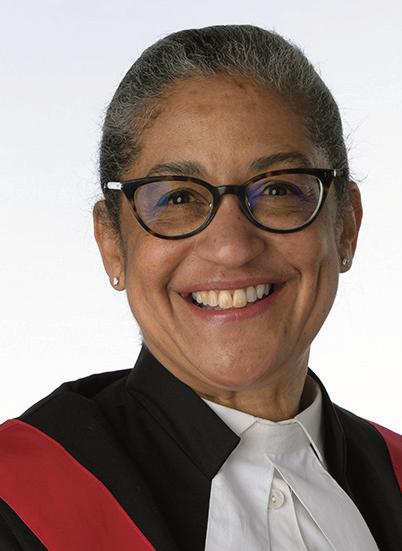
Michelle Stanford is compassionate, intelligent, funny, loyal, fearless and humble. The intense love and respect her friends and family have for her is evidenced by the vast volume of material they enthusiastically shared with us, much of which could not make it into this profile.
Michelle was born in East Vancouver, where she and her younger brother, Jeff, were raised by their mother, Sheila. Sheila was a strong, independent woman, instilling in Michelle a solid work ethic and a lifelong passion to help those less privileged than herself.
Michelle graduated from Gladstone High School and was one of the ambitious few who went on to post-secondary education. She received her diploma of nursing in 1983 and her bachelor’s degree in nursing (cum laude) in 1988. Michelle worked at Vancouver General Hospital as a general duty nurse and head nurse, and then moved to G.F. Strong Rehabilitation Centre. On the side, she was a BC Lions cheerleader, and managed to throw in a bit of modelling and acting. Nobody could say Michelle did not know how to have fun!
In 1990, Michelle got a taste of law when she worked as a nurse consultant for the law firm McAlpine & Hordo. But it was when she met Shelley Nitikman (who later became a master) that Michelle was inspired to become a lawyer. Shelley was the first female lawyer Michelle had met, inspiring Michelle’s strong interest in mentoring.
Michelle began law school at Dalhousie in 1992, transferring in her second year to UVic.
Michelle arrived at UVic Law in her red convertible sports car and with her trademark smile. She was accepted into the second-year class with open arms. Michelle’s sense of humour endeared her to her classmates. She remains friends with many of them today.
Michelle began her legal career in Vancouver with Schroeder Pigeon McNeil McLean Bluman Berry & McCabe.1 Combining her keen intellect and strong work ethic with her super power of being able to decipher clinical record entries without breaking a sweat, Michelle started to develop her niche in personal injury litigation. However, life took a sudden turn. After only a few short years, Michelle relocated to Kamloops with her husband, leaving behind her Vancouver family to start anew.
Michelle made quite the splash before her exit to Kamloops. Her longtime friend Beverli Barnes, a fashion designer who credits Michelle with encouraging her to open up a legal attire business, needed a powerful marketing campaign to capture the attention of the more fashion-forward members of the profession. In a not-so-subtle nod to our former prime minister Kim Campbell, the campaign featured a scandalous photograph depicting a smiling, bare-shouldered Michelle hiding behind a set of lawyers’ robes, with the caption “Is It Legal?”2 The picture was published in the Advocate, and it would not be a stretch to say that it was one of its most talked-about editions.
Arriving in Kamloops in the same red sports car and with the same engaging smile, Michelle rose to the challenge in her new community. Michelle was acutely aware that as a biracial woman, she might face challenges building a legal practice in the Interior. In typical Stanford style, Michelle boldly put a photograph of herself in all her newspaper ads. A strong believer in the client’s right to make an informed decision, Michelle wanted potential clients to decide before they met her whether her race would be an issue for them. Needless to say, Michelle had nothing to worry about. She soon built up a bustling law practice.
Michelle’s practice focused on criminal law and administrative law under the B.C. Review Board and the Mental Health Act. She dealt largely with disenfranchised people, who often lived in poverty with multiple barriers including mental illness and addiction. Many judges reported breathing a sigh of relief when Michelle walked into the courtroom to represent these
vulnerable individuals. She represented them with compassion and passion. She was their fierce advocate in court, and also quietly helped them attain stability in the community, even arranging for transportation and other things out of her own pocket.
Michelle involved herself early with the community, including the Kamloops Bar Association (“KBA”), eventually becoming its president. She made fast and lifelong friends wherever she went. Whether she was hosting her famous martini parties, organizing a fundraising gala for the KBA, fundraising for the Kamloops Art Gallery (she was chair of the board), hosting bench and bar barbeques at her home (persisting even after the power went out!), or whipping together dinner for friends on a moment’s notice, her friends often wondered when she had time to sleep!
Whatever the event, Michelle’s infectious laughter and tremendous sense of fun would always fill the room. A “curator of life”, Michelle loves to decorate her home and create comfortable spaces, and source interesting foods, music and recipes, to bring joy to her life and the lives of people around her. She has a passion for travel, food and art. Any road trip with Michelle involves a cooler filled with snacks and beverages!
In 2016, Michelle was elected as a bencher. Her effectiveness quickly led to leadership positions, including on the executive and credentials committees. She was instrumental as the vice chair of the Law Society’s mental health task force in developing a proposal for an alternate discipline process for lawyers experiencing mental health issues.
Kamloops and Yale County benefitted greatly from Michelle’s five years as bencher. Making the Kamloops courthouse library her second home, she regularly met there with articling students and lawyers. She and the library team worked hard to develop programs and resources that continue to this day, including the Bencher Lunch and Learn, the Kamloops area practice list and an expanded Inns of Court program. Although her friends in the library miss her constant presence, they are reminded of her not only through the programs she developed, but also by her beautiful clothing that remains hanging behind the door and the “Stanford snacks” that remain stashed in the cupboard of her honorary library office (a.k.a. the storage room!).
Michelle was on the board of governors of Thomson Rivers University and volunteered many hours in support of the new law school, including as a guest lecturer, moot court judge, mentor to students and supervisor of students working in the pro bono clinic. She worked with professor Ruby Dhand and others in developing a proposal for a mental health court in Kamloops. Michelle was one of the driving forces behind this initiative, collaborating with doctors at Interior Health in support of the project.
Michelle was supportive of the TRU Black Students’ Association and the Federation of Asian Canadian Lawyers. She would host women in the law events in Kamloops and invite all the women from the law school to join and meet local lawyers. The Kamloops Women Lawyers Forum had its genesis at her kitchen table.
In 2018, Michelle was appointed Queen’s Counsel, which occasioned another, less racy advertisement for “Is It Legal?”
Michelle’s marriage ended not long after moving to Kamloops. Those early years were filled with further tragedy, when her beloved brother Jeff died tragically in a car accident in September 1997. Her mother passed away five months later. It is a sign of Michelle’s resilience that she somehow found the strength to move forward and flourish.
Michelle gave birth to her two children, Moira and Kieran, during the early years of her practice. Michelle embraced her role as a mother. Her sense of duty to her clients and her love for her family meant that Moira and Kieran had her full attention during the day, and her law practice had her full attention during the night.
Michelle met her partner Stephen Faraday in 2010 when her children were still in elementary school. He describes being stunned by her “electric” presence and effervescent personality. After weeks of admiring her from afar, Steve finally mustered up the courage to ask Michelle out on a date. As it turns out, the only day they were both free was Valentine’s Day. The rest, as they say, is history.
According to Stephen, “Stanford made it clear that her kids and career came first. I was permitted to come along for the ride.” Her number one focus was and is Kieran and Moira. Everything else was organized, sometimes with difficulty and even willful blindness, around them. She would never let them down.
When the clash between her children’s needs and work could not be avoided, the family would adjust. While Michelle would peruse law books in the library, the kids would do their homework and be entertained by the law librarian, who always made sure to have a few treats on hand for them. No doubt Moira and Kieran’s love of learning was shaped in those early years. It was also not unusual to find Moira and Kieran sitting in on the odd board meeting while Michelle attended to one of her many volunteer activities. Rumour has it that to make up for the boring board meetings, Michelle would sometimes dust off her pom poms and reward the kids with a good old BC Lions cheer.
Just as her mother had done for her, Michelle instilled a sense of community responsibility in her children. One example is the “Spirit Tree”. Michelle would collect soaps and toiletries from hotel rooms all year long
then recruit friends, neighbours and anybody willing to contribute other items like socks and mitts. Michelle and her family would wrap hundreds of items, and then sneak out to the Spirit Tree, a pine tree in Kamloops where many homeless people were known to congregate. They would decorate the tree and carefully put the presents underneath. Two days later they would return to clean up the aftermath.
Michelle’s success as a mother is exemplified in her exceptional children, who are both graduating with their university degrees this year.
Michelle’s compassion is also seen in the relationship she had with her kind and loving stepfather, Mike. After her mother died in 1998, Michelle came back to Vancouver regularly to ensure that her children spent time with their grandfather Mike, and to help care for him until the end of his life.
Fortunately for Michelle, she has a solid relationship with her natural father, Chuck, who grew up on the mean streets of Baltimore, and continues to live in the United States. She counts her stepmother, Sue, and her siblings, Charlene, Cheryl, and Chuck Jr., as well as all her nieces and nephews, as part of her loving family. Every year around the July 4 weekend, the whole Stanford clan gathers for a raucous, loud party filled with laughter.
It is easy to see how Michelle’s skills and passion translate into her new career as a judge.
Michelle is a great listener and communicator. She understands access to justice issues, including barriers arising from racism, poverty and mental health issues. Growing up in a tough working-class neighbourhood, Michelle acquired a deep understanding of people from all walks of life. As a lecturer, Michelle spoke of the nuances of the law and presented issues from both perspectives. Professor Dhand describes her as brilliant, with an amazing analytical approach and great writing skills.
Michelle, like many counsel in Kamloops, admired how Judge Bill Blair (now retired) connected with litigants. He would roll his chair over to the prisoner’s dock and speak directly to the person he was about to sentence or detain, with genuine respect and empathy. Michelle often spoke of wanting to be that kind of judge—someone who listened, treated everyone fairly and respectfully, and made them feel that they had truly been heard. Michelle, who was appointed to the B.C. Provincial Court last year, has already demonstrated that she is exactly that kind of judge.
1. It is unclear whether Michelle’s powers of persuasion had anything to do with the firm’s later shortening its name (mercifully) to Schroeder & Company.
2. Readers of a certain vintage will remember the kerfuffle caused by the publication of the 1990 Barbara
Woodley photograph showing what appears to be a naked and smiling Kim Campbell standing behind a set of lawyer’s robes that she is holding toward the camera.

On April 18, 2022, Rory Krentz was appointed as a master of the Supreme Court of British Columbia, assigned to sit in Abbotsford.

Rory was born on April 7, 1956 in New Westminster. He was the second child of William (Bill) and Winifred (Winnie) Krentz. His only sibling, Heather, was three years old at the time. When Rory was five, Bill and Winnie moved the family to Langley, where they owned and operated a chicken farm. When Rory was in grade 10, the family moved to a different farm in Langley. Despite the chores, Rory seems to have enjoyed his years on the farm, as evidenced by his countless tales of youthful shenanigans, which inevitably came up at his firm’s staff meetings and gatherings. His experiences are likely at least partially responsible for his unrelenting work ethic. While still in high school, Rory went to work at a sawmill in Langley, and during university he worked for BC Ferries, earning enough to pay his own way through university. He brought this work ethic to the practice of law. Most people start to slow down at this point in their career, but not Rory. At the time of his appointment, his law practice was as busy as ever.
Upon his high school graduation in 1974, Rory began his post-secondary studies at Douglas College. This is where he met his future wife, Anna, in first-year biology class. It was an amazing coincidence that while they had never met before, they grew up living on the same street with many common friends; their paths had nonetheless never crossed because they were in different school catchment areas. Those of us who know Rory and Anna suspect that Rory was oblivious to Anna’s interest and that the more outgoing Anna had to make the first move. We do know that the relationship blos-
somed, and the couple married in 1980 in Cloverdale. As for that biology class, I am told that after all these years, Rory still has the transcript of grades from this class and likes to remind Anna from time to time that he received a slightly higher mark than she did.
Both Rory and Anna went on to transfer to UBC. Rory graduated in 1978 with a bachelor of arts degree, and he completed his law degree in 1982. Anna went on to complete her bachelor of science in nursing in 1983.
After law school, Rory returned to Langley to article at Nundal Cherrington & Easingwood (“NCE”). Rory remained at NCE upon his call to the bar in 1983 and thereafter until 1987. During these early years of practice, Rory primarily did federal Crown prosecutions, as that firm held the contract for Langley and Surrey.
In 1985, Rory and Anna had their first child, Chris. Their second child, Nicole, arrived in 1988. Rory has always been a proud, devoted family man and is always happy to talk about the many accomplishments of his children. Following in his parents’ footsteps, Chris attended UBC and graduated with a bachelor of arts degree in 2007. Like his mother, Chris is multilingual. He currently lives in Brazil, teaching English and translating documents. Nicole also attended UBC and graduated with a bachelor of science degree in 2011. She continued her education and went on to earn her Ph.D. in cell biology and genetics in 2018. Her first postdoctoral position was at Oxford University. She currently lives in California with her husband and continues her diabetes stem cell research at Stanford University.
Rory and Anna love to travel, especially to Europe. In 1983, after Rory had been called to the bar and Anna had graduated from UBC, Rory and Anna took their first trip to Europe together and spent just over two months travelling. This was the first of many trips to Europe, together and with their children, including visits to Nicole while she was working at Oxford. Rory and Nicole enjoy doing jigsaw puzzles, especially ones that show foreign places Rory has visited. Many of these assembled puzzles were framed and hung in his office and reflected two of his passions: spending time with family and travel.
In 1987, Rory started his own practice in Abbotsford, sharing office space with Ed Fast (with whom he went to law school). He practised mostly criminal law, including ad hoc Crown work. He later shared office space with Erwin Golke (a high school friend) and spent two years as an associate with Rosborough & Company. In 1995, he began an association with Karen Hedman, eventually forming the partnership of Krentz & Hedman, practising primarily in family law. Rory acted as a certified mediator for many years in addition to his litigation practice.
Rory is a huge soccer fan. He has been a proud Whitecaps season ticket holder for many years, and it was certainly not unusual to pass by his office and see a game on his computer screen. Rory played soccer at university, including for the law school team. During law school, his team went to Edmonton for a tournament. Upon further investigation as to what happened during the trip, I was told the situation met (as geographically adapted) the criteria of the old adage “What happens in Vegas, stays in Vegas”. Rory continued to play soccer until age 55, when his body could take no more. He was involved in soccer associations both as a coach and as a referee. He also enjoyed playing slow-pitch, skiing, camping and fishing. He continues to cycle with Anna when time permits.
As a family lawyer, Rory earned a reputation as a skilled litigator with an impressive knowledge of the rules of court and current case law. He was well liked by fellow members of the bar, who could always count on Rory to be fair and ethical. His good nature and calm demeanour made him a pleasure to be around both in the office and in the courtroom. He pursued his legal career with the passion, vigour and enthusiasm of a junior lawyer. His commitment to his career did not stop him, however, from taking a oneyear sabbatical while his children were still in school so that Anna could return to university. This is one of many examples when Rory put the needs of his family ahead of his own, and of his constant support of the women in his life to pursue their own dreams and be successful. Rory is a person of honesty and integrity, who was trusted, admired and respected by his colleagues, employees and business partners.
Rory’s appointment is welcomed by the bar and long overdue.
Looking for a lawyer to share offices on the sixth floor.
one parking space thrown in with
current lease.

Office is spacious and comes furnished or
The lobby and common areas are furnished.
is one secretarial station for the office
the possibility of second.
Space includes kitchen, internet wall jacks, photocopier and work room.
room is located elsewhere in the building.
enough

Dear Editor, Re: “From Our Back Pages” (2022) 80 Advocate 135, reprinting Richard H. Vogel, Q.C., “A Report from Your Correspondent in London: Inside the Constitutional Uproar 1980-82” (2012) 70 Advocate 27
In this piece, the distinguished Richard H. Vogel, Q.C., gives a fascinating and unique account of events—as only he knew them— leading to the passage of the Constitution Act, 1982. This supplements the several works by participants and scholars dealing with these events, including one to which I shall refer, Canada’s Constitutional Revolution, by the Honourable Barry Strayer, a central federal figure.
In all this scholarship, however, I have yet to encounter any discussion of procedural options that were considered to create a Canadian-made constitution not depen-

dent on originating U.K. legislation. The only avenue, it seems, was to persuade the U.K. Parliament, colonial cap in hand, that our cause and process were just and appropriate. This approach seems not to have been questioned. The effort succeeded, but at the price of leaving a permanent shrivelled but unsevered umbilical cord to the United Kingdom. This result is reflected in the Charter’s citation: “ Canadian Charter of Rights and Freedoms, Part I of the Constitution Act, 1982, being Schedule B to the Canada Act 1982 (U.K.), 1982, c. 11” (“B” because “A” is devoted to the French version of the Canada Act, U.K. statutes being in English only. Chapter 11, by the way, is bookended by c. 10, the Industrial Training Act 1982 , and c. 12, the Travel Concessions (London) Act 1982). This citation unembarrassedly forms the first footnote

to the introduction to Mr. Strayer’s book. This embarrassment is forever. One wonders what Pierre Trudeau would have said had he known this would be the result, as he likely did not.
I raised this issue in an article in LawNow magazine’s issue on the 150th anniversary of Confederation in 2017 titled “Free of the Colonial Yoke? Not Quite!” I posed a Jeopardy clue: “The constitution of this 150year-old country exists as ‘Schedule B’ to an ordinary statute of another country. Correct response: ‘What is Canada?’” My only known ally in this quixotic endeavour was sometime Ulster Unionist MP Enoch Powell of anti-immigrant fame. As Mr. Strayer reports, Powell found it “paradoxical” for Canada to ask Westminster to abdicate its constitutional power, yet to exercise it to effect major change. Powell’s suggestion was an “internal compact”, in which—U.S.-style—we would, I gather, have unilaterally abrogated any U.K. control over our constitution. Mr. Strayer’s response is very Canadian: We do not go against established order, and we go the “only way our existing laws will recognize.”
At his book release in Ottawa, I asked Mr. Strayer if any procedure less dependent on the U.K. Parliament had been considered. His response was somewhat curt, and less than illuminating (though he extended “warm regards” in signing my copy).
While the words were never uttered, the lurking idea of a unilateral declaration of independence would have been inconsistent with the rule of law. Such declarations typically occur in a hostile context: United States of America, 1776; Ireland, 1919; Rhodesia, 1965. International recognition could be problematic, dependent on circumstances, yet the International Court of Justice has said that international law contains no “prohibition on declarations of independence”. But a publicly friendly constitutional divorce would have precluded these problems. There seems to have been no thought of a more co-equal, negotiated approach. Perhaps statutes could have passed by prior agreement simultaneously in Ottawa and London, one simply declaring that Canada will no longer be bound by imperial constitutional powers; the other, in Westminster, acknowledging and accepting this state of affairs. A Supreme Court reference on the legality of such a proposed procedure might have been a good first step; the court’s imprimatur would ensure that whatever was proposed would survive. A friendly but distinct break with the imperial connection would have produced a truly made-in-Canada constitution. No other constitutional connection need have been disrupted.
This is only a sketch-map of a road that would doubtless have
many bumps I have not foreseen, but in my view it would have been worth exploring. We shall never know, and our constitution will forever be Schedule B to the Canada Act 1982 (U.K.), 1982, c. 11.
John Edmond OttawaDear Editor, Re: Bench and Bar (2022) 80 Advocate 627
I much enjoyed your review of the attempt by Spain, through its Armada, to conquer Britain in 1588. It was not unlike the threat Britain faced in 1941. On each occasion, Britain, inspired by legendary leaders, proved to the world it could not and would not be defeated.
Had Spain succeeded in 1588, history would have been profoundly affected. Parliament would have ceased to exist, the common law would no longer have effect and the monstrous oppression of the Inquisition would have been imposed on the island kingdom. The horrors that would have followed a successful Nazi invasion in 1941 are beyond the imagination. Elizabeth’s speech to the English fleet before the ultimate battle is comparable to Churchill’s speech on the eve of the expected invasion, where he pronounced the words that will resonate as long as the
English language is spoken: “We will fight on the beaches, we will fight on the landing grounds, we will fight on the streets and in the hills … We will never surrender.”
Both speeches from these great wartime leaders will forever inspire free people in their resistance to tyranny. And isn’t Zelensky doing a magnificent job of furthering the cause of resistance to aggression? He is pleading to the West, as Churchill appealed to America: “Give us the tools and we will finish the job.”
I have a small quibble with your quote from Elizabeth in that you omitted a vital phrase. To repeat your quote with the omitted words emphasized: “I know I have the body of a weak and feeble woman, but I have the heart and stomach of a king, and of a king of England too Should any prince of Europe dare to invade the borders of my realm … I myself will take up arms … ”.
When a PBS series on Elizabeth portrayed this speech some years ago, the troops rallied to the words—“ and of a king of England too”—more than any other part of the speech, which I can imagine was the way the actual event occurred. It is certainly the phrase that continues to ring in my ears.
Yours truly, Barry Kirkham, Q.C. West Vancouver
to join a
large full-service law firm in Victoria (Shoal Point, at Fisherman’s Wharf)

Position Responsibilities Include:
• General corporate and commercial legal services;
• Shareholder, partnership and joint venture agreements;
• Purchase and sale of businesses;
• Service and supply contracts;
• Real estate acquisitions, dispositions, financing, construction, development and leasing; and
• Personal wealth and estate planning.
Requirements:
• LL.B. or J.D. degree (or equivalent);
• A minimum of 5 years’ experience in corporate and commercial law with corresponding ability to work without supervision;
• Superior research, analytical and drafting skills and business acumen;
• Project and business management; and
• Member in good standing with the Law Society of British Columbia.
There is a significant volume of work available. Full benefits package available.
Position Responsibilities Include:
• Draft and review pleadings, briefs of argument, lists of documents and correspondence;
• Research legal and factual issues and prepare memoranda on same;
• Attend as counsel, independently and as ’second chair’, in judicial and administrative proceedings, including those before the BC Supreme Court, Provincial Court (Small Claims), Human Rights Tribunal, Residential Tenancy Branch, WorkSafe BC, and local government panels and bodies;
• Negotiate and draft settlement agreements, releases, indemnities, etc.;
• Liaise with supervising or senior counsel and clients on matters in which you are the junior counsel; and
• Work collaboratively and professionally with our non-lawyer staff.
Requirements:
• LL.B. or J.D. degree (or equivalent);
• A minimum of 5 years’ experience in litigation with corresponding ability to work without supervision;
• Superior research, analytical and drafting skills and business acumen;
• Project and business management; and
• Member in good standing with the Law Society of British Columbia.
Production based compensation. Full benefits package available.
Please email resume and cover letter to the attention of:
Kevin Benn
Office Manager
Pearlman Lindholm
#201-19 Dallas Road
Victoria, BC, V8V 5A6
Email: kbenn@pearlmanlindholm.com
Telephone: (250) 388-4433, Ext. 251


This busy practice has been in operation for over 50 years. The present practice mix is RE (including Municipal/Expropriation), Corp/Comm, Wills/Estates, Family Law and Litigation. The sellers have excellent reputations individually and as a firm, and are prepared to assist the buyer with a transition plan that ensures client retention.
This long-established practice would suit a firm wishing to expand to the Tri-Cities area, or a local resident wishing to avoid the commute downtown. Real Estate forms 60% of this practice with the remainder evenly split between Wills/Estates and Corporate/Commercial. The practice is presently turning away work so there is lots of room for expansion.
Over 20 years’ in operation with a mix of Real Estate, Wills/Estates, Family Law and Civil Litigation. Solid and consistent billings. Seller is flexible about transition and willing to mentor a junior lawyer with at least five years' experience.
CENTRAL ALBERTA GENERAL PRACTICE
This practice started 100 years ago and is located in the historic downtown core of this Central Alberta city. Practice mix is about 50% RE, Wills/Estates and Corporate/Commercial; the remainder is Family law/litigation as well as Commercial litigation. Billings are in the high six figures. The practice boasts fantastic staff and the premises have space for a second lawyer.
2 lawyer practice established in 1984. Consistently billing 8-900K. 70% Solicitor’s work and 30% Family/General Litigation. Trained staff and congenial sellers who are willing to mentor incoming lawyer(s).

Richard II’s invasion of Scotland in July 1385 brought together knights from across England as part of a 14,000-strong army. The attention of Yorkshire’s Sir Richard Scrope, who was the first Baron Scrope of Bolton and a former Lord Chancellor, was caught by the coat of arms displayed by Cheshire’s Sir Robert Grosvenor, which looked the same as Scrope’s: a diagonal gold band across a blue background (“azure, a bend or”).
Scrope protested. Grosvenor defended his family’s right to those arms, saying they had been borne by Sir Gilbert Grosvenor (to whom the Grosvenor family still traces its origins2) when he came to England at the time of the Norman Conquest.

The Duke of Gloucester, who was the Lord High Constable of England and Richard II’s uncle, ordered all those interested to appear before the Court of Chivalry in August 1385, at Newcastle-on-Tyne. Scrope and Grosvenor stated their cases and proceedings were then adjourned to Westminster.

Those proceedings unfolded “slowly” until July 1386, when the Constable ordered that evidence be taken at various locations outside Westminster. Ultimately, over the next three years, depositions were taken from around 400 witnesses who appeared before numerous appointed commissioners. (Yes, the mega trial is not of recent origin.) The witnesses included Richard II’s uncle, John of Gaunt; John’s son, who later became Henry IV; Owain Glyndw
r, the last Welsh-born Prince of Wales, who later battled against Henry IV for Welsh independence; the poet Geoffrey Chaucer, who also had
* Ludmila B. Herbst, Q.C., is the assistant editor of the Advocate. Her pandemic-era enthusiasm for online shopping most recently led her to purchase a book about Scrope v. Grosvenor that, despite its English title, turned out, when opened, to be in Anglo-Norman French with occasional Latin. Many thanks go to colleagues at Farris LLP who gamely attempted to tackle key passages via “Google Translate”, as well as to Paul F. Herbst for his assistance in reconnoitering Annacis Island.
a military career; and even various centenarians. The witnesses were asked where and when they had seen the contested arms displayed and by whom. Chaucer’s evidence—atypical only insofar as he admitted that both sides might have some connection to the arms at issue—was set out as follows in a 19th-century compilation of the evidence:
GEOFFREY CHAUCER, Esquire, of the age of forty and upwards, armed twenty-seven years, being asked whether the arms, Azure, a bend Or, belonged to Sir Richard Scrope, said yes, for he saw him so armed in France before the town of Retters, and Sir Henry Scrope armed in the same arms with a white label, and with banner; and the said Sir Richard armed in the entire arms, and so during the whole expedition, until the said Geoffrey was taken.
Being asked how he knew that the arms appertained to Sir Richard said, that he had heard old knights and esquires say that they had had continual possession of the said arms; and that he had seen them displayed on banners, glass, paintings, and vestments, and commonly called the arms of Scrope.
Being asked whether he had ever heard of any interruption or challenge made by Sir Robert Grosvenor or his ancestors, said no, but that he was once in Friday Street, London, and walking through the street, he observed a new sign hanging out with these arms thereon, and inquired ‘what inn that was that had hung out these arms of Scrope?’
And one answered him, saying, ‘They are not hung out, Sir, for the arms of Scrope, nor painted there for those arms, but they are painted and put there by a Knight of the county of Chester, called Sir Robert Grosvenor;’ and that was the first time that he ever heard speak of Sir Robert Grosvenor, or his ancestors, or of any one bearing the name of Grosvenor.3
Proceedings before the Court of Chivalry were apparently complicated and extended in part not simply because of the volume of evidence, but also because in October 1387 Grosvenor cast aspersions of some kind—he later said this was on the advice of his counsel, to improve his legal position— against Scrope’s honour.
Ultimately, in 1389, the Constable reached a decision, which is sometimes labelled as one of the world’s first intellectual property (of a sort) judgments: the decision reflected at least that by then “it was established that a man could have obtained at that time a definite right to his arms, and that this right could be enforced against another”.4
The Constable concluded that Scrope had proven the “azure, a bend or” arms were his. The Constable also ordered Grosvenor to pay the bulk of the costs of the trial. However, the Constable determined, as well, that Grosvenor could continue to use the arms as long as distinguished, in his case, by adding a plain silver bordure (a band around the edge of a shield); neither Scrope nor Grosvenor was happy with that result.
Grosvenor appealed to Richard II. Scrope was worried that Grosvenor would not prosecute the appeal expeditiously, but at least in comparison to the underlying proceedings, the outcome came fairly swiftly. In May 1390, having heard the appeal, the king determined to uphold the Constable’s decision to award the arms to Scrope as well as the Constable’s order that Grosvenor pay costs.
However, the king also determined that Grosvenor should give up even the differentiated version of the “azure, a bend or” arms that the Constable had allowed him to use. The king found that the bordure would have been sufficient differentiation had Scrope and Grosvenor been related, but not when they were strangers in the same kingdom (“Nous considerantz … q’tiel bordere nest difference sufficeant en armes entre deux etraunges & dun roialme, mes taunt soulement entre Cousyn & Cousyn priuez de sanc”).
In this, the result departed from that of an earlier dispute over “azure, a bend or” between Scrope and a squire from Cornwall, who challenged, in around 1359, Scrope’s own (slightly different) use of those arms. (The Cornish squire, named Carminow, alleged his own claim dated back to an ancestor’s use of those arms as a knight of King Arthur’s Table.) Carminow actually appears to have been believed, but the unrelated Scrope was permitted to retain the arms as well, possibly because Cornwall was still regarded as a separate realm.
Grosvenor was unable to find the funds to pay to Scrope the amount he had been ordered to pay. This led to dramatic exchanges before Richard II in his palace at Westminster in 1391. During those discussions, Grosvenor disclaimed any knowledge of the Scrope misdeeds he had alleged in 1387— as noted above, he claimed that the allegations had been made on the advice (or instigation) of counsel. Scrope asked that Grosvenor’s admission be made part of the record, and the king agreed to this condition. Thereupon “Sir Richard [Scrope] freely forgave Sir Robert [Grosvenor] the costs against him recovered, and, by command of the King, embraced him, promising his friendship”.
Having been denied “azure, a bend or”, the Grosvenor family adopted new arms (“azure, a garb or”), bearing on a blue background the golden wheatsheaf (garb5) motif that is associated with the Earls of Chester and the Grosvenors’ home country of Cheshire. Why did the Grosvenors choose these arms? One version of the story is this: Sir Gilbert Grosvenor—to whom, as noted earlier, the Grosvenors “traditionally trace their descent”— was the nephew of Hugh Lupus, who came to England with his own uncle, William the Conqueror; Hugh Lupus became the Earl of Chester after the Norman Conquest.6 While the wheatsheaf motif was not used by Hugh
Lupus himself (whose crest, appropriately enough, included a wolf’s head), “[t]he earliest appearance of the garb…in English heraldry is on the seal of [a later] Earl of Chester, [Ranulph,] who died in 1232”.7
Over the centuries that followed Sir Robert Grosvenor’s defeat in Scrope v. Grosvenor, the Grosvenor family achieved tremendous wealth and prominence. A 17th-century Grosvenor (Sir Thomas) married Mary Davies (described as the “daughter of a scrivener”8); through her, the Grosvenor family acquired enormous landholdings in the areas that became known as London’s Mayfair and Belgravia. Those are areas that the Grosvenor family developed in the 18th and 19th centuries and still in large part owns, subject to long-term leases.
In 1874, Queen Victoria named Hugh Lupus Grosvenor—whose given names served to underline the family’s claimed Norman Conquest connections—as the first Duke of Westminster.9 Reportedly this is the last dukedom created other than for a member of the royal family. Writing shortly thereafter, one author noted that the “Westminster” title chosen by Hugh “is, at all events, appropriate; for it is from within the boundaries of the fair City of Westminster that the largest portion of the princely rent-roll of the family is derived. It is often said, and generally believed, that the Duke of Westminster’s income exceeds that of any other nobleman of the age.”10
Despite the extraordinary successes that the Grosvenors achieved without these arms, the family did not forget the “azure, a bend or” with which Sir Robert Grosvenor had embarked on the invasion of Scotland and of which Richard II, ultimately, had deprived him. The magnificent thoroughbred racehorse owned by the first Duke of Westminster that won the 1880 Epsom Derby was named Bendor.11
Bendor was also the nickname given to the first Duke of Westminster’s grandson (Hugh Richard Arthur Grosvenor), born in 1879.12 Bendor became the second Duke of Westminster on his grandfather’s death in 1899. He was a remarkable character, though reportedly not without serious flaws.13 He competed in the 1908 London Olympics, in the interesting sport of motorboat racing. He set out for World War I “in a chauffeur driven Rolls Royce with a machine gun in the trunk” and at one point, “like a medieval knight leading his followers, he headed a squadron of armored cars, manned mostly by his own employees, in a dash across the Libyan desert to rescue six British prisoners”.14 He received the Distinguished Service Order for his bravery. “Matrimonially, too, … [he] lived above ordinary men”, being “four times married and three times divorced”,15 and he reportedly had a ten-year extramarital liaison with Coco Chanel. He was very kind to employees, tenants and friends. He engaged in large-scale reforestation on his Scottish estates.
By the mid-20th century, Bendor was also, reputedly, the world’s third wealthiest man.
In the late 1940s, Bendor tasked his chief agent, George Ridley, with exploring potential investments in Canada—and with persuading the British treasury to release the equivalent of up to $15 million (today worth around $185 million) to make them. Ridley had no success in finding suitable investments until, in 1951, he visited the then-secretary of the New Westminster Board of Trade, Frank Wilson. Through the window, Wilson pointed out to Ridley the hazy, flat island in the Fraser River known as Annacis Island.16 Wilson wondered aloud why it had not interested prospective purchasers and suggested it might be bought cheaply. That very day, Ridley and Wilson visited the island (by boat, as a then-planned causeway from Queensborough, across Annacis Channel, had not yet been built).
Ridley took on the mission of acquiring the island from its mix of local and English owners for the purpose of building one of the era’s new industrial estates. His mission succeeded shortly before Bendor’s death, in 1953, with Annacis Island’s acquisition. A causeway (since replaced by bridges: the Annacis Island Swing Bridge toward the east of the island and the Annacis Channel Bridge midway along the island) was built from Lulu Island and within several years, the eastern end of the immense industrial park was developed. Annacis Island was Grosvenor Group Limited’s “first significant international investment”.17
Most of the thousands of commuters who travel over and through Annacis Island on a daily basis likely do so without realizing its deeply English connections. Travelling southbound over the Annacis Channel Bridge but turning into the industrial park rather than proceeding toward the Alex Fraser Bridge, the round wheatsheaf (garb)-inspired corporate logo18 that the Grosvenor Group used until recently is visible on the “Annacis Business Park” marker. Place names on the island that have distinct Grosvenor connections include:
•Grosvenor Square, which is located toward the eastern and earliest-developed side of the Annacis Island. 1 Grosvenor Square on Annacis Island is the home of the offices of the Teamsters Union, Local 31. Grosvenor Square is also, as Anglophiles will know, the name of a square in the Grosvenor-developed Mayfair district of London. 1 Grosvenor Square in London used to be the location of the Canadian High Commission.
•Eaton Way, which is a road on the western side of Annacis Island. Eaton, in Cheshire, has been home to the Grosvenor family since the 1440s, when Ralph Grosvenor married Joan Eaton. (As an
aside, John de Eton was one of the witnesses in Scrope v. Grosvenor.) The Grosvenors’ Cheshire residence, Eaton Hall, has been rebuilt several times over the centuries.
•Belgrave Way, which runs westward from Annacis Island’s Grosvenor Square. Belgrave is a village in Cheshire, near Eaton Hall, and indeed one of the Duke of Westminster’s lesser titles is Viscount Belgrave. Belgrave in turn inspired the name of the Grosvenordeveloped Belgravia (known as “the Five Fields” during the Middle Ages) in London. Loelia, the third wife of Bendor (the second Duke
1 Grosvenor Square, Annacis Island




Willow-framed canal running through Audley Boulevard, Annacis Island

of Westminster) wrote in her memoirs that had he not been nicknamed “Bendor”, her husband would otherwise have been called “Belgrave”. Eaton Square is among the squares in Belgravia.
•Audley Boulevard, through which, on Annacis Island, runs a willow-framed canal. Hugh Audley, Mary Davies’ great-great-uncle,
acquired the land that, through her, came to form the basis for the Grosvenors’ London holdings. (Sir Robert Grosvenor had apparently also served in France in the late 1360s or early 1370s under Sir James Audley, “a lieutenant of the Black Prince”.19) In London, Audley Street (South and North) runs through Mayfair.
•Cliveden Avenue, which runs for most of the length of Annacis Island, shares its name with a stately home that the first Duke of Westminster owned in Buckinghamshire, on the border with Berkshire, in the latter part of the 1800s. He acquired it on the death of his mother-in-law, a member of the prominent Sutherland family that built the immense Italianate country house still on the site, and he sold it to the Astor family in 1893.
Today, the Grosvenor name is also evident elsewhere in Metro Vancouver beyond Annacis Island. It can be found, for example, on the Grosvenor Building on Georgia Street (built in the 1980s and home to law firms such as Hunter Litigation Chambers) and recent residential developments.20 The Grosvenor Group’s website—as well as presentation signs for its new developments—bear a stylized wheatsheaf logo that seems to have replaced, on new marketing material, the rounded version found on the Annacis Business Park marker.
And somehow it seems appropriate, given this family’s history, that the present Duke of Westminster, the seventh, is a godfather to Prince George, the eldest son of the Duke and Duchess of Cambridge.
1. This piece is woven together based on numerous fascinating sources including Charles Markham, “They’re Building a Vest-Pocket Empire on the Fraser”, Maclean’s (13 October 1956), online: <archive.macleans.ca/article/1956/10/13/theyre -building-a-vest-pocket-empire-on-the-fraser>; R Stewart-Brown, “The Scrope and Grosvenor Controversy, 1385-1391” (1938) 89 Transactions of the Historic Society of Lancashire and Cheshire 1, online: <www.medievalists.net/2009/05/the-scrope-andgrosvenor-controversy-1385-1391/>; “The ScropeGrosvenor Trial (1385-1390)”, online: <chaucer.fas. harvard.edu/pages/scrope-grosvenor-trial-13851390>; “ScropevGrosvenor”, Wikipedia, online: <en. wikipedia.org/wiki/Scrope_v_Grosvenor>; “Close Rolls, Richard II: May 1389” in HC Maxwell Lyte, ed, Calendar of Close Rolls, Richard II: Volume 3, 13851389 (London: 1921) 581, online: British History Online <www.british-history.ac.uk/cal-close-rolls/ ric2/vol3/pp581-590>; “Close Rolls, Richard II: December 1391” in HC Maxwell Lyte, ed, Calendar of Close Rolls, Richard II: Volume 4, 1389-1392 (London: 1922), 517, online: British History Online
<www.british-history.ac.uk/cal-close-rolls/ric2/ vol4/pp517-520>; Sir N Harris Nicolas, The Controversy Between Sir Richard Scrope and Sir Robert Grosvenor in the Court of Chivalry, AD MCCCLXXXV – MCCCXC (London: 1832); Zachary Garceau, “Scrope v Grosvenor”, Vita Brevis (6 May 2020), online: <vitabrevis.americanancestors.org/2020/ 05/scrope-v-grosvenor/>; “Grosvenor’s Heritage –Grosvenor’s London Estate”, online: <www.grosvenor london.com/grosvenor/our-heritage>; WHB Bird, “The Grosvenor Myth”, (1902) The Ancestor 166; Juliet Patricia Davis, “The Resilience of a London Great Estate: Urban Development, Adaptive Capacity and the Politics of Stewardship” (2018) 11 Journal of Urbanism: International Research on Placemaking and Urban Sustainability, online: <www. tandfonline.com/doi/full/10.1080/17549175.20 17.1360378>; “Hugh Grosvenor, 1st Duke of Westminster”, Wikipedia, online: <en.wikipedia.org/ wiki/Hugh_ Grosvenor,_1st_Duke_of_Westmin ster>; “Hugh Grosvenor, 2nd Duke of Westmin ster”, Wikipedia, online: <en.wikipedia.org/wiki/ Hugh_Grosvenor,_2nd_Duke_of_Westminster>
[“2nd Duke (Wikipedia)”]; “Sir Richard Scrope – 1st Baron Scrope of Bolton” (20 July 2017), online: <thehistoryjar.com/tag/sir-robert-grosvenor/>; “Grosvenor Group”, Wikipedia, online: <en. wiki pedia.org/wiki/ Grosvenor_Group#The_ Grosvenor_Estate>; “Grosvenor Square”, Wiki pedia, online: <en.wikipedia.org/wiki/Grosvenor_ Square>; “Belgravia”, Wikipedia, online: <en.wiki pedia.org/wiki/Belgravia>; “Eaton Hall, Cheshire”, Wikipedia, online: <en.wikipedia.org/wiki/Eaton _Hall,_Cheshire>; “Cliveden”, Wikipedia, online: <en.wikipedia.org/wiki/Cliveden>; Arthur Charles Fox-Davies, A Complete Guide to Heraldry (London and Edinburgh: TC & EC Jack, 1908).
2. “Grosvenor – Synopsis – British Dukedoms” [“British Dukedoms”], online: <georgepohl.typepad.com/ england_dukedoms/2015/09/-grosvenor-synop sis.html>. This lineage is somewhat disputed by some historians, even if they concede that “the family is of undoubted antiquity and distinction”: Bird, supra note 1; Stewart-Brown, supra note 1 at 11–12.
3. Also found at “Deposition of Geoffrey Chaucer, Esquire” (1386), online: <chaucer.fas.harvard.edu/ pages/deposition-geoffrey-chaucer-esquire-1386>.
4. Noel Cox, “The Law of Arms in New Zealand” [1998] ALRS 2 (1998), 18(2) New Zealand Universities Law Review 225, endnote 13, online: <classic. austlii.edu.au/au/journals/ALRS/1998/2.html#fn1
3>. The actual text of the 1389 judgment, and any reasons for judgment, appear to have been “lost”, as Nicolas laments (supra note 1), though its essence is regularly summarized.
5. Strictly speaking, “[t]hough a garb, unless quoted otherwise, is presumed to be a sheaf of wheat, the term is not so confined”: Fox-Davies, supra note 1, quoting WG Taunton, “The Tauntons of Oxford, by One of Them”.
6. “British Dukedoms”, supra note 2.
7. Fox-Davies, supra note 1. Not all historians accept this version of the story, questioning why the Grosvenors would have modelled their arms on those of later, more remote connections within the Earl of Chester line, rather than on the wolf-related crest of Hugh Lupus: Bird, supra note 1.
8. “Our History”, online: <www.grosvenor.com/aboutus/our-history>.
9. In contrast, “at present, none of the descendants bearing the Scrope surname possess any hereditary titles in England”: Garceau, supra note 1.
10. Edward Walford, “Apsley House and Park Lane” in Old and New London: Volume 4 (London, 1878), 359, online: British History Online <www.british-his tory.ac/uk/old-new-longdon/vol3/pp359-375>.
11. Another of the duke’s Derby winners (in 1886) was named—invoking either “a bend or” or “a garb or”—“Ormonde”, and a later of his contenders was “Orme”: Stewart-Brown, supra note 1 at 1.
12. Bendor Grosvenor is also the name of another, surviving member of the Grosvenor family; he is a prominent art historian and the fifth cousin of the present Duke of Westminster: <en.wikipedia.org/ wiki/Bendor_Grosvenor>.
13. See 2nd Duke (Wikipedia), supra note 1, which alleges, for example, that Bendor shared the fascist sympathies also found among certain other members of the English aristocracy in the 1930s and early 1940s.
14. Markham, supra note 1. This episode was not as lighthearted, of course, as this mid-century description might suggest, as considerable violence ensued: “2nd Duke (Wikipedia)”, supra note 1.
15. Ibid
16. The island was named after Noël François Annance, a clerk with the Hudson’s Bay Company at the time of his travels on the Fraser River in the 1820s. His adventures had earlier included distinguished service on behalf of the British in the War of 1812. However, his career prospects seem ultimately to have been thwarted by the fact he was Métis. See e.g. Michel Bouchard, “Retrieving Noel from Obscurity”, British Columbia Review (26 September 2018), online: <thebcreview.ca/2018/09/26/141-retriev ing-noel-from-obscurity/>, reviewing Jean Barman, Abenaki Daring: The Life and Writings of Noel Annance, 1792-1869 (Montreal and Kingston: McGill-Queen’s University Press, 2016).
17. “Our History”, supra note 8.
18. Sutton Young, “Logo Design for Grosvenor”, online: <www.pinterest.co.uk/pin/258394097351187157/>.
19. Stewart-Brown, supra note 1 at 16.
20. The author represented the Grosvenor Group in a hearing before the Property Assessment Appeal Board in relation to one of those residential developments, though not the one whose presentation sign is pictured on page 776 of this article.
We reprint below a letter—originally found as part of “Bench and Bar”, (1980) 38 Advocate 149—expressing some thoughts from 1916 on the ideal role and degree of involvement of legal counsel in a business enterprise.

In September 1916 H.W.A. Deterding, one of the founding fathers of the Royal Dutch Shell Company, wrote a letter to a Mr. Luykx, who was the president of the first Shell Oil Company in the U.S. The letter deals with Luykx’s retaining Messrs. Rice & Lyons, a firm of U.S. attorneys mentioned favourably in the Shell history books for their energy and initiative in acquiring oil leases and putting the company into operation in a very short time as a major producer.
13th September 1916
Dear Mr. Luykx,
I duly received yours of the 22nd ult. regarding Messrs. Rice & Lyons’ remuneration.
You gave me rather a start with your letter, because I gather from it that you employ solicitors much oftener than we would ever dream of doing.
Although we have an enormous business here, we very rarely consult lawyers. We only do so when there is really a legal difference or legal difficulty, whilst it seems to me that you employ them practically in every instance.
Lawyers are not business people, however large a lawyer’s experience may be, in the conduct of business he is absolutely useless. A lawyer placed at the head of a concern, would soon bring the business to rack and ruin. He is not a creative genius, he is able to give his opinion, if a case is laid before him, but to ask a lawyer to draw up a contract for you is a most foolish thing to do, as this is bound to lead to trouble. Our custom here is to draw up a contract before having seen the lawyer and then to ask him to put it in a more legal shape. Such a contract is more likely to embody the spirit of what has been agreed upon than one drawn up by the lawyer; to ask his opinion as to what you should do or not do is the worst possible way of conducting business, which should be kept as far as possible from the lawyers.
It seems to me from your letter as if the lawyers are a kind of department to your business. Their idea that we should be inclined to give them a fixed fee is absurd, but what astonishes me most is their proposal that you should make an arrangement by which one member of their firm should give practically his entire time to the conduct of our affairs. We would never think of such an arrangement. We do not wish a lawyer to give his entire time to our business. We have not got daily disputes, neither do we want to create them. A lawyer is absolutely unfit as a businessman, he is to give us advice if trouble arises and if you employ him, say 6 times a year, this can be considered the average maximum. I do not think we employ a lawyer many more times and our total lawyer’s bill here is considerably less than yours. Messrs. Rice & Lyons’ statement that at the present time the daily routine business of our Company consumes the time and efforts of one member of their firm, is a revelation to me. How can you conduct business in such a way! I hate to see a lawyer in our office, if I want him I go to his office and limit the conversation to the shortest possible period. Allowing a lawyer to be practically in daily touch with me, would certainly take 90% of my time which ought to be devoted to money making and not to discussing legal squabbles or legal phraseologies.
Yours sincerely, (Signed) H. W. A. Deterding
The Vancouver Bar Association is pleased to announce that the Peter S. Hyndman Mentorship Award will be awarded at this year’s Annual General Meeting.
The Peter S. Hyndman Mentorship Award is conferred each year to recognize a lawyer who is distinguished as an outstanding mentor. Peter was, himself, an exemplary mentor who made extraordinary efforts to pass on his legal skills, wisdom, ethical insights, good judgment, commitment to decorum and civility, and idealism to those who had the good fortune to work with him.
To make a nomination, kindly send a letter of not more than 500 words outlining the reasons why you consider your nominee to be a fit and proper candidate for the award, by email, to committee member Samantha Chang at <samantha.chang@dentons.com> on or before Friday, October 14, 2022. The nomination must be endorsed by five additional members, or former members, of the Law Society of British Columbia. The five endorsers are also welcome to provide additional letters of support not to exceed 250 words each.
Candidates must be British Columbia lawyers, retired lawyers or former lawyers who have been appointed to the bench or have recently gone on to careers in politics, business or other fields. Nominations of candidates from across a wide spectrum of practice experience and personal circumstances are encouraged. We hope to receive nominations for candidates of all genders in small firms and large ones; for lawyers in large, urban practices and small community ones; for lawyers who work in private practice — at private firms and in-house — and in public sector environments.
While outstanding mentorship qualities may be found alongside other qualities that can give a candidate prominence within the profession or the community at large, that prominence is not a prerequisite for the recognition that the Hyndman Award is intended to bestow. Indeed, sometimes lawyers who are excellent mentors enjoy a lower profile than others lawyers precisely because the necessarily private and “behind the scenes” character of mentorship, together with its considerable time demands, lessens the opportunities those mentors have for enhancing their personal, public profiles. We wish to ensure that lawyers from many backgrounds who dedicate great effort to bringing young lawyers along in a broad range of settings are reflected among the nominations we receive.
Candidates must be available to attend the presentation ceremony at the Vancouver Bar Association’s Annual General Meeting at 6:00 p.m. on Thursday, November 17, 2022.
















Theymademe
Chelsea Dubeau
efeellikeIwasn’tsoal
Hong PARTNER loneinthis
They made me feel like I wasnt so alone in this.
First proclaimed by the World Wildlife Fund of South Africa in 2011, World Rhino Day is celebrated on September 22 every year. The day celebrates all five species of rhinoceros: black, white, greater one-horned, Sumatran and Javan. But why limit the celebration to a single day? Some of our colleagues at bench and bar invoke the rhinoceros at any time of year—read on to find out more!
Andrea J. Piercy and Oliver C. Hanson both join Hamilton Duncan, having been at Fraser Litigation. Sergio Custodio jumps from Fasken to join Bennett Jones. Kayli Maguire takes her talents to join Bench Accounting as corporate legal counsel, leaving Lawson Lundell. Gloria M. Ng teams up with Alice Vo to start up Platform Litigation. Both were previously sole practitioners. Joining them are Stephanie Head, Austin J. Nix, Trudy C. Au and Robyn Young, all of whom forsake sole practice to do so. Chanelle C. Gilbert is now with Herald Street Law in Victoria, moving from Camas Law. Bo S.L. Carter moves to Clark Wilson from Whitelaw Twining. Dimple Kainth leaves her post as in-house counsel with Investigations, Monitoring & Enforcement at the Law Society to start up Satya Law. Robert Freedman leaves his Toronto digs at Olthuis Kleer Townshend to move west and join Gowling’s Indigenous law group in Vancouver. Tevia R.M. Jeffries is now at Farris having left Dentons.
Nathan S. Cramer is now with Edwards Kenny & Bray, having moved from MLT Aikins. Sean M. Baraich and Brandon Manhas both join DLA Piper from Cassels Brock & Blackwell. Charleen S. Sibanda leaves her post as contract counsel for the Legislative Assembly of B.C. to join Harper Grey.
Lawyers who have moved their practices should e-mail details of their past and present circumstances to Peter Roberts, Q.C., at <benchandbar@the-advocate.ca> to ensure an appearance in “Bench and Bar”. Note that we do not report changes in lawyers’ status within their firms (from associate to partner, for example) other than in cases where persons formerly articled have been hired as associates.


Aman S. Bindra is now with KSW Lawyers, having been with Fasken previously. Allison K. Sharkey moves to Clark Wilson from Norton Rose Fulbright. Renee M. Gagnon comes on board at Harper Grey from Bennett Jones. Also joining Harper Grey is April D. Wilkinson, who leaves Porter Ramsay in Kelowna. Graham R. Nattress is now at Overholt Law, having departed from the Flight Centre Travel Group as its in-house legal counsel. Matthew Cooperwilliams teams up with Richard E.K. Truman to form Cooperwilliams Truman, where they are joined by Eric Ito.
PBS helpfully explains that rhinoceroses are “odd-toed ungulates (hoofed mammals) in the family Rhinocerotidae … . The word rhinoceros comes from the Greek words rhino meaning ‘nose’ and ceros meaning ‘horn’”. It adds: “Both species of African rhinos, black and white rhinos, are the same color. They’re both brownish-gray.”
Kasandra B. Cronin, Q.C., Tamara A.D. Hodge and David Michael Ruse were all appointed judges of the Provincial Court of British Columbia. Aamna A. Afsar was appointed as a judicial justice in and for the Province of British Columbia on a part-time basis for one fixed term of ten years.
Simmi K. Sandhu was appointed chair of the Civil Resolution Tribunal of BC for a term ending June 13, 2025. Kathryn M. Campbell was reappointed as a vice chair of the Civil Resolution Tribunal for a term ending December 11, 2027.
Concurring in United States of America v. Jones, 455 F.3d 800 (7th Cir. 2006), Circuit Judge Easterbrook replaced the “pink elephant” with our featured creature: “Telling juries not to infer from the defendant’s criminal record that someone who violated the law once is likely to do so again is like telling jurors to ignore the pink rhinoceros that just sauntered into the courtroom.”
Geoffrey Plant, Q.C., Jody Wilson-Raybould, P.C., Q.C. and Maureen Maloney, Q.C. were each awarded membership in the Order of British Columbia on August 1, 2022 by Janet Austin, Lieutenant Governor of British Columbia and Chancellor of the Order of British Columbia.
In late July 2022, the Honourable Murray Rankin, Q.C., was appointed as Acting Attorney General of British Columbia following the announcement by then Attorney General David Eby, Q.C., of his intention to seek the leadership of the governing New Democratic Party.
Among the numerous law firms using a rhinoceros in their logo is Matis Baum O’Connor, in Pittsburgh, Pennsylvania. The firm’s website notes: The rhino exemplifies MBO’s attitude and approach. Rhinos are known for being strong, tough and having thick skin – all-important traits for trial attorneys. However, what is unique about the rhino is that it does not attack unless provoked, becoming a fierce and frightening defender of its territory.
According to a legend originating from Malaysia and Burma; rhinos stomp out forest fires. We see an interesting analogy between stomping out forest fires and resolving client “fires.”
We defend our clients fiercely, but we are by nature understanding and caring. As a result, we have made some lifelong friendships among our many clients.
Wikipedia reports that “[t]here are legends about rhinoceroses stamping out fire in Burma, India, and Malaysia. The mythical rhinoceros has a special name in Malay, badak api, wherein badak means rhinoceros, and api means fire. The animal would come when a fire was lit in the forest and stamp it out. There are no recent confirmations of this phenomenon. This legend was depicted in the film The Gods Must Be Crazy (1980), which shows an African rhinoceros putting out two campfires.”
The Justice Education Society recently launched its new free online help guide for the B.C. Court of Appeal. The new guide includes the new rules.
Gregory E. Atkins was appointed as a member of the board of Camosun College for a term ending July 31, 2023.
Erin Lan-Ying Frew was appointed as a member and designated as acting chair of the Property Assessment Appeal Board for a term of six months.
Recently heard in a TV movie was a manager telling an employee that the employee’s new role would start on Monday, which the employee noted was only “eight” days away.
Speaking of timing oddities, our discussion in the July “Bench and Bar” of tensions between England and Spain by the 1580s—the decade of the Spanish Armada—started (until ultimately corrected in the digital version of the magazine) with the words “By the 1880s”. Well, what are three centuries or so among friends, or indeed enemies?
Krisha Kaur Dhaliwal was reappointed to the board of Langara College for a term ending July 31, 2024.
In People v. Wesley, 533 NYS2d 643 (Co. Ct. 1988), the court explained that “[i]n 1953, James Watson, an American scientist, and Francis Crick, a British scientist, working together at Cambridge University in England, discovered the chemical and spatial structure of the DNA molecule.” That “was a ‘double helix’ in which two chains of nucleotides, running in opposite directions, are held together between pairs of bases reminiscent of the rungs of a ladder, and coiled like a spring.” The court added that “[t]he genetic code lies in the order of the bases in the DNA molecule, organized in genes. This order of bases is passed on from one generation of cells to the next and from one generation of an organism to the next. It causes a rhinoceros to give birth to a rhinoceros and not to an ant.”
Donald R. Cherry joined PLTC as an instructor in 1989. Since then, he has taught every session offered by PLTC. This past summer, Don taught his 100th class in a row. He has taught 1,935 articling students, which equates to one of every seven lawyers in the province. This fall, Don, who is not s.m.a.l.l. but tall, is taking a term off to embark on a long and well-deserved road trip. Safe travels, Don, and congratulations.
The Leeds Rhinos are a rugby club in Leeds, England. The club was formed in 1870 and was one of the clubs that in 1895 broke from the Rugby Football Union to form what is now the Rugby Football League. “Rhinos” became part of the club’s name in 1996. Ronnie the Rhino is its mascot.
Julie E. Akeroyd was appointed as a public member to the first board of the British Columbia College of Oral Health Professionals for a term ending March 31, 2025. Commencing September 1, 2022, this new college will regulate certified dental assistants, dental hygienists, dental therapists, dentists, dental technicians and denturists, taking over from the four separate colleges that formerly governed these professions.
Kenneth M. Wyllie was appointed as a member of the board of Selkirk College for a term ending July 31, 2023.
Glen G. Ewan, Q.C., was reappointed as a non-voting member to the board of the Insurance Council of British Columbia for a term ending September 30, 2025.
The law firm of Jose Orihuela, online at <www.paininthecarwreck.com>, explains the firm’s choice of rhinoceros logo (with the emphasis below in the original):
Rhinoceros are among the largest mammals in the Asian and African continents. The rhino is a symbol of strength, stability, and power. The rhino is an animal that does not seek out a conflict, but when conflict arises it does not back down!
The most recognizable trait a rhino has is its horn. The horn displays Protection, Strength, and Success. The horn, in particular, is the reason for choosing the Rhino as the symbol for the firm. These are the values that Orihuela & Associates exemplifies.
Protection, Strength, and Success are the characteristics that influenced Jose Orihuela’s decision to have the Rhino as the symbol for the firm. A Rhino does not let obstacles stand in its way and neither does Attorney Orihuela! You can expect nothing less from Mr. Orihuela and his staff at Orihuela & Associates.
The Advocates’ Society held its Spring into Summer Soirée on June 9, 2022 at the Bill Reid Gallery of Northwest Coast Art. During the course of this festive occasion, presentations were made to the 2020 and 2022 recipients of the Joe Arvay Award, Bill Morley, Q.C., and Douglas S. White Kwulastultun, Q.C., respectively. The Joe Arvay Award is presented to an advocate in British Columbia in recognition of a significant contribution to advancing a claim or an area of the law under challenging circumstances. The award recognizes meaningful achievement through resiliency.
Justice Thomas Gove was recently awarded an honorary doctorate by the Justice Institute of British Columbia in recognition his many contributions to the law, including heading the Commission of Inquiry into Child Protection, and creating the Ministry of Children and Families and the provincial children’s commissioner.
After a two-year hiatus imposed by COVID-19, the Justice System Education Program (“JSEP”) run by the Justice Education Society returns to courthouses in British Columbia. This program provides legal education to students and community groups across British Columbia to increase their legal capability and deepen their understanding of the justice system. JSEP will once again be hosting and delivering in-person legal education sessions that provide participants an ability to learn how the courts work and meet judges, lawyers, registry staff, sheriffs and other justice system participants.
In Selmon v. Hasbro Bradley, Inc., 669 F. Supp. 1267 (S.D.N.Y. 1987), the court was confronted by competing worlds of imaginary creatures including a beast that is part rhinoceros, part monkey: the Rhinokey. Clearly deriving much enjoyment from the situation, District Judge Goettel summarized the case before the court as follows:
Once upon a time, in lands far, far away, lived strange but cuddly creatures that became involved in a struggle for identity. In “Whatland,” which is just a few miles north of Fairyland, lived the “Whats.” In the “Land of Wuz” lived the “Wuzzles.” We don’t know where “Wuz” was, but we are told we could get there if we “snuzzle a Wuzzle.” It appears that for a time, never the two did meet. But one day the creators of the “Whats” discovered the “Wuzzles” and were astonished to learn that “Whats” and “Wuzzles” had certain similarities. Most specifically, it seems each “What” and “Wuzzle” had the names and characteristics of two different animals combined into one. In “Whatland,” there was “Me-ouse” (a mouse and cat combined), “Wissh” (a walrus and seal), “Chuck” (a chicken and duck), “Skeet” (a skunk and parakeet), “Pea-tur” (a peacock and turkey), “Giritch” (a giraffe and ostrich), “Leo-Lamo” (a lion and lamb), and “Beav-aire” (a beaver and bear). The “Wuzzles” included “Moosel” (a moose and seal), “Butterbear” (a butterfly and bear), “Hoppopotamus” (a rabbit and hippopotamus), “Eleroo” (an elephant and Kangaroo), “Rhinokey” (a rhinoceros and monkey), and “Bumblelion” (a bumblebee and lion).
Our story now moves to its sad conclusion. The creators of the “Whats,” who were protected by copyright, were outraged and thought that the creators of the “Wuzzles” had stolen their idea. A lawsuit broke out, with the plaintiffs, creators of the “Whats,” alleging violation of the federal copyright laws and unjust enrichment. The defendants, creators of the “Wuzzles,” have moved for summary judgment, as well as attorney’s fees and sanctions … for plaintiffs’ pursuit of allegedly frivolous and vexatious litigation.
This battle on high between creators has filtered down to us in this “What”-less and “Wuzzle”-less Land of White Plains. The questions before us are really quite simple: Just what’s a “What,” what’s the similarity between a “What” and a “Wuzzle,” and “Wuzzle” we do about it?
On defendants’ various motions, we find that:
(1) there “wuzn’t” substantial similarity between the “Whats” and the “Wuzzles,” and summary judgment on the copyright infringement claim is granted;
(2) plaintiffs’ cause of action in quasicontract “wuz” preempted by the federal copyright laws and grant defendants’ motion for summary judgment on that claim; and
(3) this action “wuzn’t” sufficiently frivolous or vexatious so as to warrant attorney’s fees or sanctions, and defendants’ motions for such are denied.
We suspect that plaintiffs’ true frustration in this case grows from a belief that corporate giants have “stolen” their idea. Not only do we find that this isn’t so and that the copyright laws do not protect the idea itself, but, with all due respect to the parties, the concept of combining two animal forms is hardly novel or unique. Pegasus, the winged horse, was a product of Greek mythology. It may not have been the first such character, and it certainly was not the last. We note, for example, the Griffin, often depicted in crests, which combines an eagle with a lion. The point, how-
ever, is that defendants have no more “stolen” plaintiffs’ idea than have plaintiffs “stolen” the idea from Greek mythology …
The CBABC held its Provincial Council meeting on June 11, 2022 and elected its board of directors for the coming year. Aleem S. Bharmal, Q.C., of the Community Legal Assistance Society, was elected president. Scott Morishita , of Rice Harbut Elliott, and Lee (Lisa) M.G. Nevens , of the Department of Justice, are first and second VPs, respectively. Judith A. Janzen with Onyx Law Group is the Finance & Audit Committee chair. Randy Robinson, Crown counsel, is the Aboriginal Lawyers Forum Representative. Dan Melnick of Cook Roberts is the Young Lawyers Representative. Elected as directors were Patricia Blair of River Valley Law, Mylene C. de Guzman of the De Guzman Law Centre, Sarah L. Klinger with the Law Office of Sarah Klinger and Adam C. Munnings of Munnings Law.
The Harry Rankin, QC Pro Bono Award was given to R. Tim V. Louis and Edward Wong. The Equality & Diversity Award was given to Ken Kramer, Q.C., and Audrey Y. Jun. The Innovation Award went to Sara Forte. The Community Supporter Award was given to Vanessa S. Werden.
One species not celebrated on World Rhino Day is the “RINO”: Republican in Name Only. This disparaging acronym is now used by the Tea Party wing of the U.S. Republican party to denigrate a Republican candidate whose political views are thought to be insufficiently conforming to the party line. The acronym is, of course, a misspelling of the abbreviation “rhino”. Properly spelled, perhaps this acronym has a life in current U.S. political discourse to refer to Republican Hypocrites in Name Only.
Richard S. Margetts, Q.C., was reappointed as a member of the Community Care and Assisted Living Appeal Board for a term ending July 31, 2025.
Seventy-five years ago, on August 15, 1947, India gained independence from British rule.
The CBABC and the Law Society held an in-person Bench & Bar Dinner on June 16, 2022. As part of the convivial festivities, Frank A.V. Falzon, Q.C., was awarded the 2021 CLEBC Leaders in Learning Award. Also celebrated was Robert McDiarmid, Q.C., who was given the 2022 CBABC Georges A. Goyer, Q.C. Memorial Award. Lastly, the Law Society was able to finally present to Leonard Doust, Q.C., its 2020 Law Society of B.C. Award in recognition of his many and varied contributions to the profession over the course of his legal career.
Glen Johnson was appointed to the Mental Health Review Board of B.C. as a legal member.
At least one English lawyer has been among the recipients of the Diana Award. Safari Club International’s website explains: “Established in 1995, the Diana Award is named for the huntress of Roman mythology and recognizes the women of SCI who have excelled in international big game hunting. Nominees show exemplary ethics in the field, remain committed to the mission statement of SCI and personally give of their time and energies to enhance wildlife conservation and education. This award is sponsored by NRA Women’s Leadership Forum.” In 2020, English newspapers reported that the same lawyer “is one of only two living British hunters known to have the club’s ‘African Big 5’ award for shooting a lion, elephant, leopard, rhino, and cape buffalo”.
Amrik M. Narang was appointed as a member of the Abbotsford Police Board for a term ending December 31, 2023.
In Stewart v. United States, 428 F. Supp. 321 (D.D.C. 1976), the plaintiff sued under the Federal Tort Claims Act for damages resulting from an allegedly false arrest made by officers of the Federal Protective Service. The officers intercepted the plaintiff when he proceeded the wrong way down a road that gave him a shortcut to the main street. It was common practice for drivers to use the shortcut, and officers were out in force to stop it, “under the command of Captain Samuel A. Stewart, an experienced police officer of 18 years’ service who was on a plainclothes assignment and dressed in a pink jump suit without a badge”. The plaintiff was pulled over and complained, and Captain Stewart came over. A confrontation ensued, coming to the point where the plaintiff challenged the “pink jump suit wearer” (with expletives) to lock him up, and the captain arrested him for disorderly conduct, although once at the police station the charge was dropped.
District Judge Gesell noted that “Captain Stewart did not react because he had any genuine concern that plaintiff would actually leave the scene or that a breach of the peace was threatened. He reacted solely because of plaintiff’s derogatory, obscene remarks. There were no racial overtones. Plaintiff and the police officers were all black.” The judge noted that the police “are customarily vilified and harassed by some elements without apparent cause. It takes strength of character and a hide as thick as a rhinoceros to withstand the abuse heaped on police officers in some sections of this city as they go about their daily work.” In this regard, the judge added
that “the urge to come to the support of the occasional officer, such as Captain Stewart, who ‘looses his cool’ in the face of this type of harassment is very strong.” However, as “[t]he Court must leave its personal distaste for plaintiff’s conduct behind for the precedents are controlling”, the court concluded that “the disorderly arrest was without probable cause and judgment must be entered for plaintiff.”
Rhinoceros Point, an officially named location celebrating a mammal said to be the largest remaining megafauna on earth, is found on the west side of Kootenay Lake’s eastern arm. In a more abbreviated tribute, Rhino Peak can be found in the Clayquot Sound watershed at the head of the Kennedy River above Paradise Lake. When viewed from the east, a gendarme high on the ridge gives the mountain the distinct appearance of a rhino head.
William (Bill) M. Everett, Q.C., was reappointed as a commissioner of the Property Assessment Appeal Board for a term ending February 18, 2023. Each of Dale B. Pope, Q.C., Howard L. Kushner and Kenneth W. Thornicroft were reappointed as members for terms ending December 31, 2026.
In Hensley v. Ball, 380 S.W.2d 279 (1964), the Court of Appeals of Kentucky described the Internal Revenue Service as having “charged onto the scene like a mad rhinoceros” and ultimately as extracting “a settlement of its large and numerous tax claims”.
Heather E. Cochran was appointed to the Oak Bay Police Board for a term ending June 30, 2023.
Winston Sayson, Q.C., was recently granted the Kwantlen Polytechnic University’s 2022 Distinguished Alumni Award. In 2019, Mr. Sayson was given the inaugural Lawyer of Distinction Award from the Federation of Asian Canadian Lawyers (British Columbia) Society.
Darrell B. Le Houillier was reappointed as a member and designated chair of the Environmental Appeal Board, the Forest Appeals Commission and the Oil and Gas Appeal Tribunal for a term ending July 29, 2027.
The Parti Rhinoceros Party of Canada was established in 1963 and is recognized as a party by Elections Canada. Its platform promises “an almost credible alternative to voters disillusioned by traditional parties. Promising funnier lies of superior quality, our candidates are softer and more silky than any competitors’ brand.” Founded by doctor and writer Jacques Fer-
ron, the Rhinoceros Party has never elected a member to Parliament, though it keeps trying. Current election promises include “nationalizing bacon” and increasing the safety of Canadian children by legislating that “newborns’ first names must be at least 12 letters, including a capital letter, a number, and a special character.” Among the other current promises on its website is the following: “To promote carpooling, we will make sure that the brake pedal is now installed on the passenger side of all vehicles.”
The Schmidt Firm, PLLC says that it “is currently accepting claims in all 50 states for those who have been injured from a Yamaha Rhino [all-terrain vehicle] Rollover.”
Amanda R. Baron was appointed as a member of the Fraser, Interior, Northern, Provincial Health Services, Vancouver Coastal and Vancouver Island Patient Care Quality Review Boards for a term ending June 1, 2023. Jonathan M. Chapnick, and Sandra M. Staats were reappointed as members of those boards for terms ending June 1, 2023 and June 1, 2024 respectively.
Relying on the rhino as more than just a logo, RHINO Lawyers in Florida incorporates the mammals in its name. It contrasts itself to law firms “led by baby boomers who are not technologically savvy. Unfortunately, this simply will not cut it for the Millennial consumer in today’s fast-paced world. … [C]ommunication and service must be fast, reliable, trustworthy, and on their terms. Luckily, RHINO Lawyers is a forward-thinking law firm in Tampa that has been pioneering the [Amazon-like] prime experience for several years.” A “charging rhino” is on its marketing material as that is how the firm says it approaches cases: its lawyers are “tough” and want people to understand they are “aggressive”.
Megan R. Ellis, Q.C., Keith T. Kerrigan and Mary L. Macaulay were all appointed to the board of Emily Carr University of Art and Design for terms ending July 31, 2024.
Zahra Hassan Jimale was reappointed as a member and designated as a vice chair of the Property Assessment Appeal Board for a term ending October 1, 2026.
“Pellucid”: translucently clear; lucid in style or meaning; easily understood.
Kenneth K.L. Leung was appointed to the board of the Chartered Professional Accountants of British Columbia for a term ending June 3, 2023.
Noah’s Ark Zoo Farm in Bristol houses two white rhinos.
The recent flooding in Kentucky has been tragic, but coincidentally coming to our attention was a CBS story in 2019 about a replica of Noah’s Ark (“Ark Encounter”) in that state demanding its insurance company cover property damage from flooding. Alas, the Goddess of Irony would not go so far as to cause damage to the Ark itself. The flooding had caused a landslide on the attraction’s access road. The company operating the attraction was said to be called Answers in Genesis and also to operate the Creation Museum.
Rhino Legal Finance says it “can provide you with a settlement loan, while your lawyer fights to ensure you obtain a fair settlement”.
Channel News Asia reported in December 2021 that a trespassing teenager who had performed a backflip in the white rhino enclosure at the Singapore Zoo was sentenced to a year’s “reformative training” for this and various non-zoo-related transgressions0. Channel News noted:
In December 2020, he went to the zoo with his then-girlfriend. He decided to jump into the rhino enclosure, with the intention of taking a video and posting it online.
He had seen a viral video of a man riding a giraffe and thought he could take a video that would also go viral.
His girlfriend filmed him doing a backflip in the enclosure, and [he] later uploaded the clip to his public TikTok account. It drew 55,000 views by the time the zoo called the police for fear others would follow suit.
Keith E. Spencer was appointed to the board of directors for the VGH & UBC Hospital Foundation.
In British Columbia, all species of the family Rhinocerotidaeare (rhinoceros) are considered “a controlled alien species” under the Wildlife Act and regulations. That means that despite what your children may wish, it is an offence in British Columbia to possess a rhinoceros without a permit. Doing so may result in a fine of not more than $100,000 or a term of imprisonment not exceeding one year, or both, for a first offence. Possessing a rhino after a first conviction will double your jeopardy to fines of up to $200,000 and two years in jail, or both. Resist the urge to get a pet rhino, or at least seek legal advice before getting one.
Gainsberg Law, a Chicago law firm that says its members include “experienced animal bite lawyers”, segued from posting about “Patron at Cincinnati Ohio Zoo Bitten by a Baby Rhinoceros” in 2018 to “what if you’re attacked by a smaller animal – say, a family pet? Homeowners and businesses can be
held liable if animals on their property attack and injure someone. While homeowners and companies don’t (usually) have pet rhinos, many people have dogs, cats, birds, and other animals that can bite someone.” They add: “For help when an animal attacks you or anyone in your family, please use our contact form or call … to schedule a free consultation.”
In a news item that would entertain any ten-year-old, it was reported by the British tabloid press that reality TV star and social influencer Stephanie Matto earned in excess of $280,000 selling small jars of her gastric wind. While the venture was a financial hit, she was unable to sustain production after being admitted to hospital with severe gas pains.
The grandmother [sic] of public broadcasting, the BBC, was founded one hundred years ago on October 18, 1922. Comedians employed by the BBC commonly refer to the corporation as mother.
New York-based Reputation Rhino describes itself as “a leading Online Reputation Management company”. In the “Meet the Crash” portion of its website, it notes (emphasis in the original):
A Crash is the group identification name for rhinos, much like a group of birds are called a flock.
You see, a rhino can run up to 30 miles per hour, but can only see 30 feet ahead of them. So when they run, they run together, in confidence, moving forward at full speed, even if they’re not sure exactly what is in front of them.
Rhinos are intense, passionate and focused. Rhinos see where they want to go and start charging, knocking down anything that gets in their way. Rhinos get things done!
Well, that’s us. We, as a team, run together in confidence and we always move forward at full speed, knocking down anything that gets in our way.
Zoologist Perfumes notes its “fascination with animals” and that “[o]ur line of perfumes captures the idiosyncrasies of the animal kingdom and transforms them into scents that are unusual, beautiful, fun and even shocking. Our scents will reconnect you with the manifold delights of the natural world.” It describes its 2020 version of the perfume “Rhinoceros” as “a sophisticated and robust scent that makes a bold, unapologetic statement. Go forth and explore your world. Don’t ask permission.” It adds: “On the first spray of Zoologist Rhinoceros, heady notes of sweet rum and whiskey collide with mellow coffee before the scent settles into its lingering journey. Rich leather, oud and incense are carried in a cloud of smoky red tobacco along a dusty amber path, dotted with hints of patchouli and moss.”
Membership in the Order of Canada was recently awarded to James Lloyd Cassels, C.M., Q.C., and the Honourable Marion R. Buller, C.M., for their outstanding contributions to Canadian society. Mr. Cassels was recognized for his contributions as a university administrator and law scholar, and for his commitment to improving access to higher education. Judge Buller was recognized for her leadership in Indigenous rights advocacy as the first woman of a First Nation to be appointed to the Provincial Court of British Columbia.
Dulcie McCallum, British Columbia’s first female Ombudsperson, a member of Canada’s delegation to the UN to negotiate the Convention on the Rights of Persons with Disabilities and Nova Scotia’s first female Information and Privacy Commissioner, recently graduated from University of King’s College (Dalhousie) with a master of fine arts degree in creative nonfiction (May 2022). Her upcoming book, The Audacity of Inclusion, is about her life advocating for people with intellectual disabilities. This work began while articling for the late Hon. (Justice) David Vickers, who was known for his advocacy in this sector.
US Code § 5305a provides: “A person shall not sell, import, or export, or attempt to sell, import, or export, any product, item, or substance intended for human consumption or application containing, or labeled or advertised as containing, any substance derived from any species of rhinoceros or tiger.”
The Church Times reported in 2018 that “[w]hen President Trump visited Pope Francis at the Vatican last year, his gift to the Pope was a large, goldembossed boxed set of the writings of Martin Luther King”; however, “[t]he Pope could be considered fortunate. One of his predecessors, Leo X, was famously given a rhinoceros [which sadly drowned en route to the Vatican] by King Manuel I of Portugal, in 1515.”
Ryan H. Clements was appointed as a part-time member for a three-year term of the Mental Health Review Board.
The late Shona, an African black rhinoceros, was the mascot for QLD Law Group in Australia. The firm’s website noted that “Shona’s fearless ‘head’ approach was the inspiration to our team at QLD Law Group” and she “embodied the spirit of the firm with her direct, ‘no nonsense’, to the point style.”
Pawanjit Singh Joshi was appointed to the British Columbia Farm Industry Review Board for a term ending July 31, 2024.
Wendy A. King was reappointed as a member of the board of directors of the Royal British Columbia Museum for a term ending December 31, 2022. “Woolly”, a replica mammoth, is on display at the museum. The museum’s website notes that Woolly “is a replica of the largest animal to ever walk on this continent. Not everyone likes him. He has been known to frighten small children. But he’s become an iconic symbol of the museum.”
A “woolly rhinoceros” roamed the earth before becoming extinct around 14,000 years ago. In fact, there was more than one.
Allan P. Seckel, Q.C., was reappointed as a member of the board of the Insurance Corporation of British Columbia for a term ending July 31, 2024.
A dissent in the U.S. Court of Appeals for the Sixth Circuit in United States v. Beauchamp, 10-5102 (2011) was critical of what it described as “appellate factfinding” by the majority, saying that this was “a rare and exotic animal, and often seems out of place too. Its appearance warrants explanation in the manner that, say, a rhinoceros in Central Park does.” The majority protested that “there was no appellate factfinding here, only fidelity to the de novo standard of review. And it is noteworthy that our de novo analysis need no more explanation than the appearance of the dissent’s rhinoceros in Central Park, since there is a zoo in Central Park and if one went to the Central Park Zoo one could expect to see a rhino. So too, when the court conducts a de novo review, it literally looks at the totality of the circumstances ‘anew.’”
There are no native rhinoceroses in British Columbia. The closest facsimile is likely the Rhinoceros auklet, described by Audubon as “a chunky dark seabird, related to puffins”. Fifty-seven per cent of the world population of Rhinoceros auklets nest in British Columbia. About seventy-two per cent of the B.C. population (of auklets) nests on Pine and Storm Islands at the entrance to Queen Charlotte Strait. The bird’s name is derived from a hornlike extension of the beak, which is only present in breeding adults and is shed annually. The horn possesses fluorescent properties, which are thought to be involved in reproductive signalling or raves.
Susan E. Ross was appointed as an inquiry officer over the proposed expropriation subject to two notices of request for inquiry received in May and June 2022, for described land in the Cariboo District.
Smithsonian’s National Zoo explains that the rhinoceros snake, which is indigenous to northern Vietnam and southern China, is named for “the scale-covered protuberance” (the function of which is unknown) “on the tip of its snout”.
In New Balance Athletic Shoes, Inc. v. Matthews , 1992 CanLII 7013 (CA TMOB), the board was critical of a market research survey which asked a “leading” question: “What is the name of the company you associate with that trade mark?” The board noted:
Where a trade-mark includes or comprises ordinary words, it seems likely that a number of people would respond to that question by assuming that the name of the associated company incorporates the words of the trade-mark whether or not they have any knowledge of the actual company that is associated with the mark. In other words, if consumers were shown a card with the trade-mark RHINOCEROS on it and were asked the survey question, a certain number would answer “Rhinoceros” even though they had no knowledge of any specific associated company.
Thought du mois:
Love is like a Rhino, short-sighted, but always willing to find a way.
—François de La Rochefoucauld (1630–80), French author

D. Michael Bain, Q.C., is the editor of the Advocate and the proud father of one of Perry Ehrlich’s Showstoppers! alumni. From this perspective, he has witnessed firsthand the meaningful impact Perry’s philosophies and community activities have had on not only his son’s life, but also the lives of many young people in British Columbia.
Eric Kroshus is an associate at Mathews Dinsdale, where he practises employment and labour law. Eric has a J.D. from the Allard School of Law and a B.A. in neurobiology from Harvard University. He has played hockey for the Camrose Kodiaks, the Penticton Vees, the Harvard Crimson and the Wheeling Nailers. His pre-game meal is pasta and chicken followed by a peanut butter and jelly sandwich at the rink closer to game time.
Sarah Pike is a former litigator with Davis & Company, Hunter Voith and the Aboriginal Litigation group at the federal Department of Justice. She later worked in the Specific Claims Legal Services Unit of the Department of Justice on historical land claims. Since 2018, she has been a sole practitioner at Spike Law, specializing in advising lawyers and law firms with Indigenous clients and mainly in relation to British Columbia Aboriginal title litigation or specific claims. In her spare time, Sarah is a legal historian, and in 2016 she received both the Law Society of British Columbia Scholarship for Graduate Legal Studies and the UBC Allard School of Law History Project LL.M. Scholarship.
Jeffrey J. Smith was called to the bar of British Columbia in 1997 and is a past, present and (if we’re lucky) future contributor to the Advocate. He teaches in the Norman Paterson School of International Affairs at Carleton University in Ottawa and is counsel to the government-in-exile of Western Sahara (Africa’s last colony), the Saharawi Arab Democratic Republic.
The Honourable George R. Strathy retired as Chief Justice of Ontario on August 31, 2022, a position he held since 2014, a year after his appointment to the Court of Appeal for Ontario. Chief Justice Strathy received a B.A. from McGill in 1970 and an M.A. from the University of Toronto in 1971. He studied law at the University of Toronto, where he was the gold medalist in 1974. His emphasis in practice was on maritime law and transportation. He has been described as modelling the lawyer as a public servant by supporting causes for the less fortunate. He is married with five daughters and ten grandchildren.








